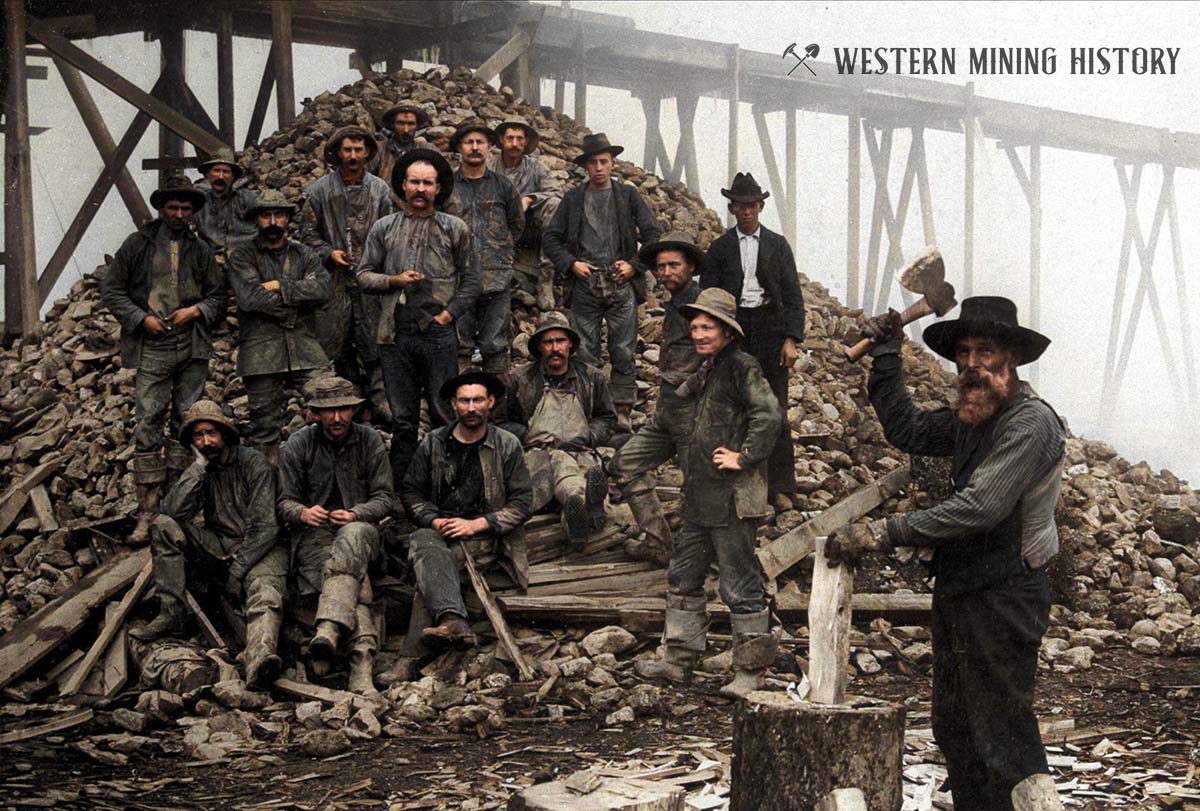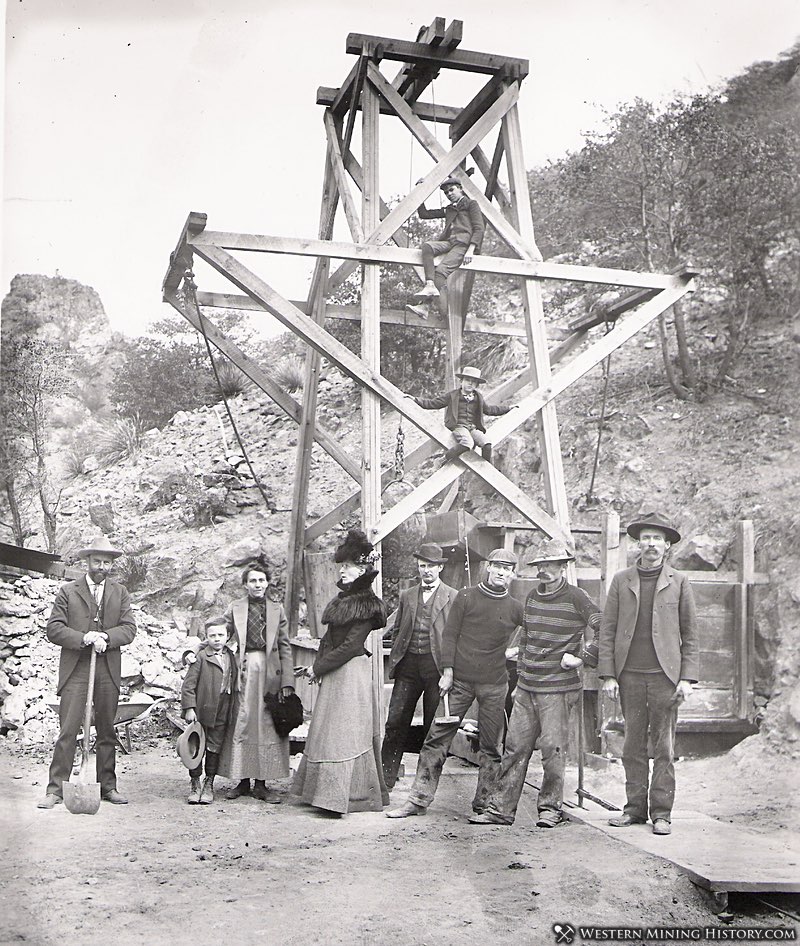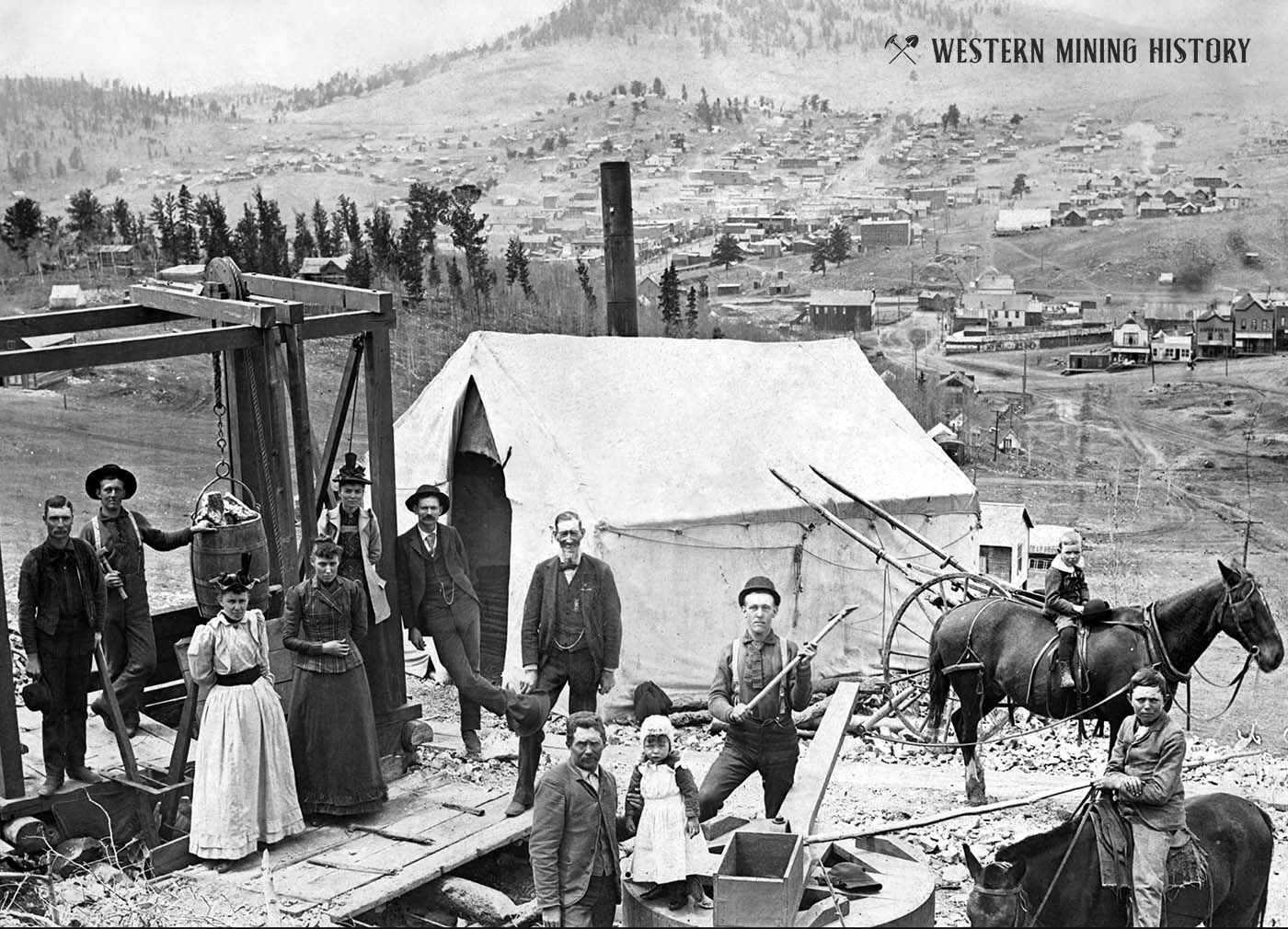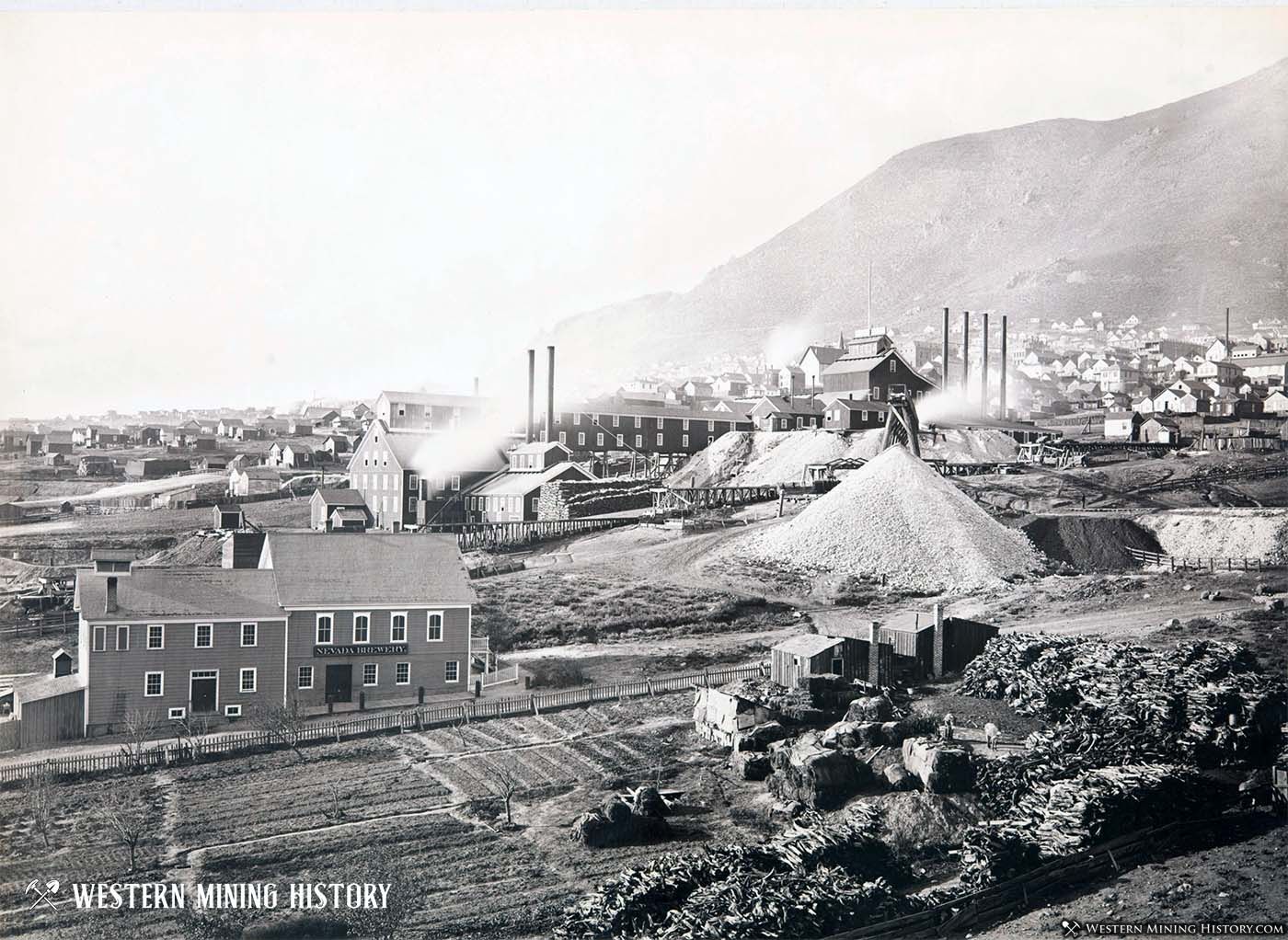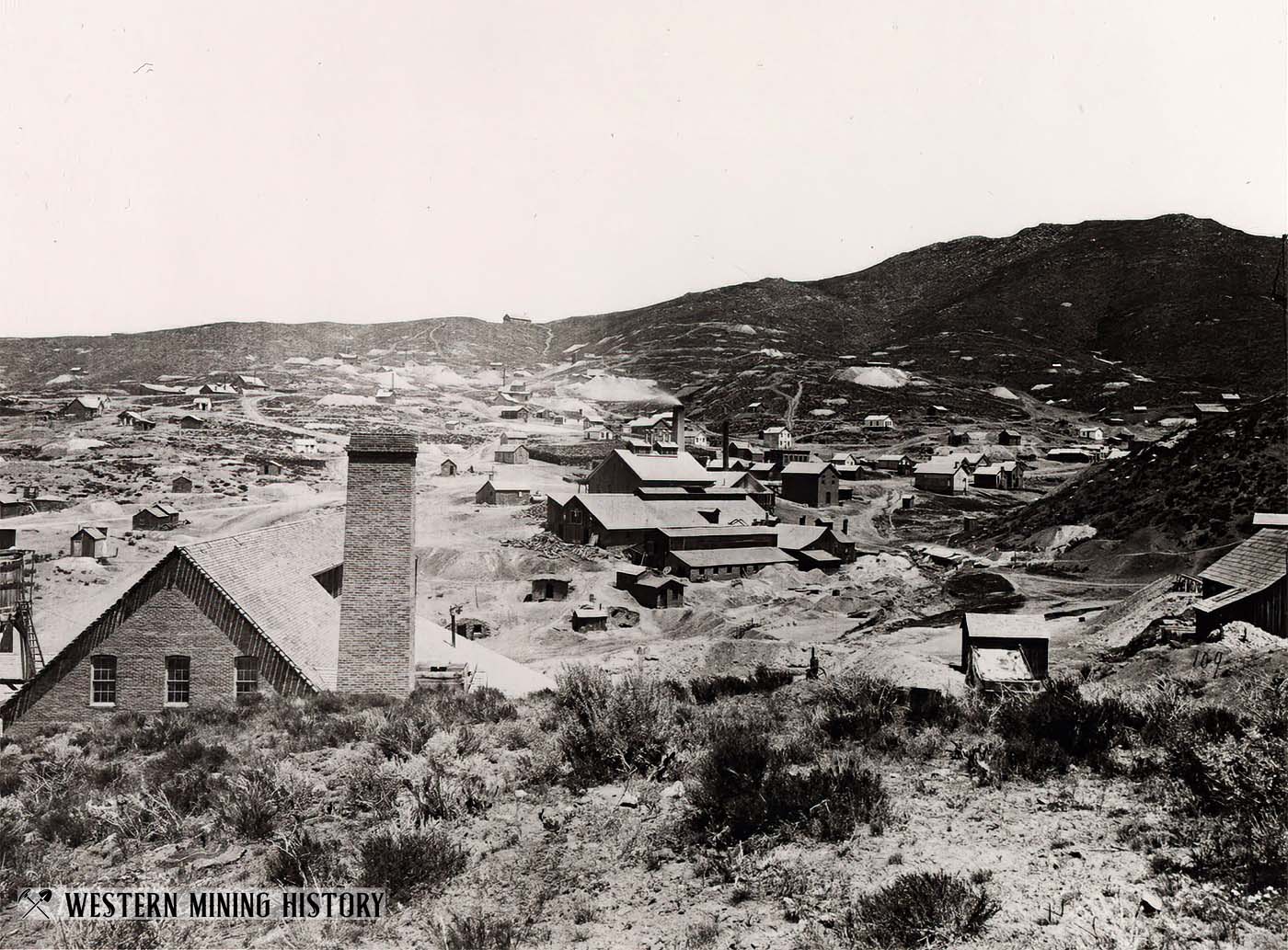Modern software is capable of adding color to historic photos with a decent amount of accuracy. While the quality of the colorized images varies, and sometimes the colors clearly miss the mark, often the results are downright stunning.
The following images are some of the best colorized photos of historic western mining scenes. Included are mines, miners, historic mining towns, and related scenes.
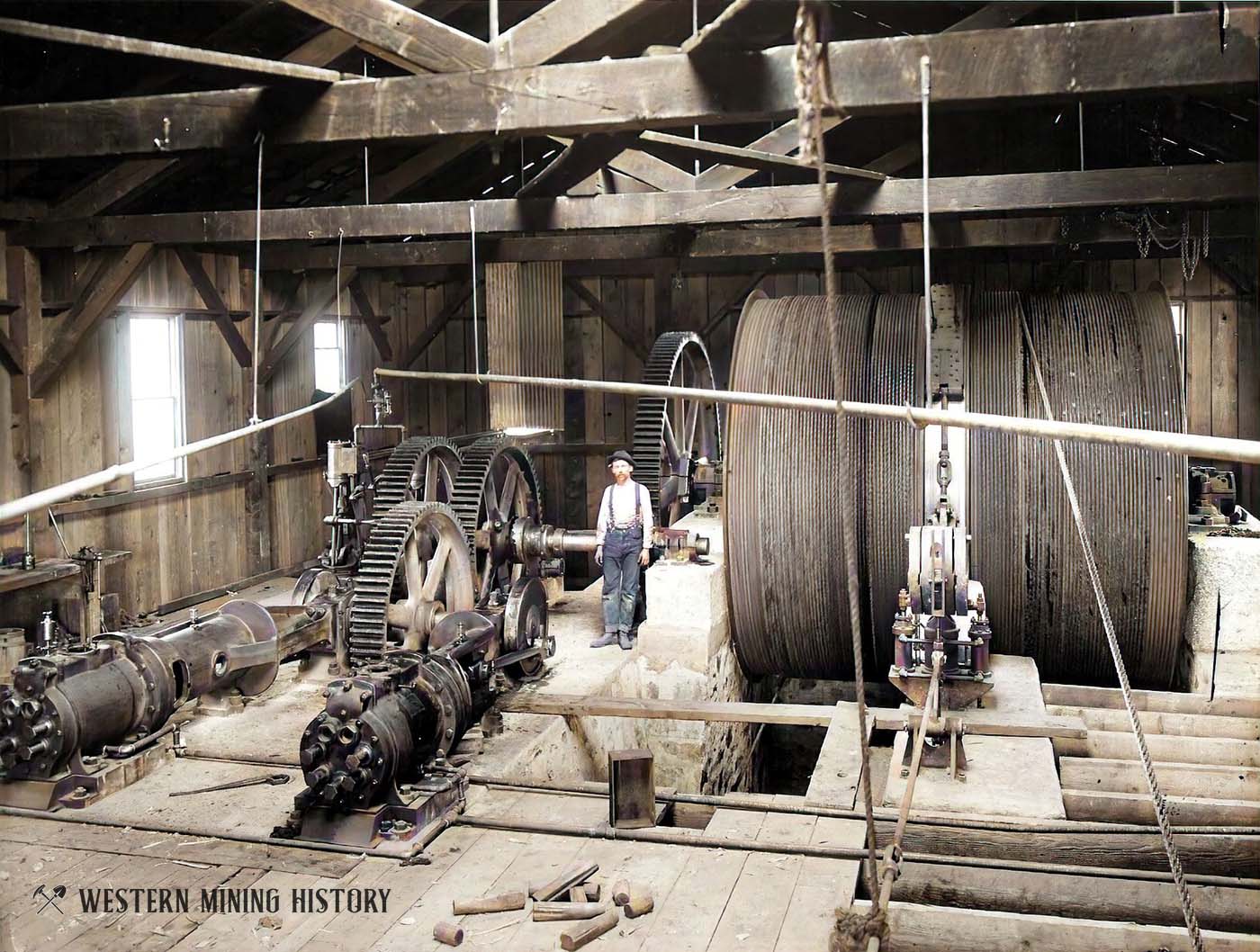
High-resolution digital copies are available of selected images from this page. See the Premium Images page for more information.
Deadwood, South Dakota
Deadwood, South Dakota grew at an incredible pace in 1876, with around 2,000 miners, businessmen, and “working“ ladies arriving by August. Deadwood had a total of 166 businesses by September. Twenty-seven of the businesses were saloons; a year later there were seventy-five.
By 1877, the rush to Deadwood only intensified. The following photos show Deadwood during the 1877 boom.
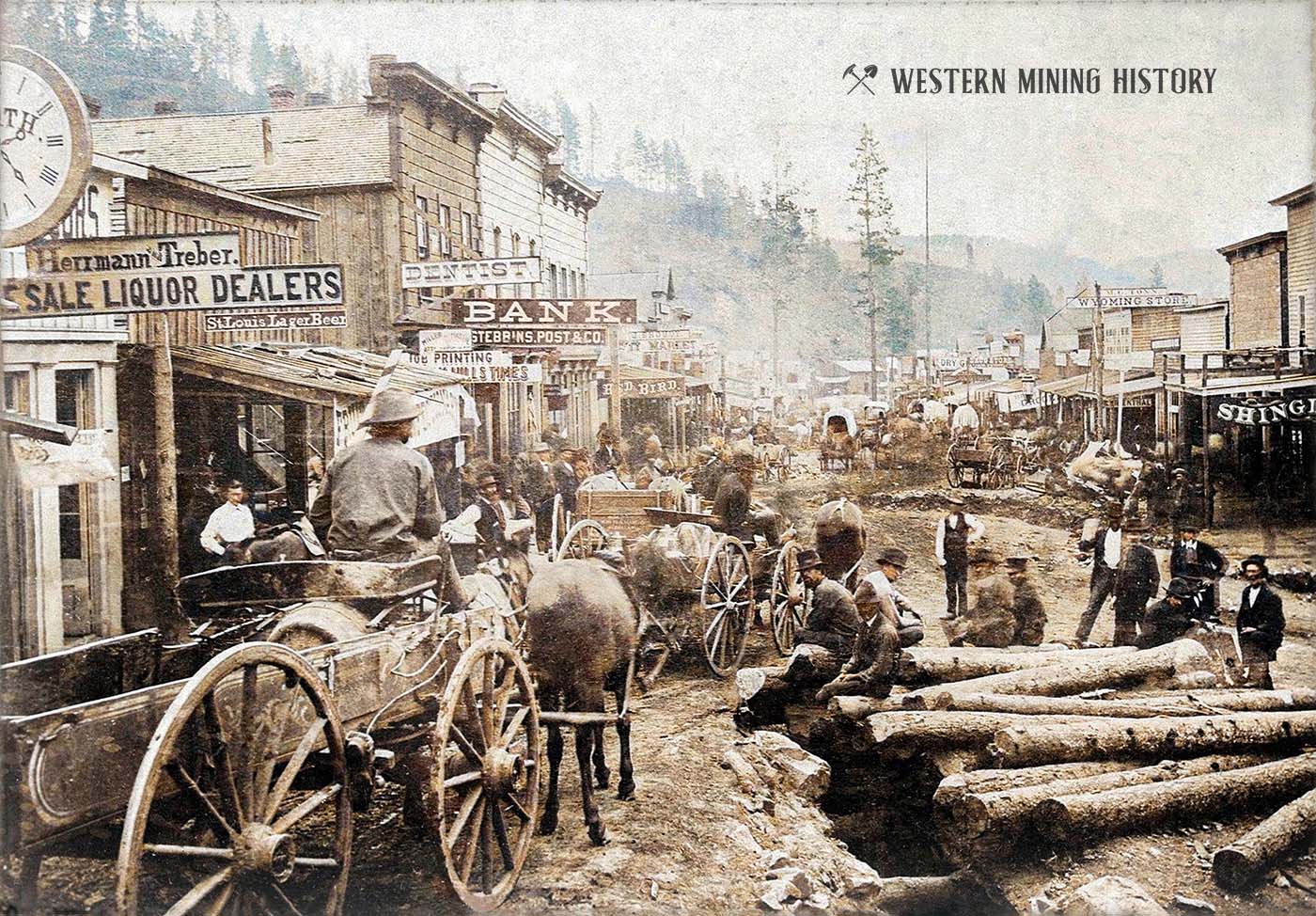
While the photo above has the abstract quality of a painting, the photo below illustrates in incredible detail what Main Street in Deadwood looked like in 1877.
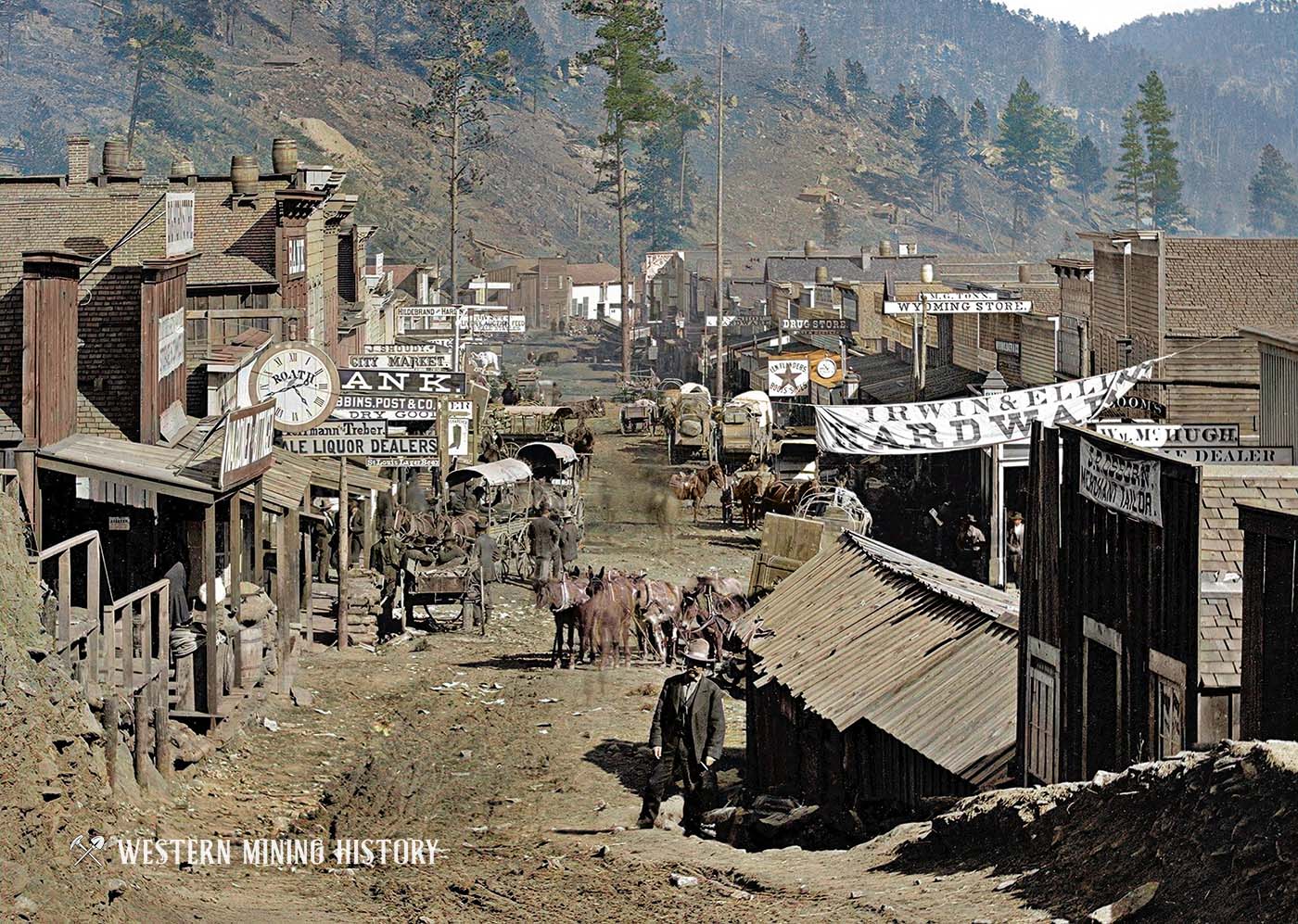
By 1877 when these photos were taken, Deadwood had evolved into one of America’s busiest, and chaotic, boom towns.
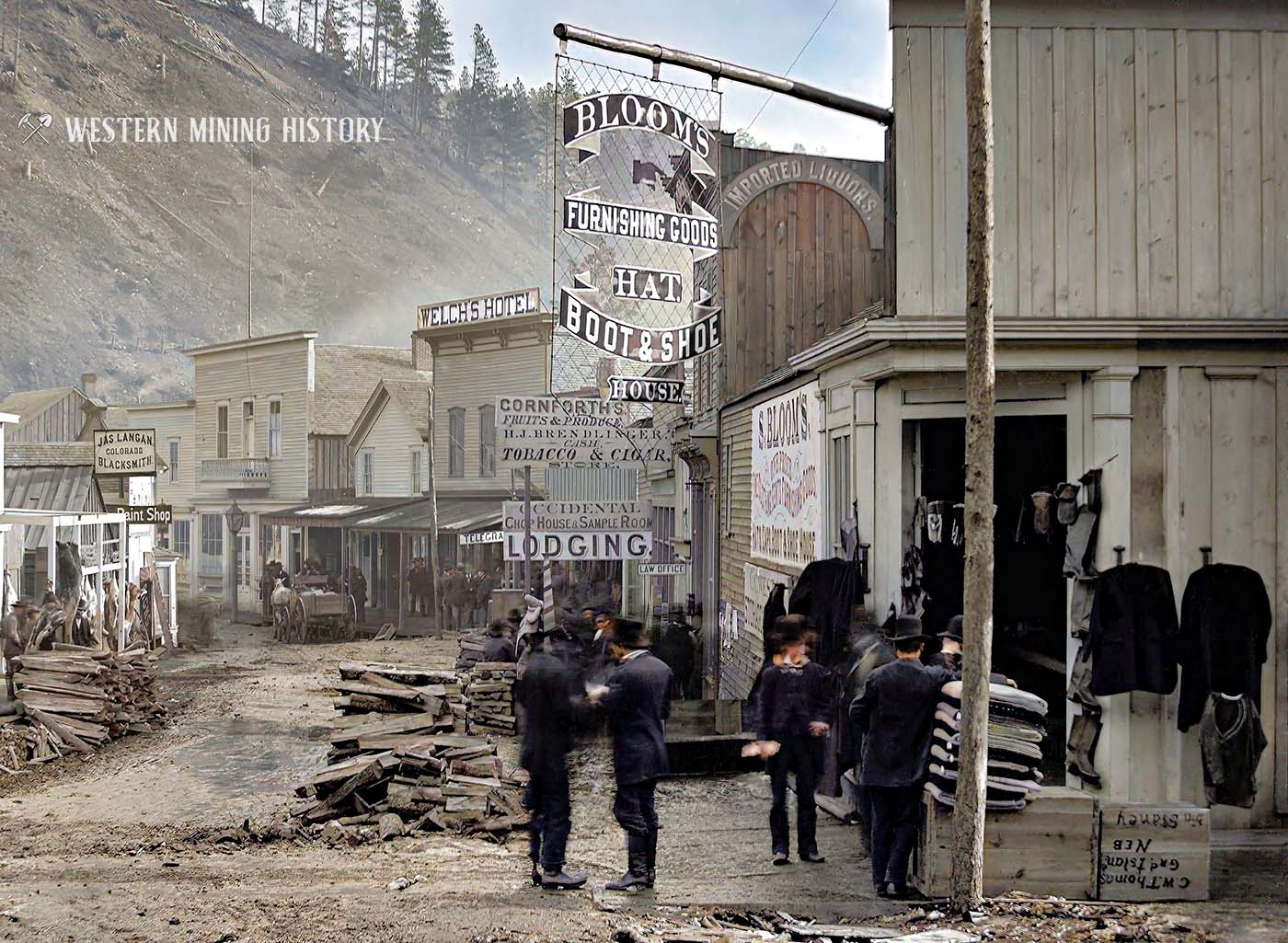
The above image has been described by various sources as both Wall and Lee streets. Regardless of the exact street location, this is one of the West’s most iconic mining town scenes.
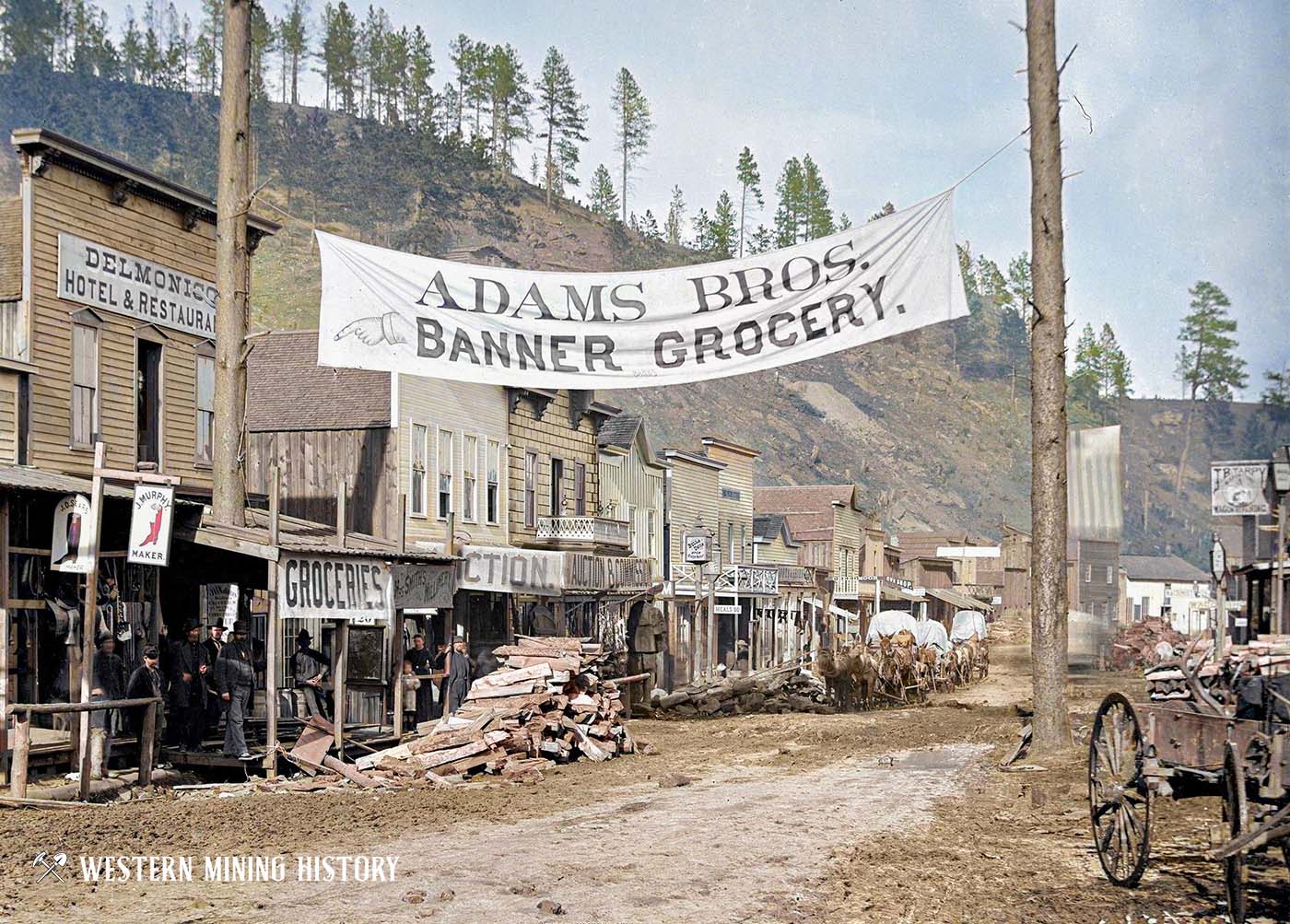
The above photo depicts Main Street – Deadwood, Dakota Territory in 1877. A banner for Adam Bros. Banner Grocery hangs across the road. The Delmonico Hotel and Restaurant can be seen on the left.
Virginius Mine – Southwest Colorado
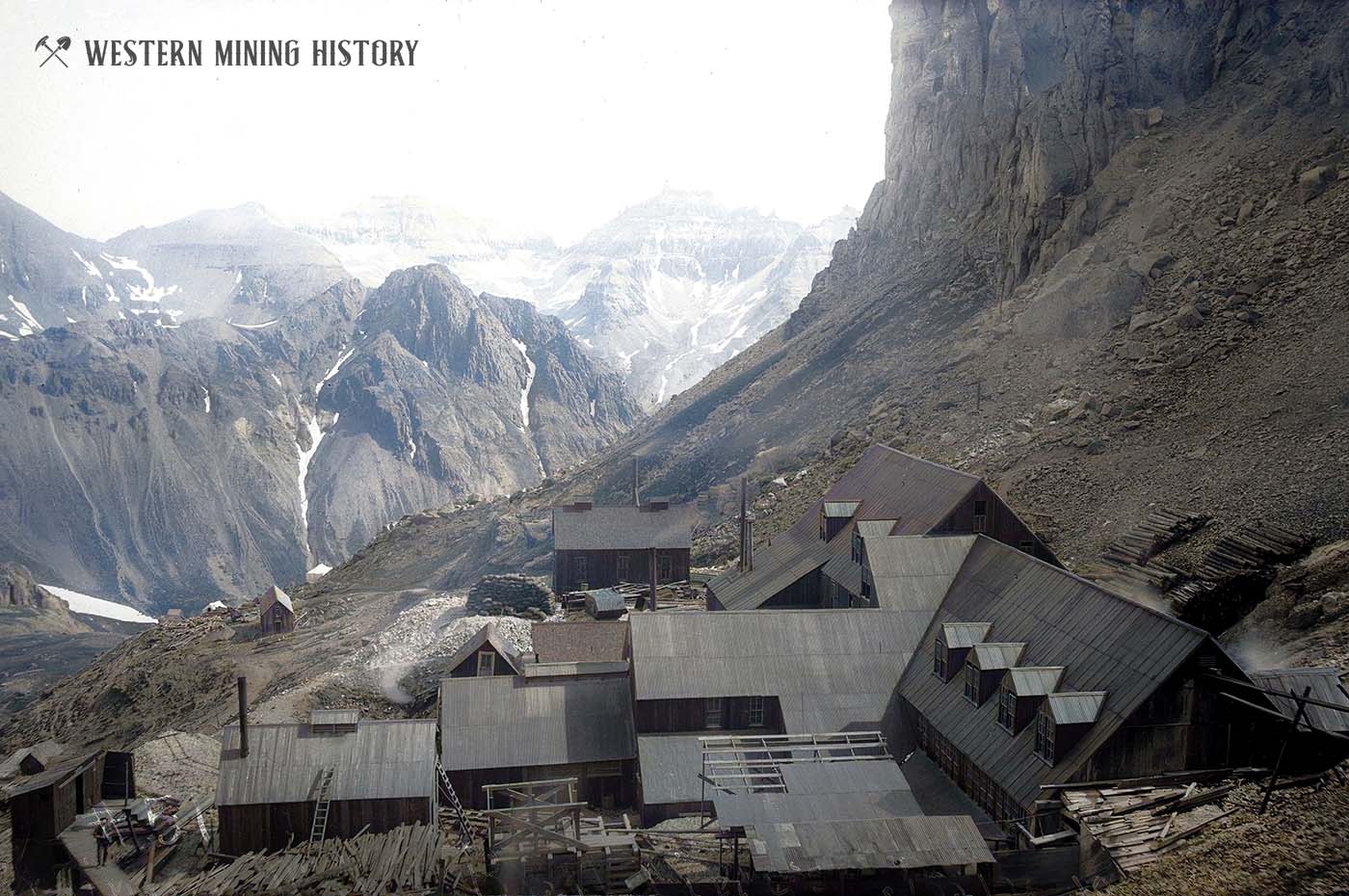
Situated at over 12,000 feet in elevation, the Virginius Mine is located approximately 2,000 feet above the town of Sneffels. The photo above illustrates the kind of terrain that many of Colorado’s top mines were located in.
Drumlummon Mine at Marysville, Montana
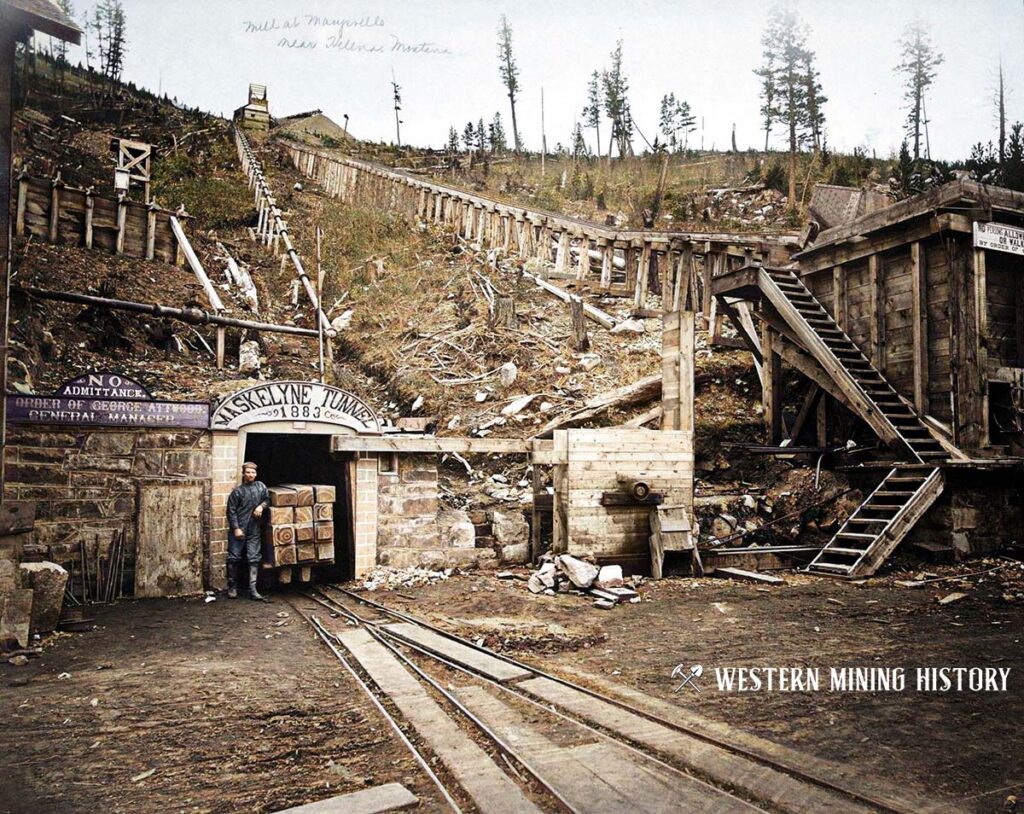
The fabulous Drumlummon mine at Marysville, Montana was discovered in 1876 by Thomas Cruse, a poor immigrant from Ireland that had a reputation for taking grubstakes and never producing any returns on them. Cruse was ridiculed by his fellow miners until he discovered the Drumlummon lode, and overnight “Irish Tommy” became “Mr. Cruse”.
Historic Mining Scene – Pony, Montana
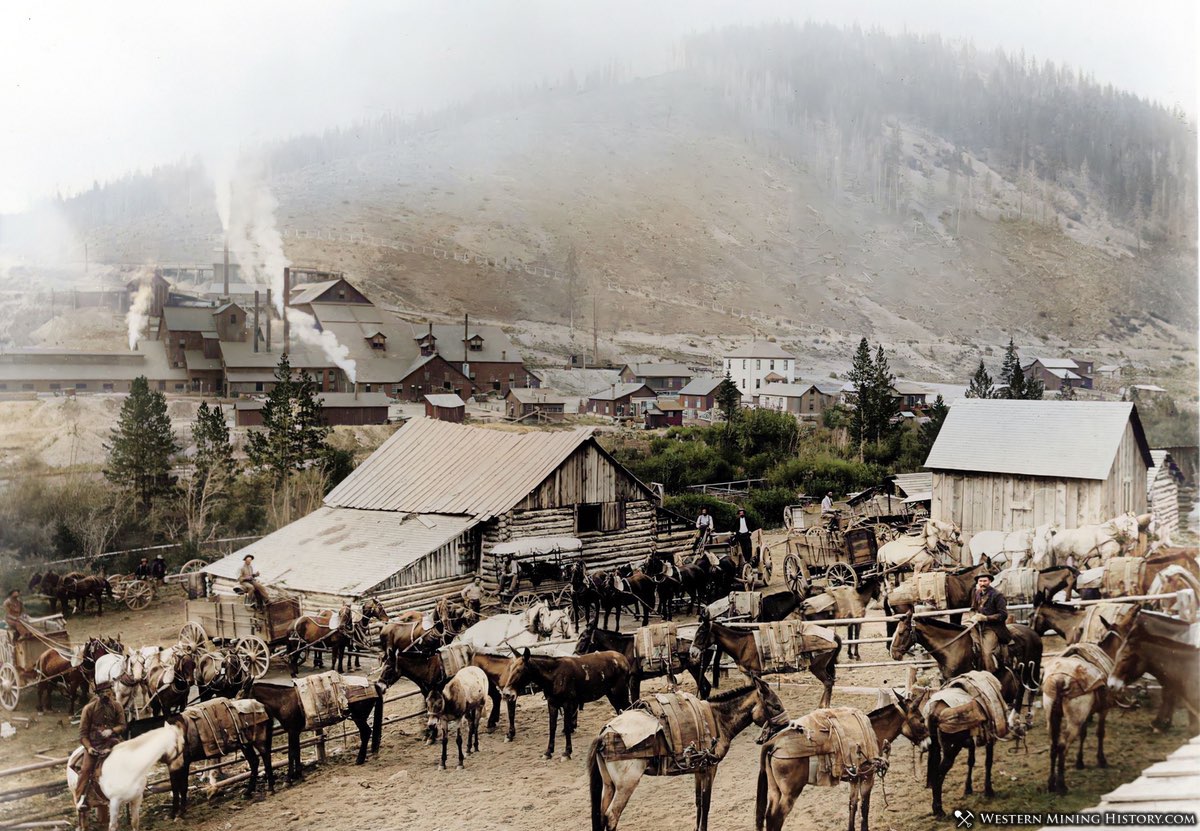
This incredible photo is a view of Pony, Montana around 1900. The image features pack animals and freight wagons with the town of Pony and an enormous stamp mill in the background.
Classic Gold Prospector Scene
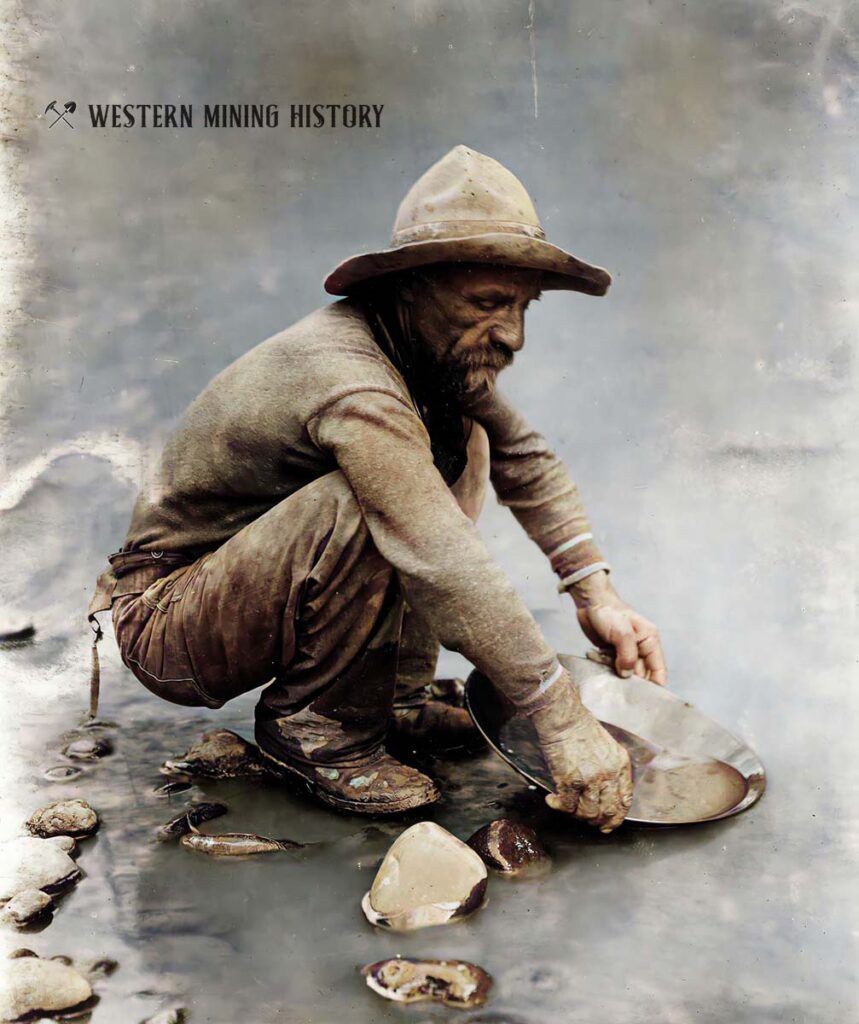
This notable image of a prospector gold panning in a river is one of the most famous photos from the gold rush era. This photo has often been misidentified, but a reputable archive states that the photo was taken on the Colorado River near Lee’s Ferry in Arizona Territory. Dates assigned to the photo also vary, but this scene is likely from 1900 or earlier.
Cosmopolitan Saloon and Gambling Hall
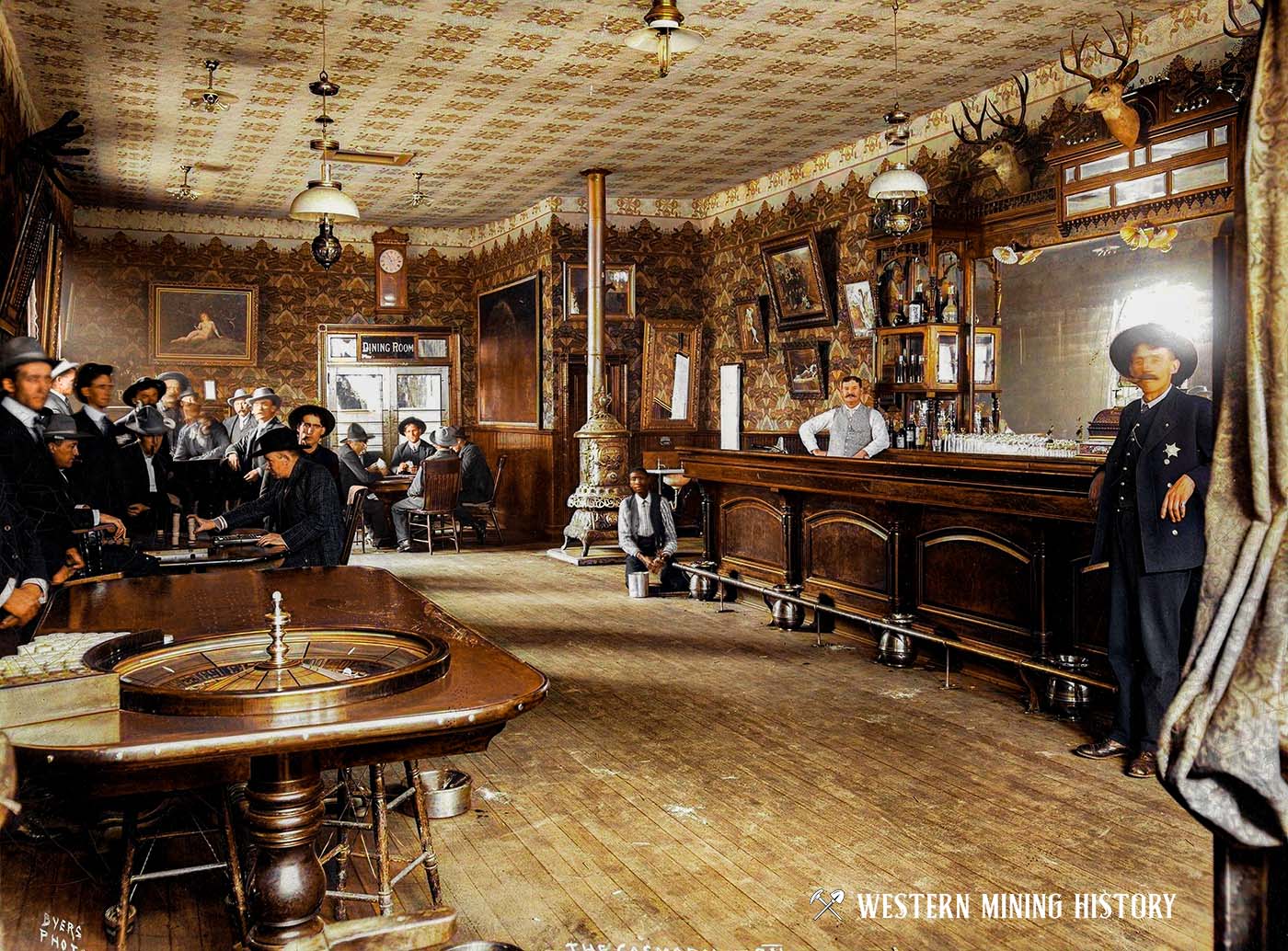
Depicted is an interior view of the Cosmopolitan Saloon and Gambling Hall at Telluride, Colorado ca. 1910. The wealth of the Telluride district is on display in this very ornate drinking establishment.
Stagecoach Crosses Bridge on Ouray-Silverton Road
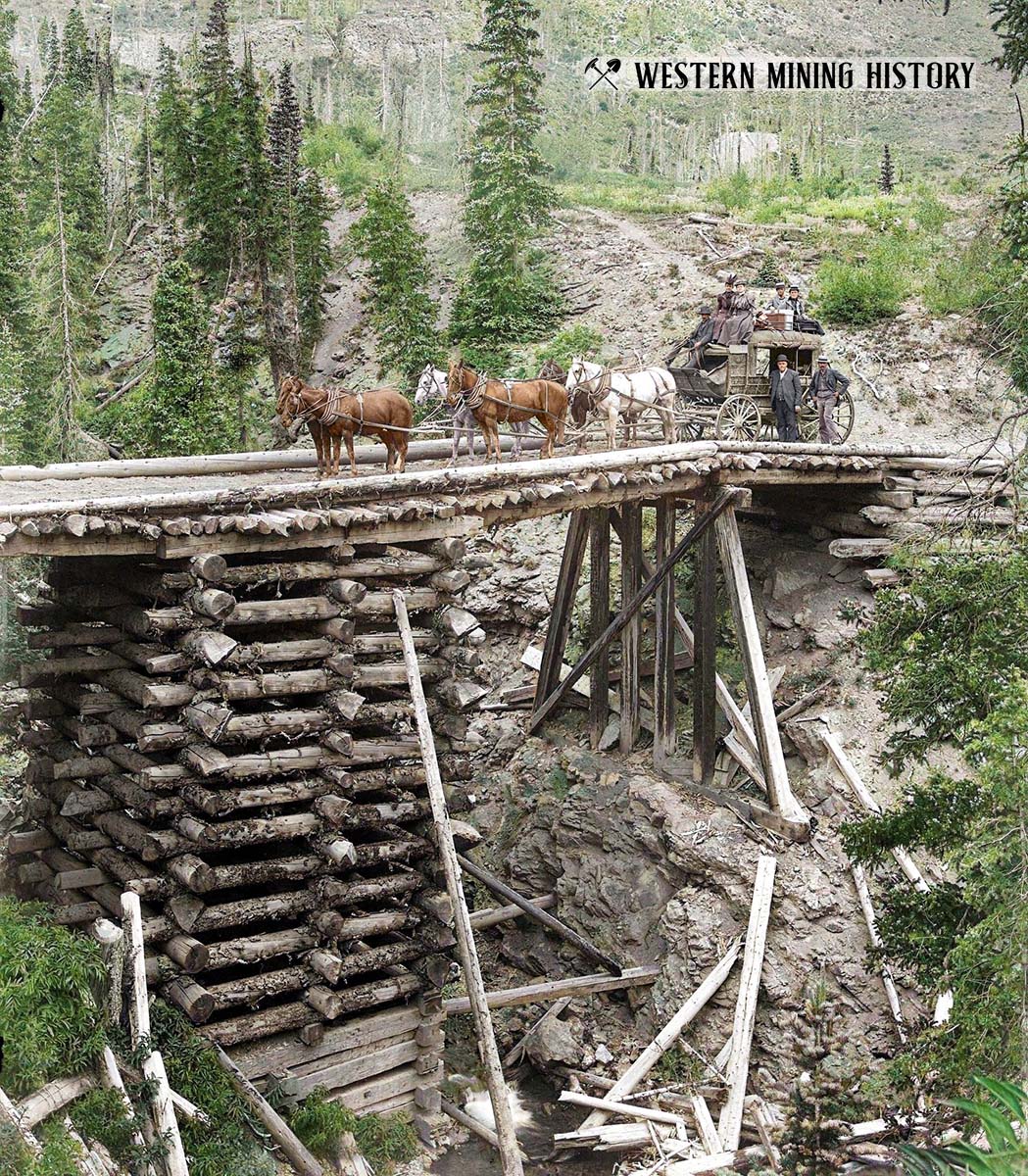
The route between the important mining towns of Ouray and Silverton (Colorado) was initially thought to be impossible to build a road on. Otto Mears, the region’s premier road builder, accepted the challenge and built what was know as Otto Mears Toll Road at the time – now it is called the Million Dollar Highway. This was a vital link between Ouray and the booming Red Mountain mining district.
The Young America Mine
The Young America mine was located in the Sardine Lakes area, just a few miles north of Sierra City, California. The operation’s stamp mill was situated in a particularly spectacular location on the shore of Lower Sardine Lake, as the photos below reveal.
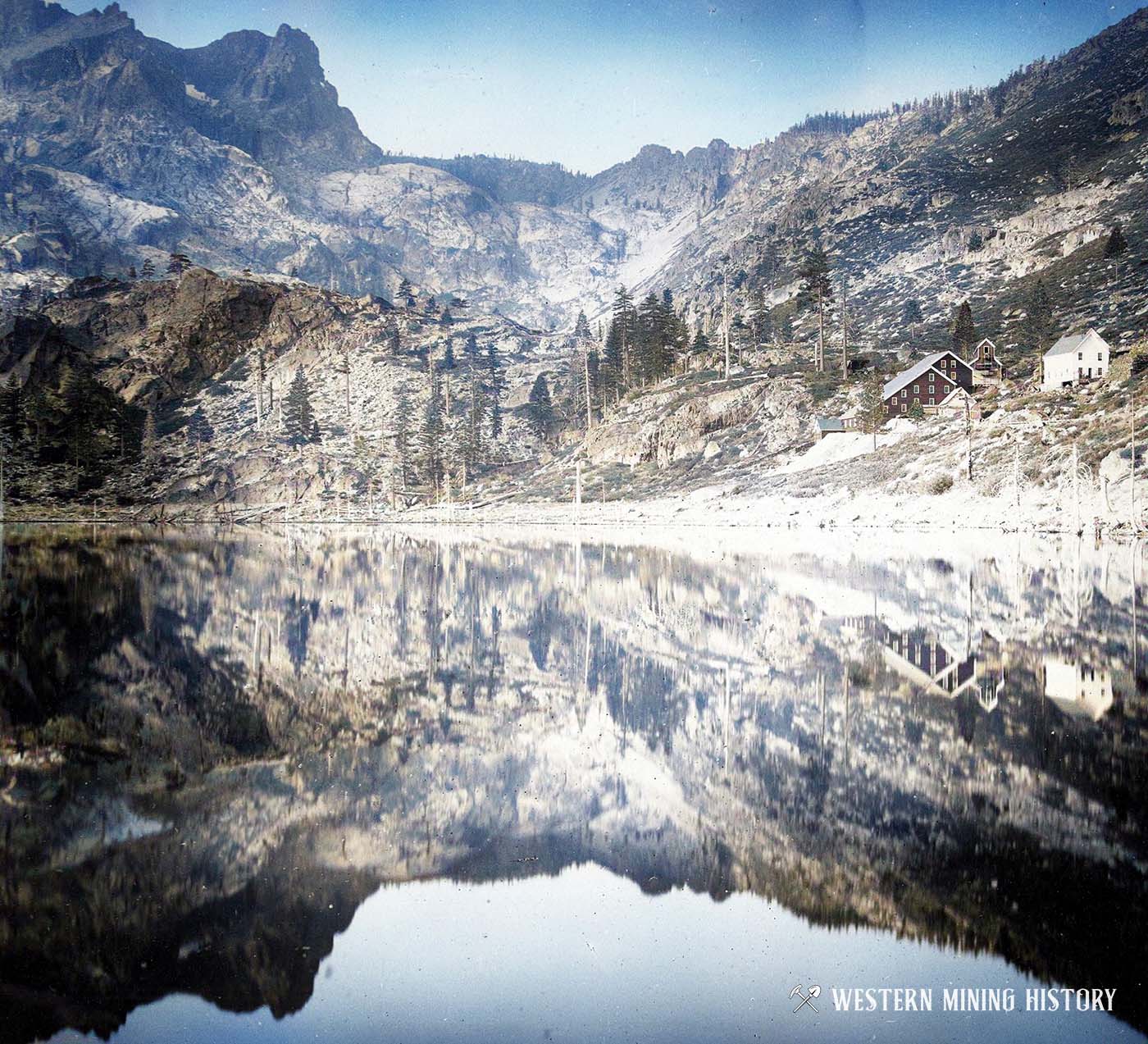
The photos displayed here were taken circa 1885, during the peak years of the mines production.
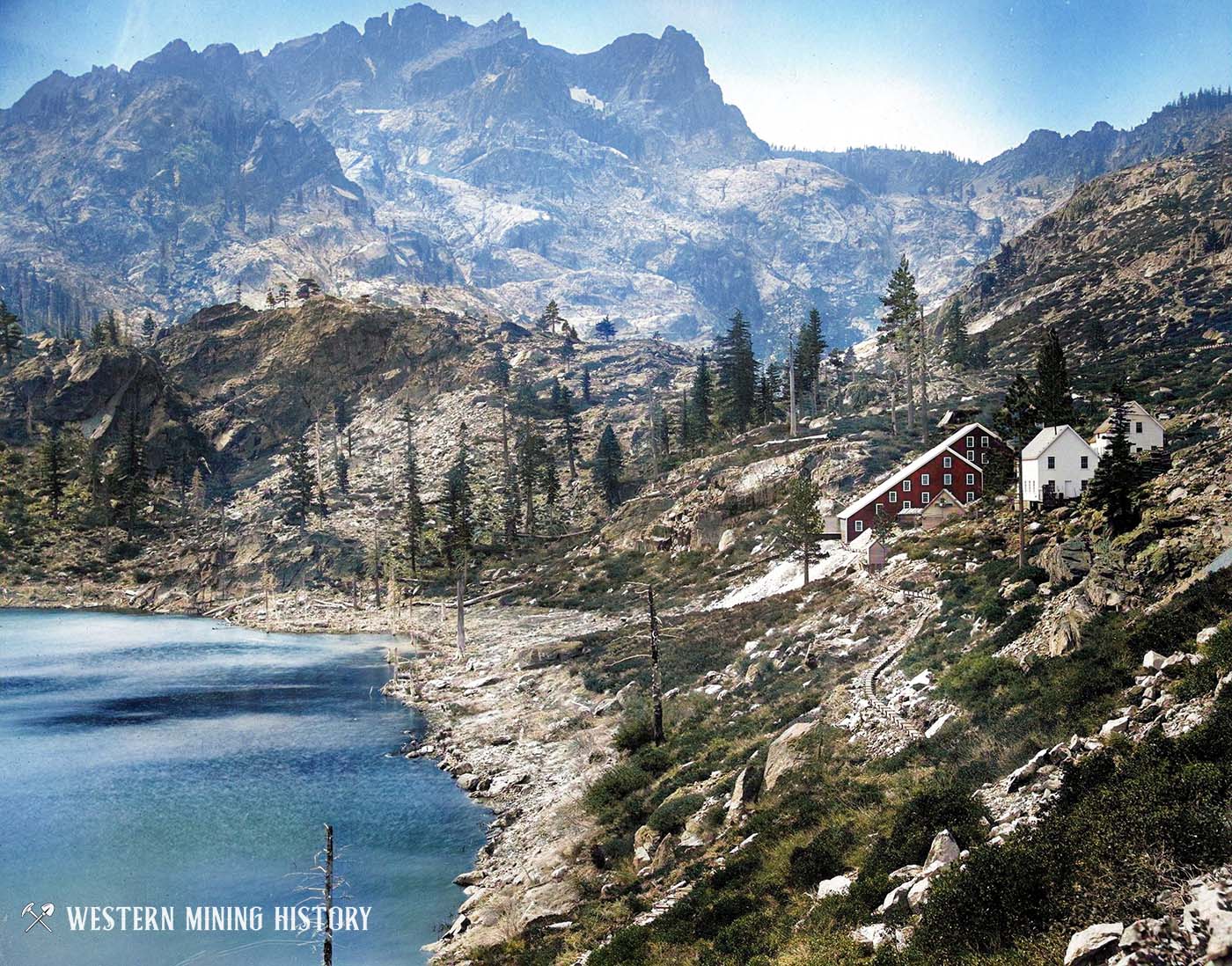
The mill was upgraded in 1885 and 1886, resulting in a total of 40 stamps crushing ore from the Young America mine. It was claimed that the pounding of the stamps could be heard all the way at Sierra City.
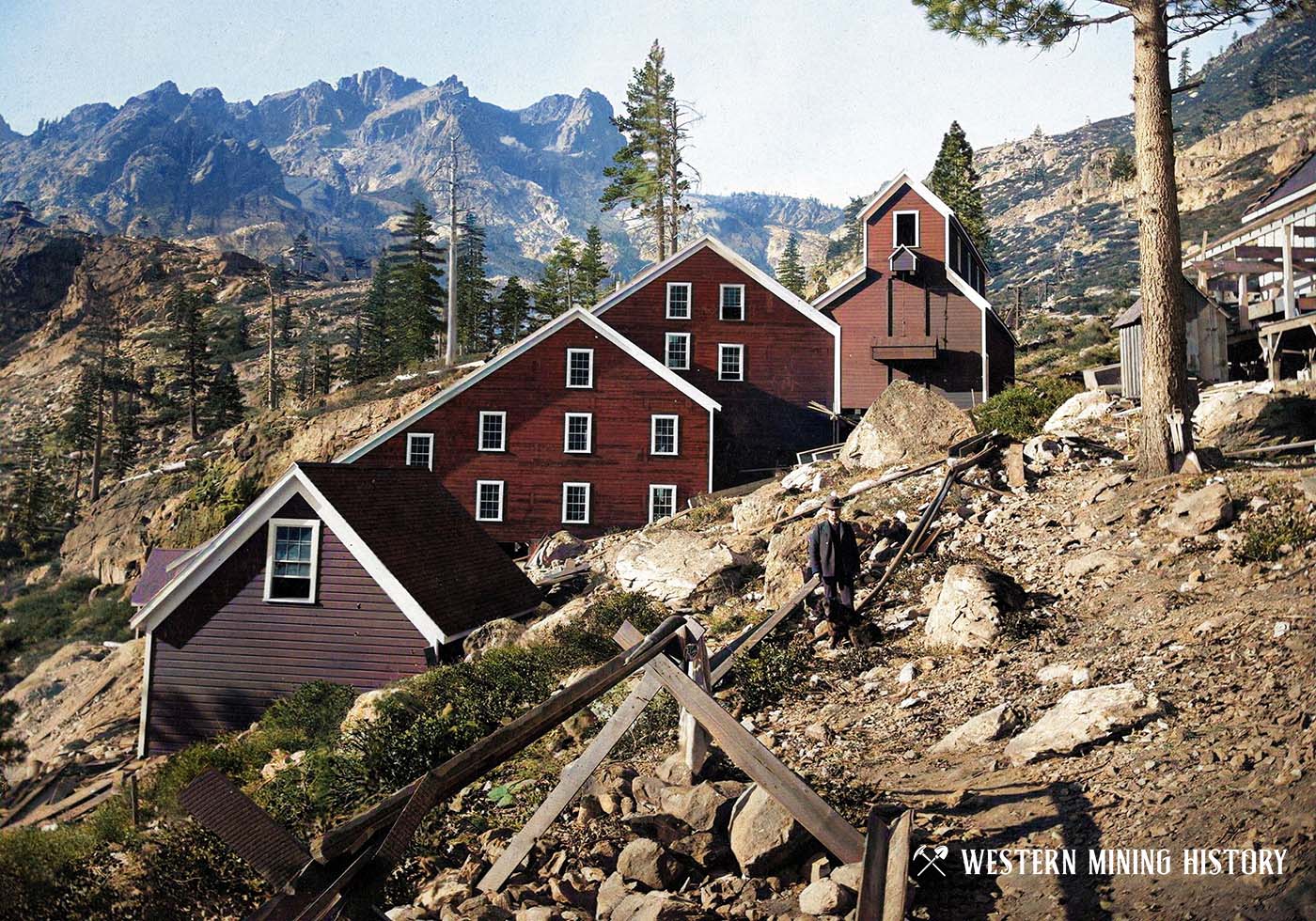
More photos and information on this mine are available in the article The Young America Mine and the Deidesheimer Gold Heist.
Crowd at the Railroad Depot – Tonopah, Nevada
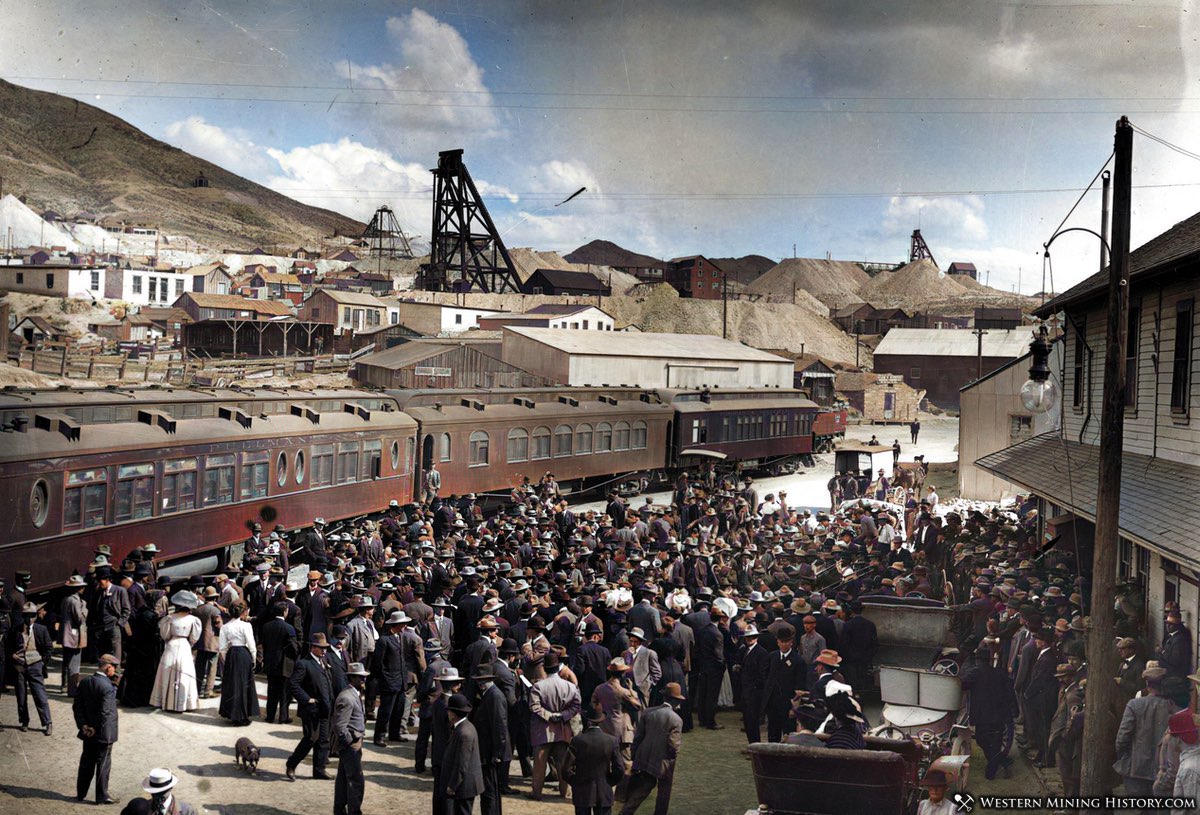
This incredible photo depicts the Tonopah, Nevada rail station in 1907. A crowd has gathered to watch a band play. The incredibly rich Tonopah silver mines can be seen behind the station.
Tonopah, Nevada Lightning Storm
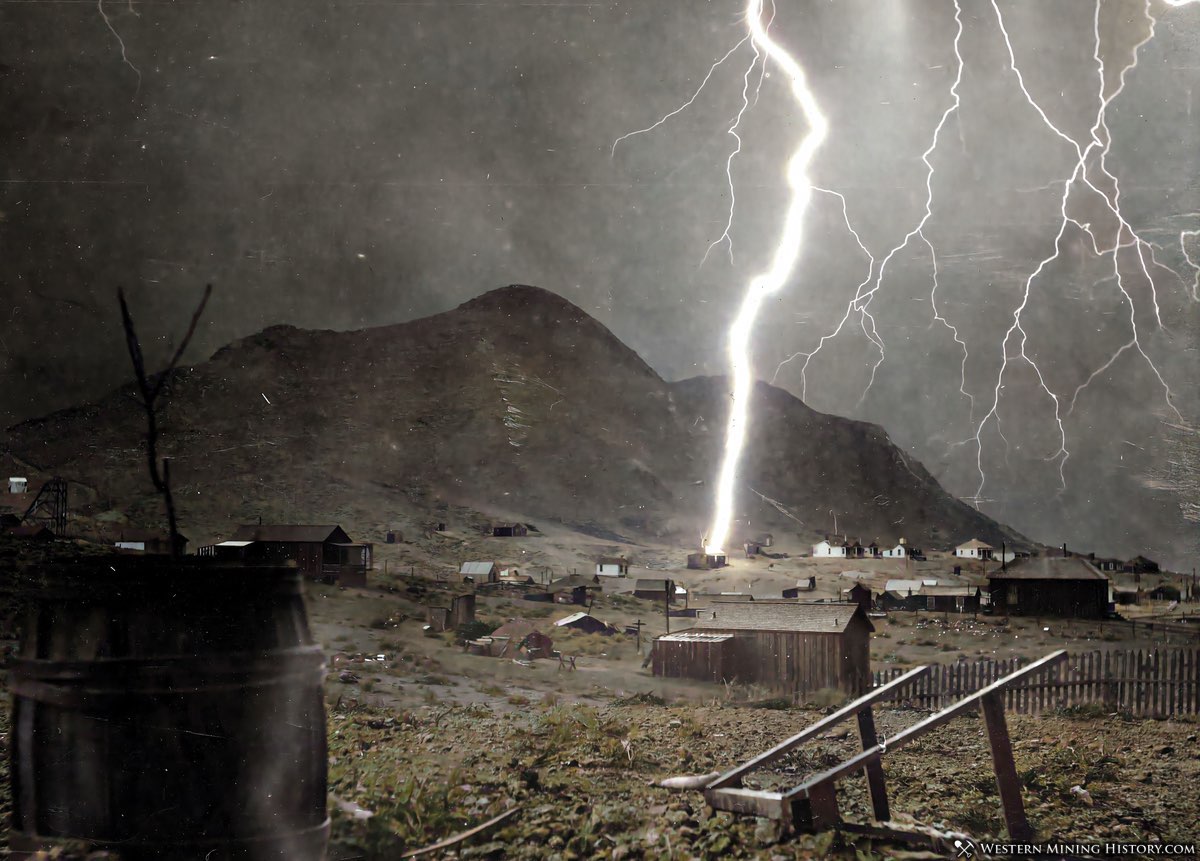
This photo depicts a lightning storm at Tonopah, Nevada in 1904. Tonopah was a young silver boom town in 1904, but would go on to be Nevada’s richest mining district of the early 1900s.
Eureka, Colorado
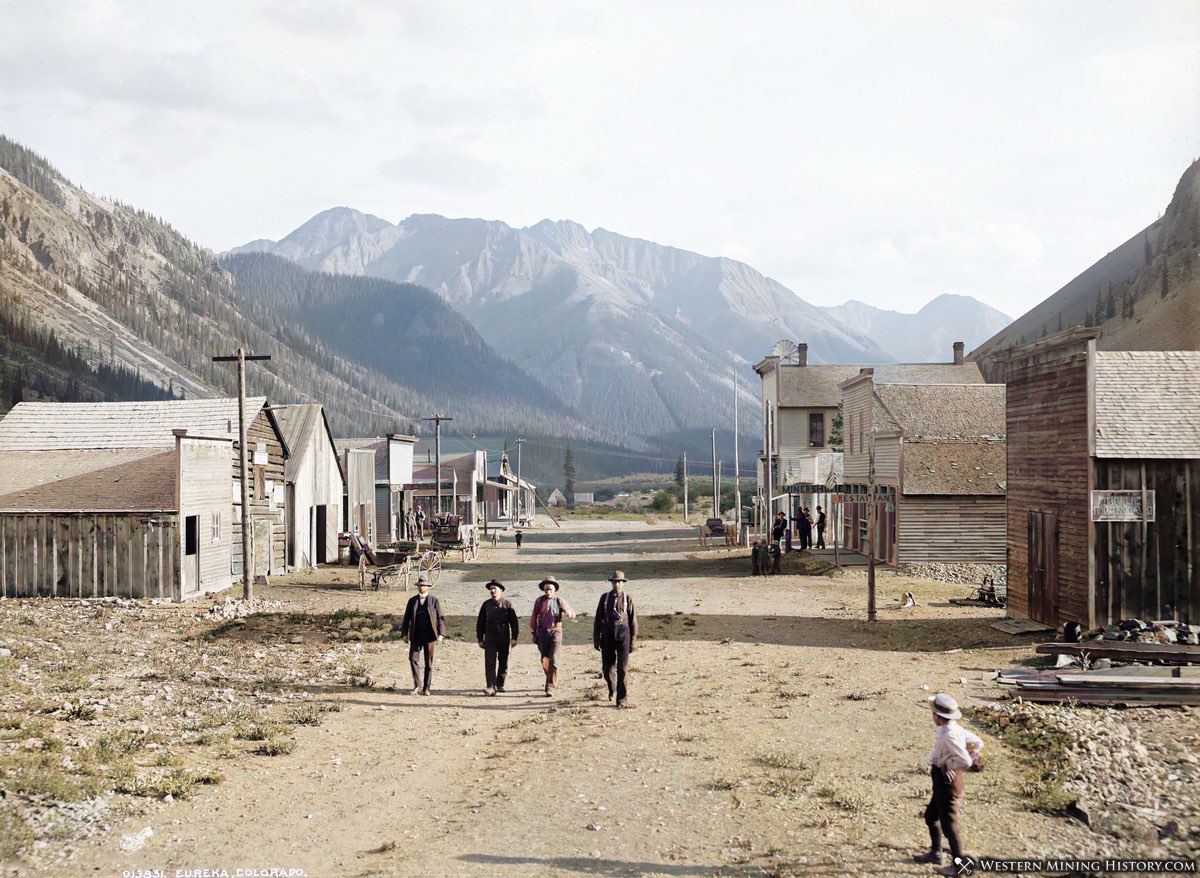
This view of Eureka, Colorado (near Silverton) was taken by famous frontier photographer William Henry Jackson. Eureka was already in decline when this photo was taken around 1900, and today it is a ghost town.
Miners Pose at Unidentified Nevada Mine
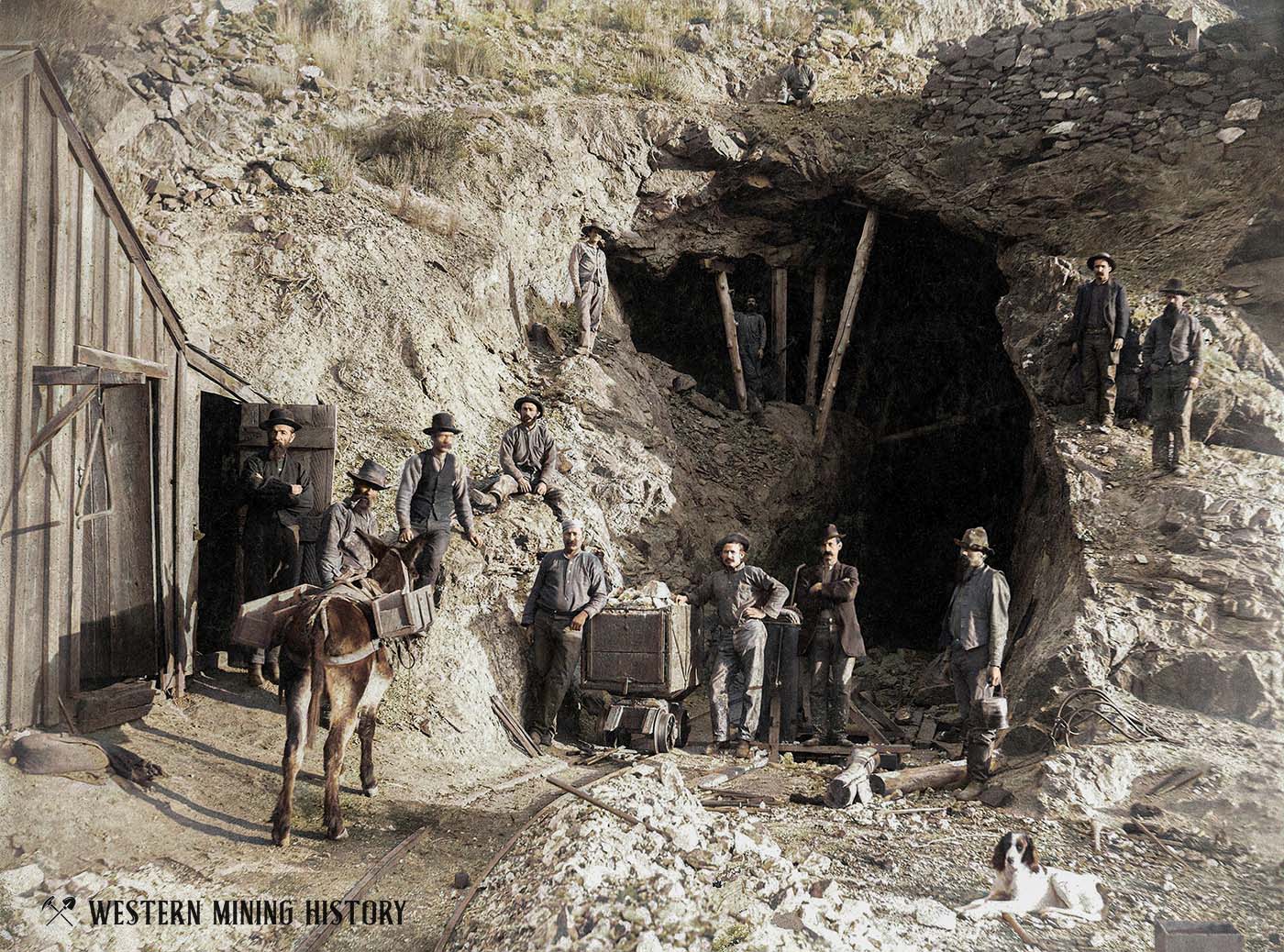
This amazing scene from the late 1800s depicts a group of miners at the entrance of an unidentified Nevada mine. The image includes an ore cart full of ore, a mule carrying supplies, and even a dog supervising the progress at the mine.
Hoist Operator in the Della S Mine – Aspen, Colorado
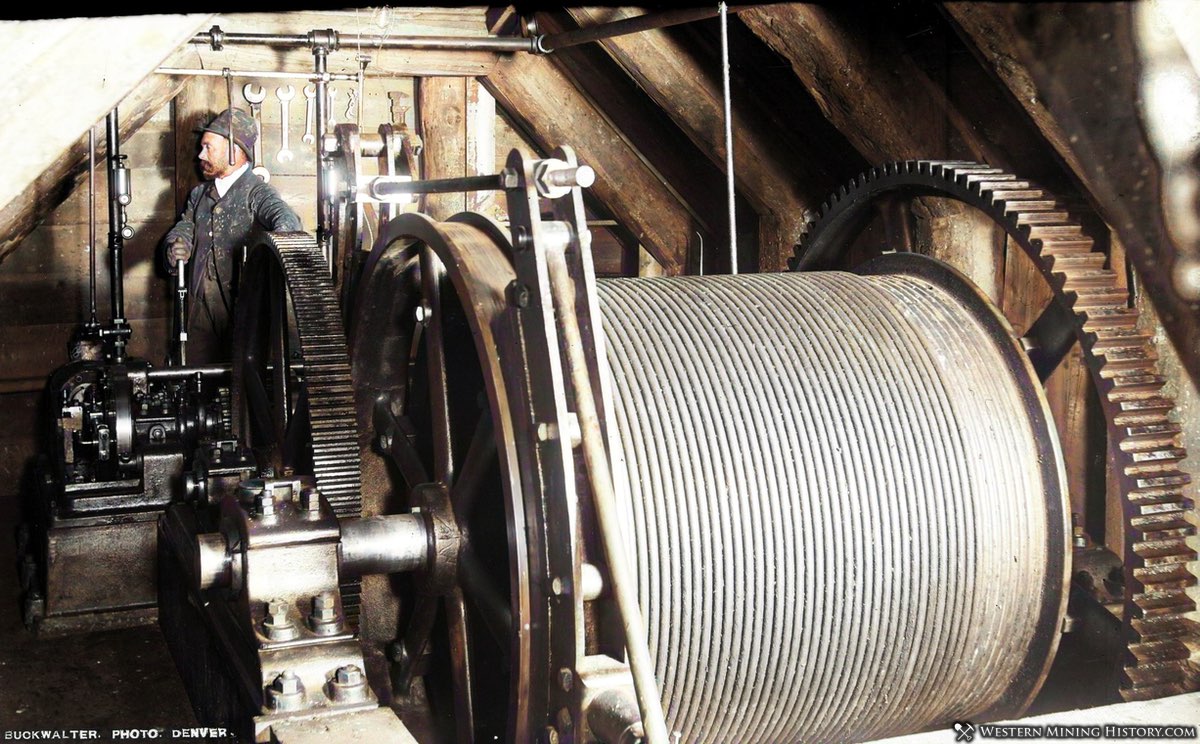
By 1893 Aspen, Colorado had become the nation’s top silver producing district. This amazing photo of an underground hoist operator was taken during the peak period for Aspen’s silver mines.
Mining in the Black Hills
Although the initial rush to Deadwood Gulch was centered on gold placer mining, in the next couple decades mining became an enormous industry – both above and below ground.
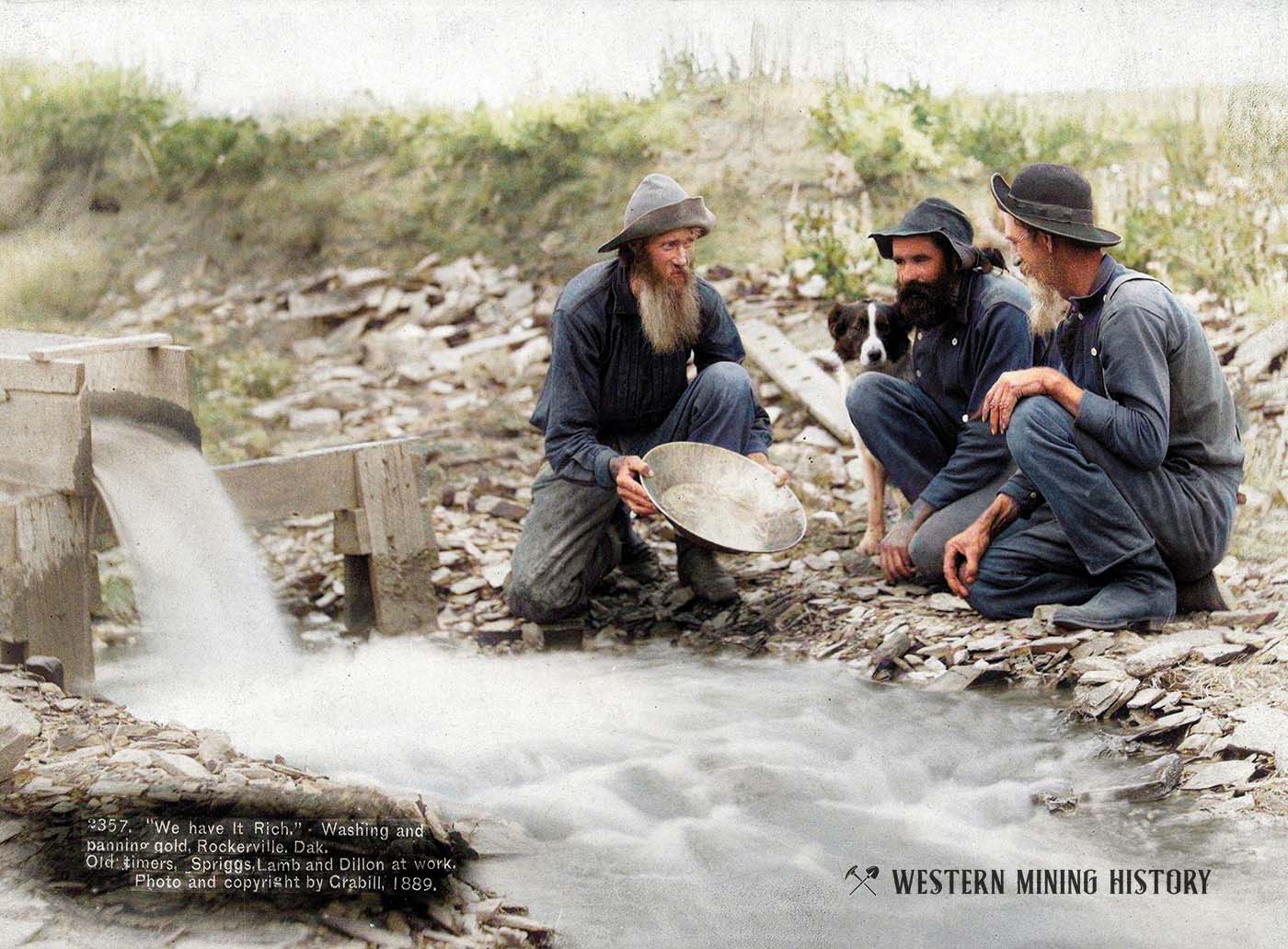
This 1889 photo is captioned “‘We have it rich’ – washing and panning gold, Rockerville Dakota. Old timers Spriggs, Lamb, and Dillon at work.”
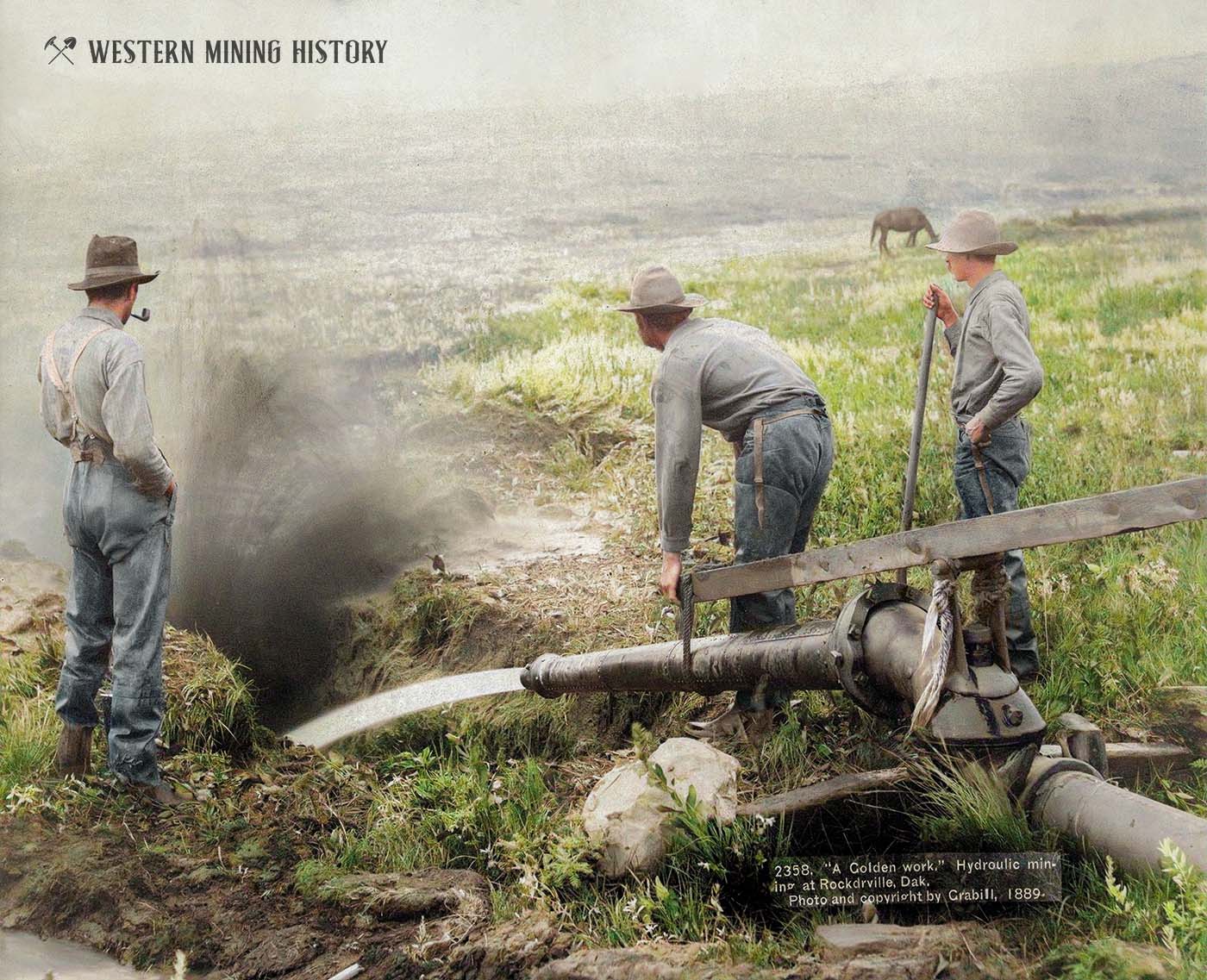
This 1889 photo is captioned “‘A golden work’ – Hydraulic mining at Rockerville Dakota”. Hydraulic mining required elaborate systems of flumes and pipes to bring water to a mining site – sometimes from tens of miles away.
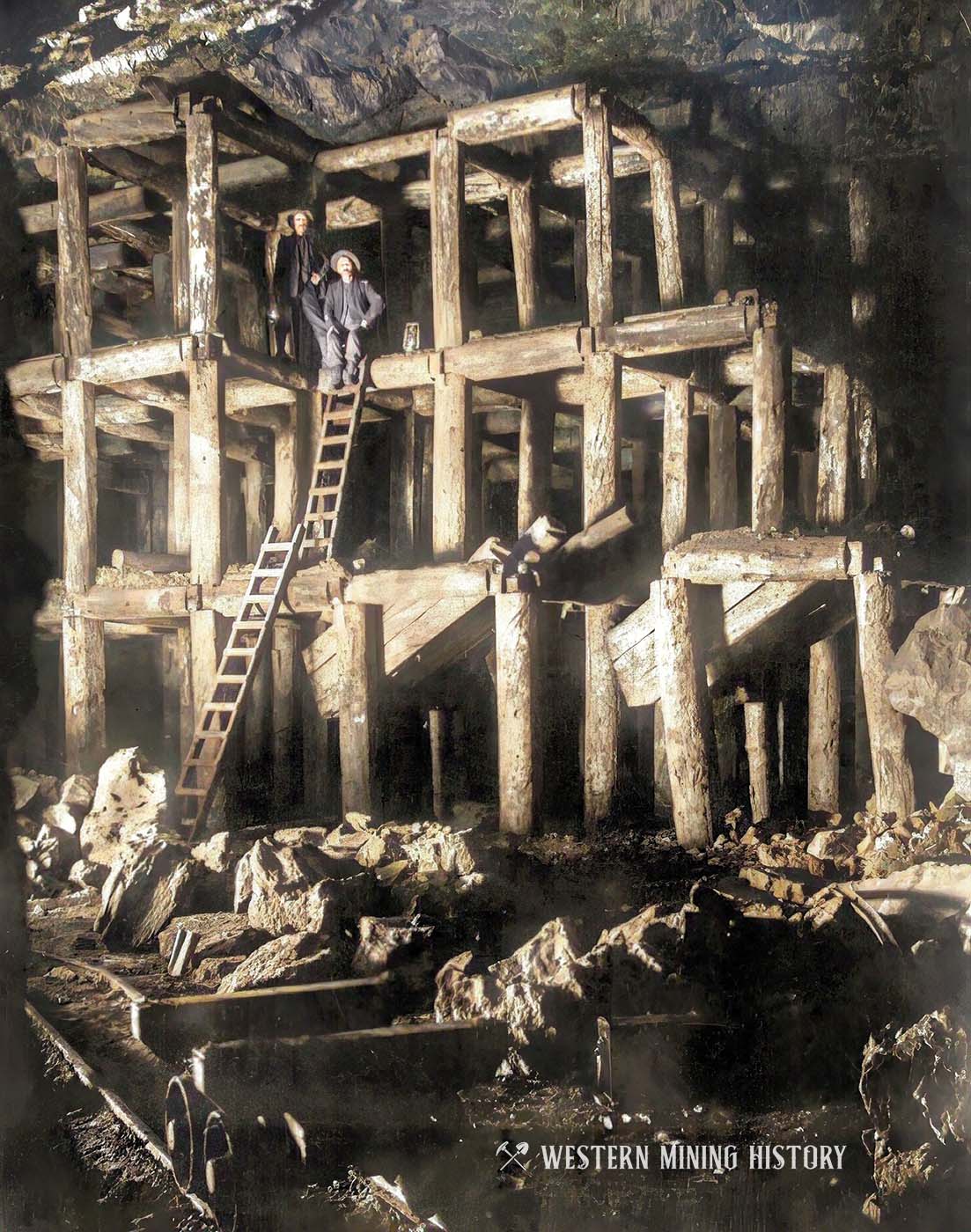
This interior view of the famous Homestake Mine in Lead, South Dakota, was taken in 1908. The photo depicts two miners posing on square set timbering.
The Homestake Mining Company, which was incorporated in 187, originally held only two fractional claims covering about 14 acres. These claims were purchased from prospectors who had located them in 1876 and had taken out about $5,000 in gold. Other companies were organized and in operation in 1878, but they were gradually assimilated by Homestake. By 1931 the Homestake Co. controlled 654 mining claims covering 5,639 acres.
The mine operated until 2002, was over 8,000 feet deep, and produced over 43 million ounces of gold.
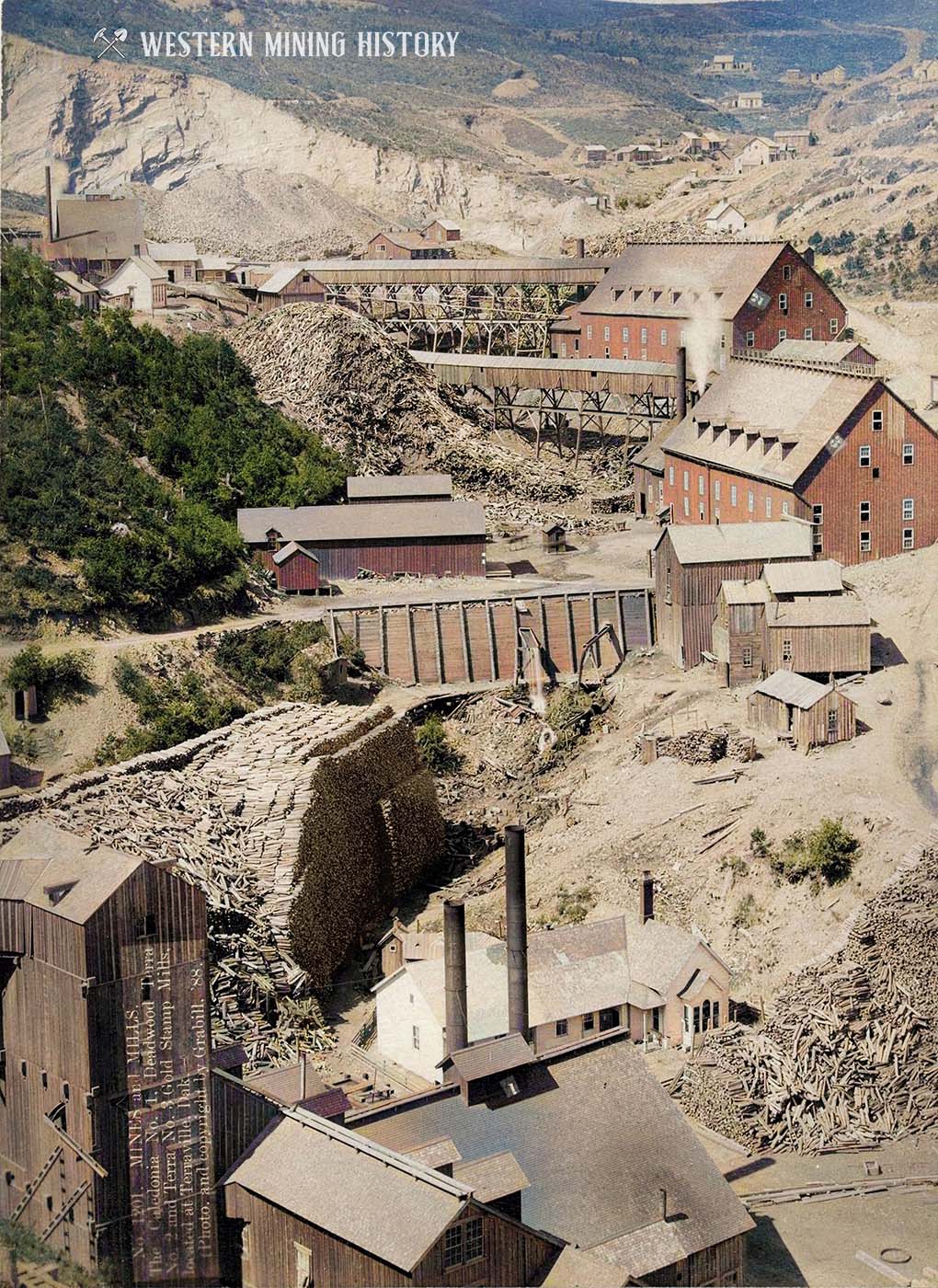
This 1888 photo by John C. Grabill depicts the Caledonia No. 1, Deadwood Terra No. 2, and Terra No. 3. Gold Stamp Mills, located at Terraville, South Dakota. The Deadwood gold mines were the richest in the United States.
Leadville, Colorado
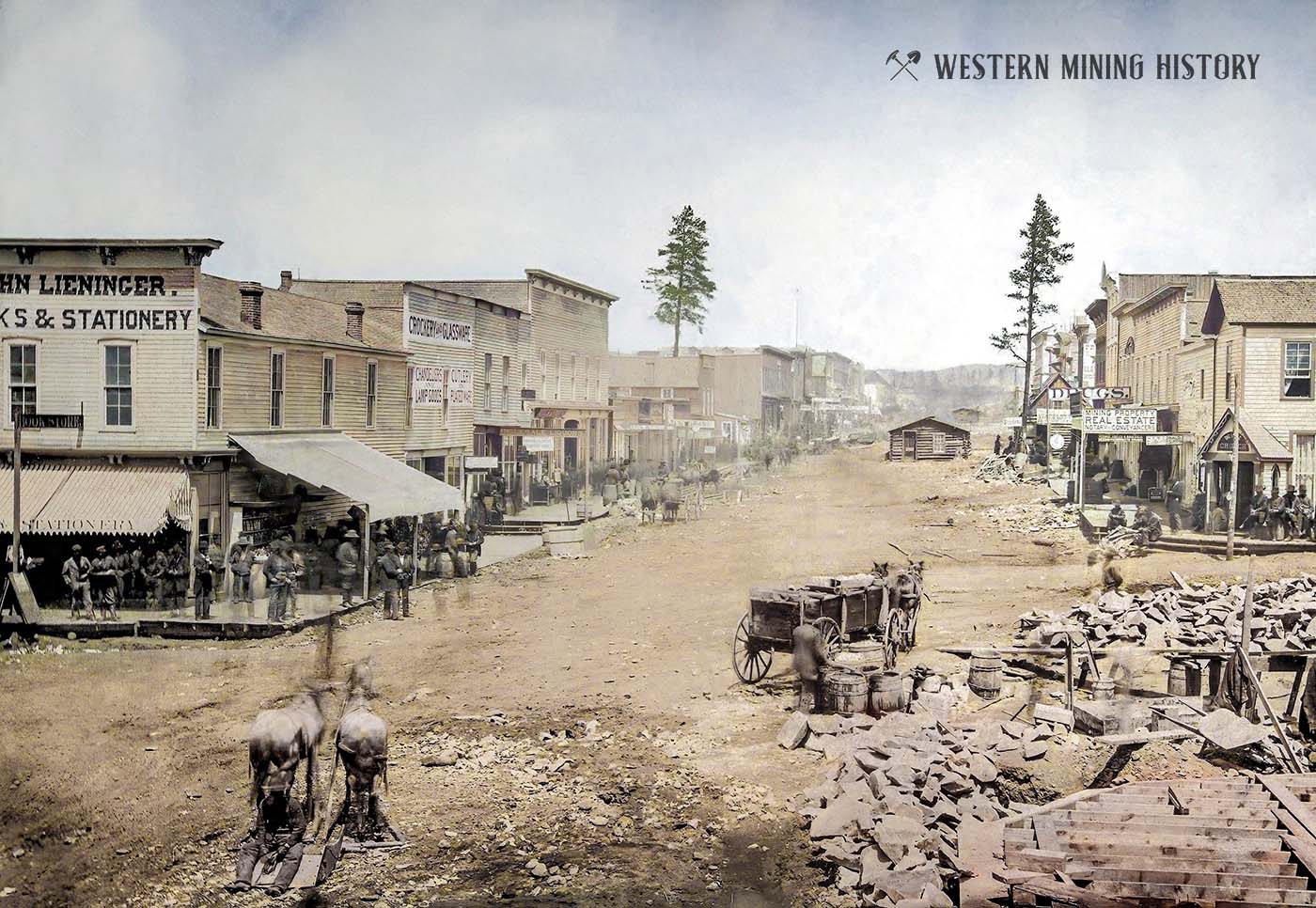
The great silver boom at Leadville, Colorado began in 1879, many years after the town was first established. In the above photo, the rapidly expanding business district is swallowing the last remaining pioneer cabins.
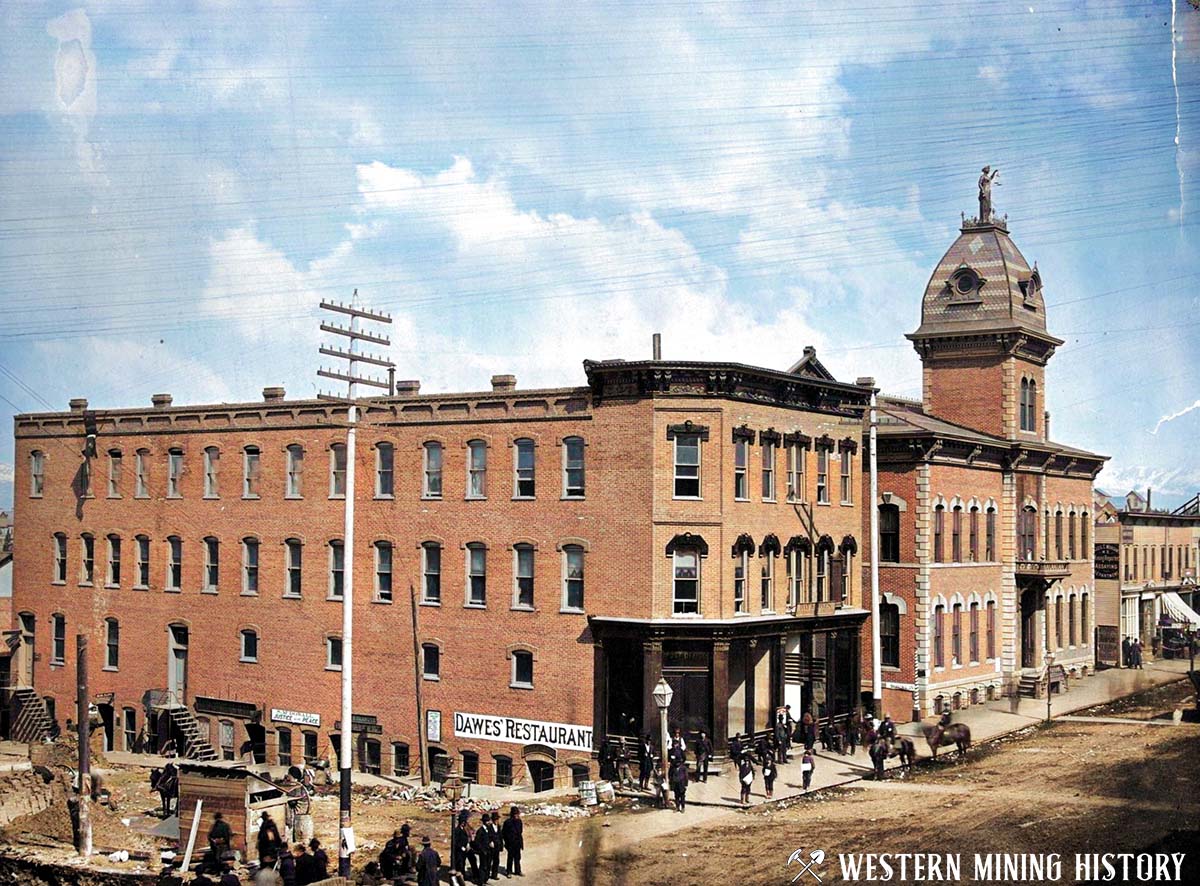
By the 1880s Leadville was Colorado’s richest city, and no expense was spared in the construction of magnificent commercial and government buildings. The building on the right is the Lake County Courthouse. Built in 1880, the courthouse burned in 1942.
The Comstock Lode
Discovered in 1859, the Comstock Lode of Nevada was one of the world’s richest deposits of precious metals, and the mining bonanza that occurred there is one of America’s most significant historical events.
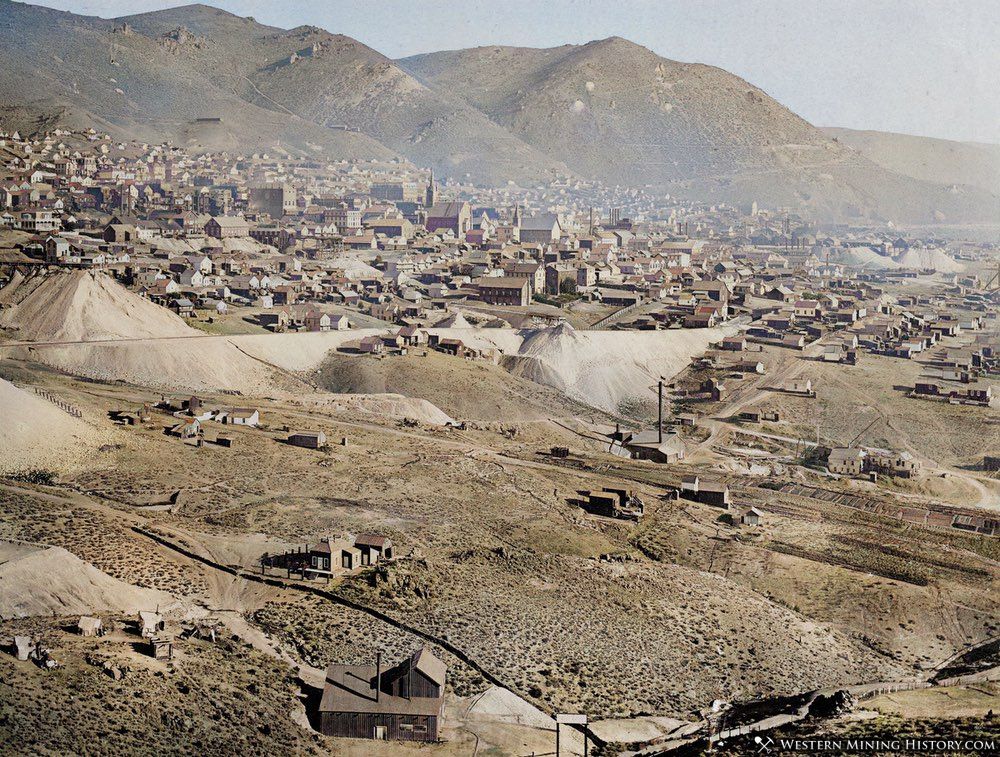
This incredible photo is a view of Virginia City, Nevada around 1878. The image depicts Virginia City at its peak, just as it has entered the “big bonanza” years of the late 1870s and 1880s. The vast riches coming out of the Comstock silver mines during this period made it one of the most important cities in the West.
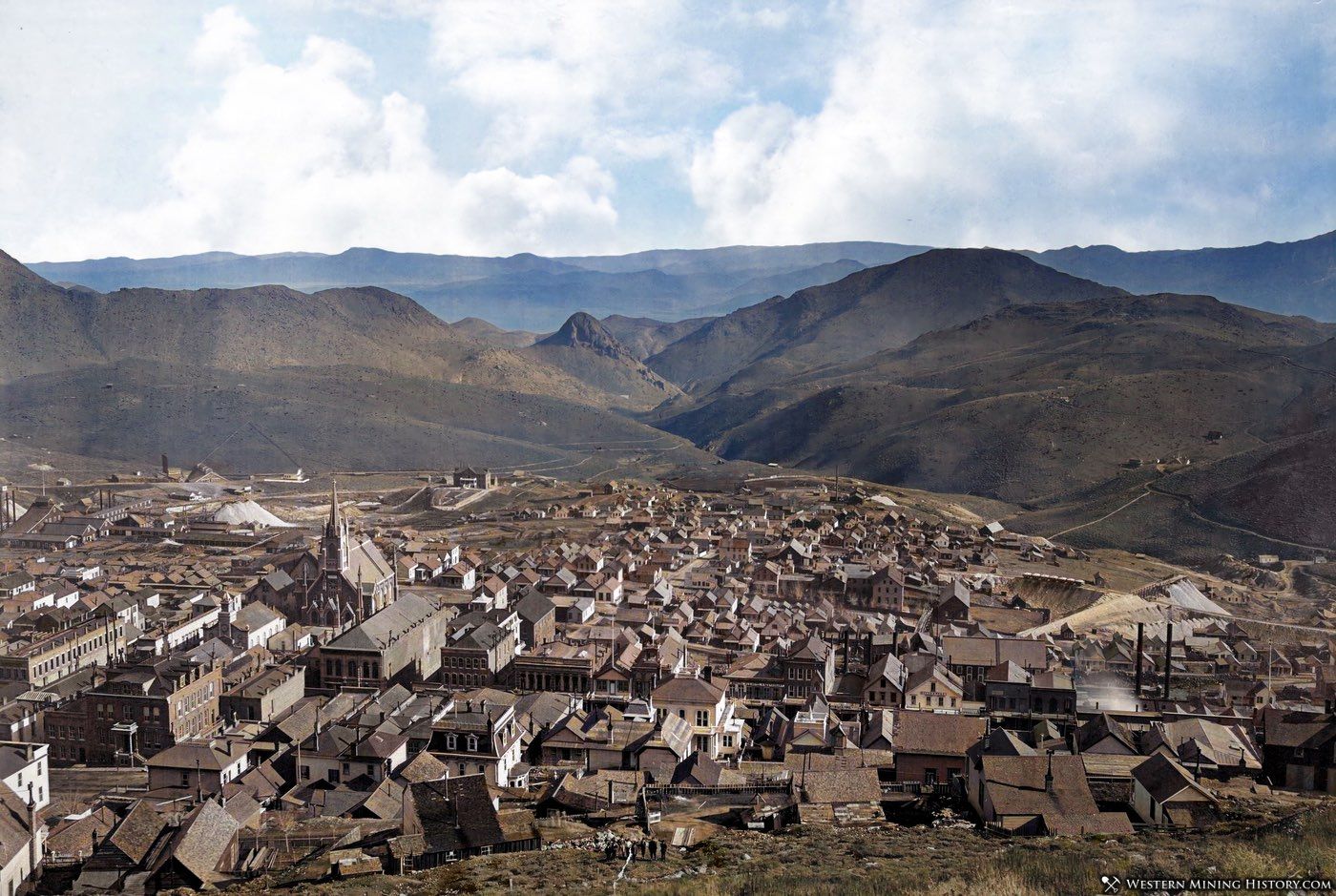
This incredible photo was taken at a pivotal moment in Virginia City history. The mines were in the midst of the “Big Bonanza” and the town was experiencing unprecedented prosperity. The good times came to an abrupt end however as in October a devastating fire burned most of the buildings in this view.
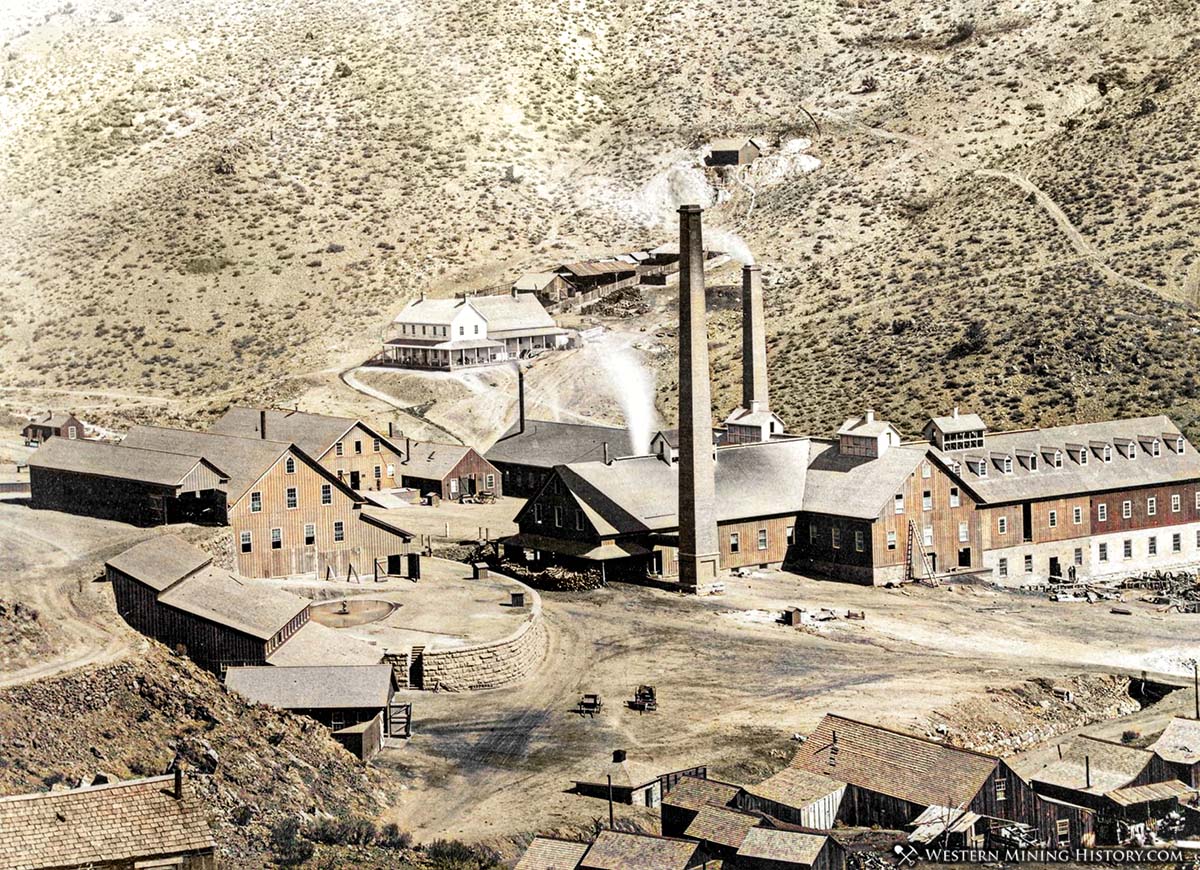
The mines at Virginia City were massive operations even before the “Big Bonanza” years of the mid 1870s. Largely built without the aid of heavy machinery, the amount of work that went into building these structures was amazing, as illustrated by the Gould and Curry Mill in the above photo.
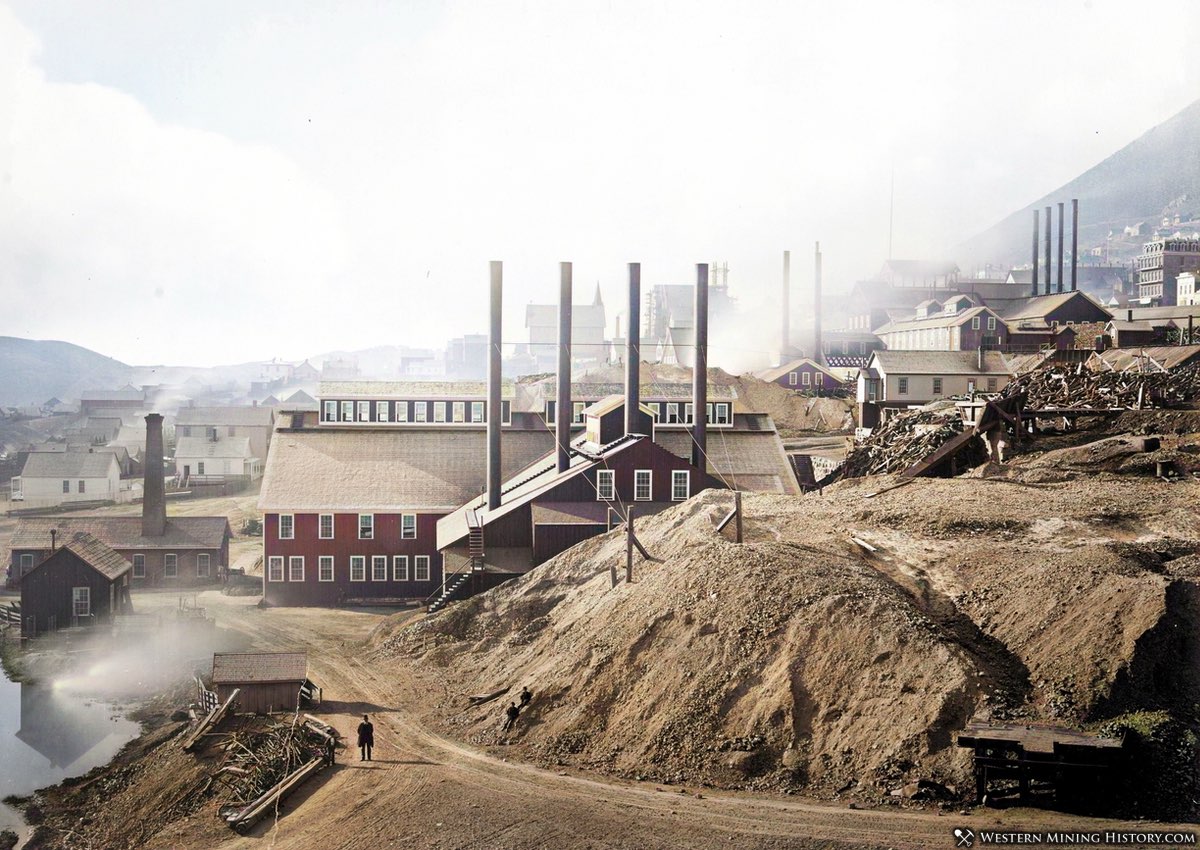
This is the Consolidated Virginia Mill and Hoisting Works at Virginia City, Nevada as seen in 1876. The image depicts Virginia City at its peak, just as it has entered the “big bonanza” years of the late 1870s and 1880s. Note at the upper right part of the photo, the International Hotel is visible. In this view the hotel is still under construction – it opened the following year.
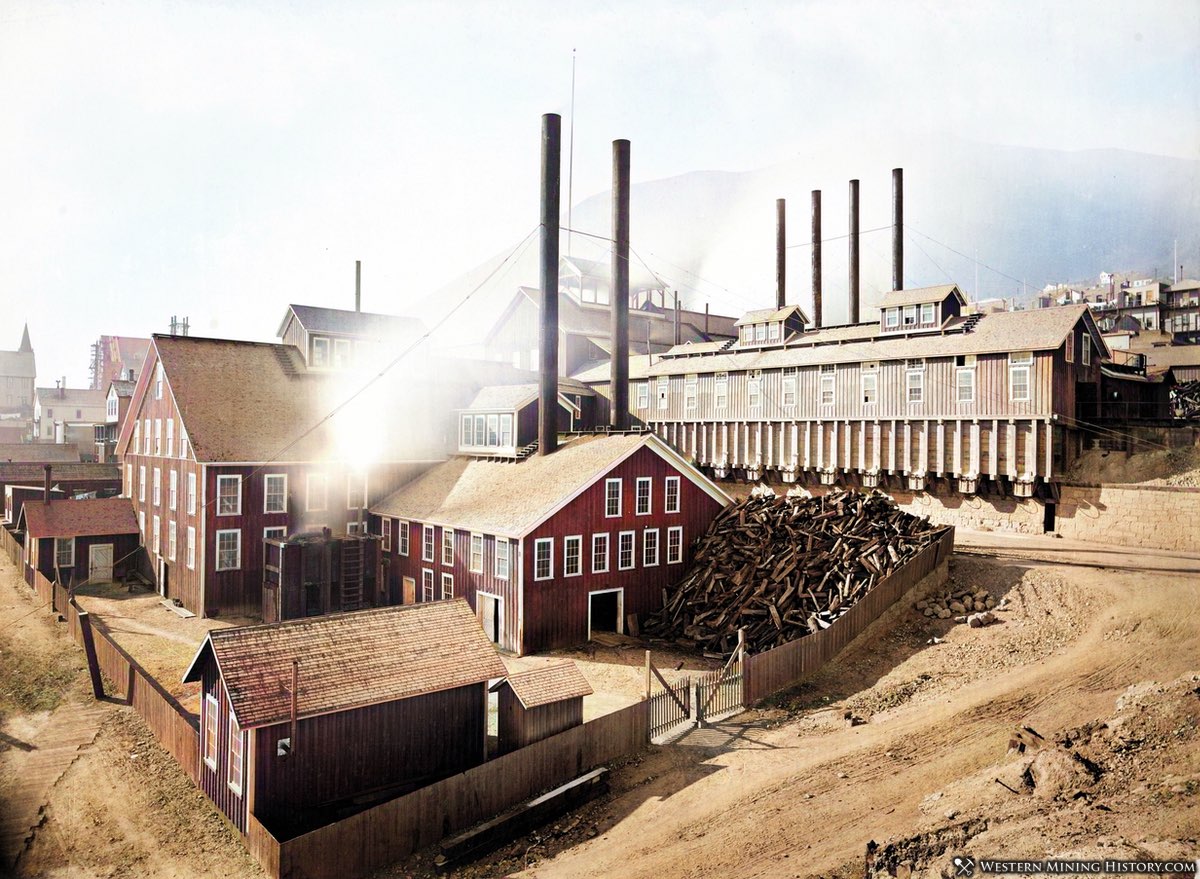
This view of the Consolidated Virginia Mill and Hoisting Works in 1876 Illustrates how quickly the city, and the mine infrastructure, was rebuilt after the 1875 fire. These two views of the Consolidated Virginia were taken by legendary frontier photographer Carleton E. Watkins.
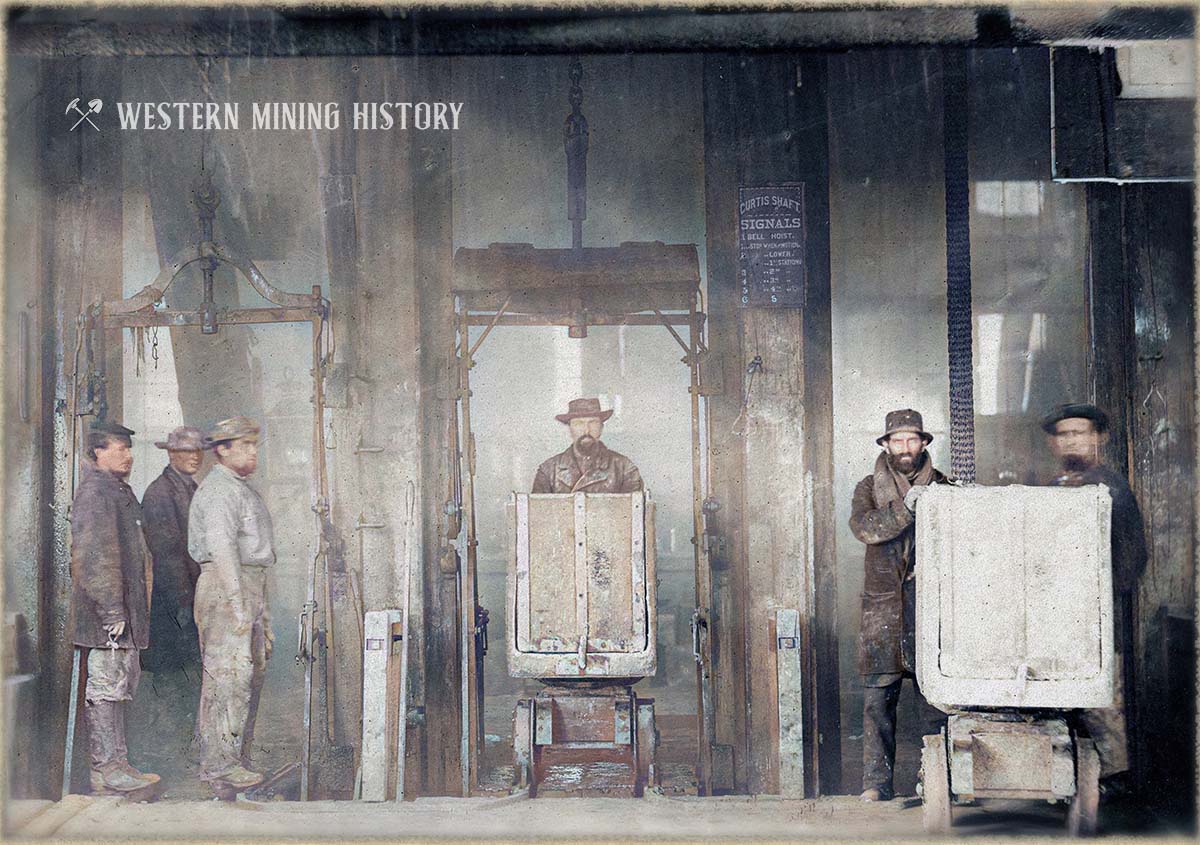
This incredible view depicts miners preparing to descend the Curtis shaft of the Savage mine at Virginia City ca. 1868. The Comstock silver mines of Virginia City were some of the richest ever mined.
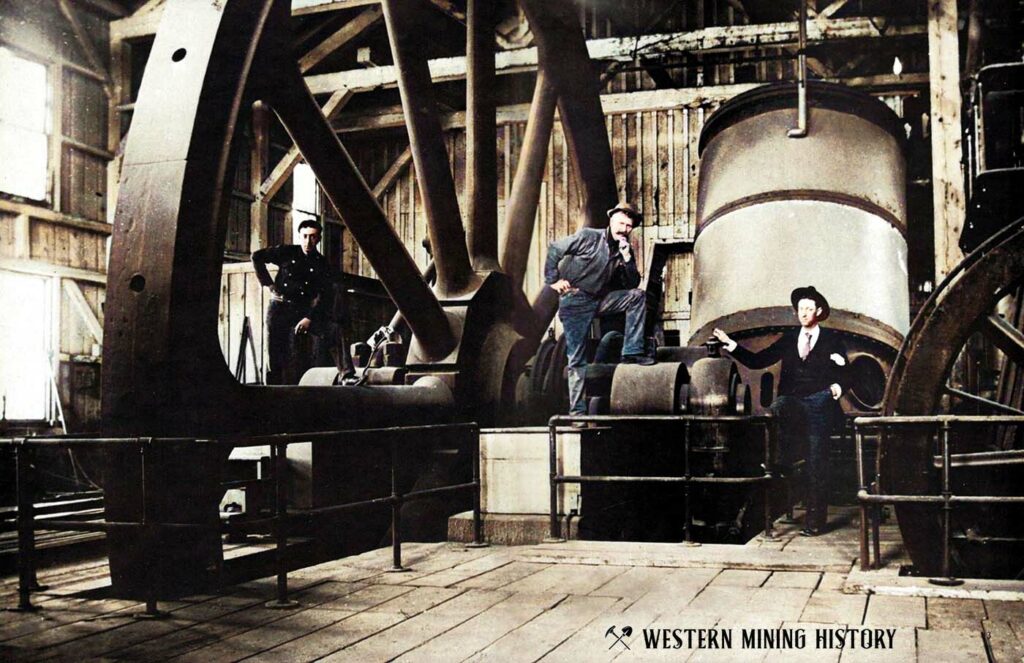
The mines of the Comstock Lode of Nevada were incredibly rich, but as they got deeper, both water and heat posed great difficulties that need to be overcome. No expense was spared to drive the mines ever deeper. Picture above is the Cornish pump that was installed at the Union Consolidated shaft at Virginia City. At the time it was the largest in the world and cost an astronomical $410,000 to install.
Scientific American described the pump as having “a flywheel 36 feet in diameter, which, with its shaft alone, weighs 208,700 pounds. The high-pressure cylinder is 64 inches in diameter by 6 feet 9 inches stroke, and the low-pressure cylinder 100 inches in diameter by 8 feet 6 inches stroke.”
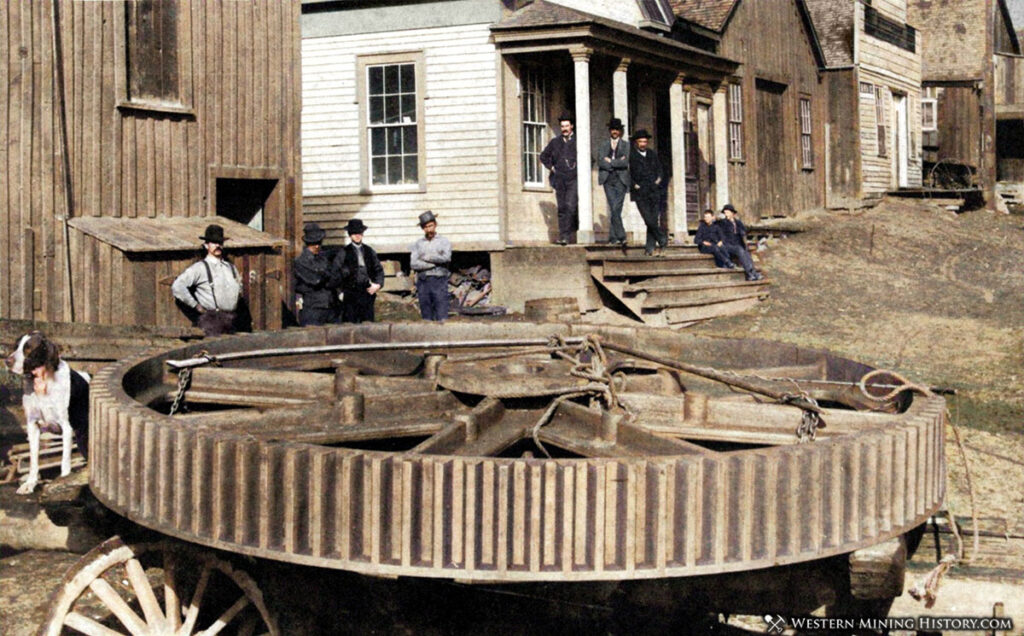
The July 19, 1879 edition of the Reno Gazette-Journal reported on a record-breaking spur wheel cast at Virginia City’s Fulton Foundry: “This afternoon at 4 o’clock a spur wheel was to be cast at the Fulton foundry, weighing 40,000 pounds. It is for the Belcher-Crown Point air shaft, and will be the largest casting ever made in the state.”
This image is only identified as a “Newly cast bull gear for a large hoist leaving the Fulton Foundry”, but it is likely this is the same gear, or at least a similar one, to that mentioned in the article.
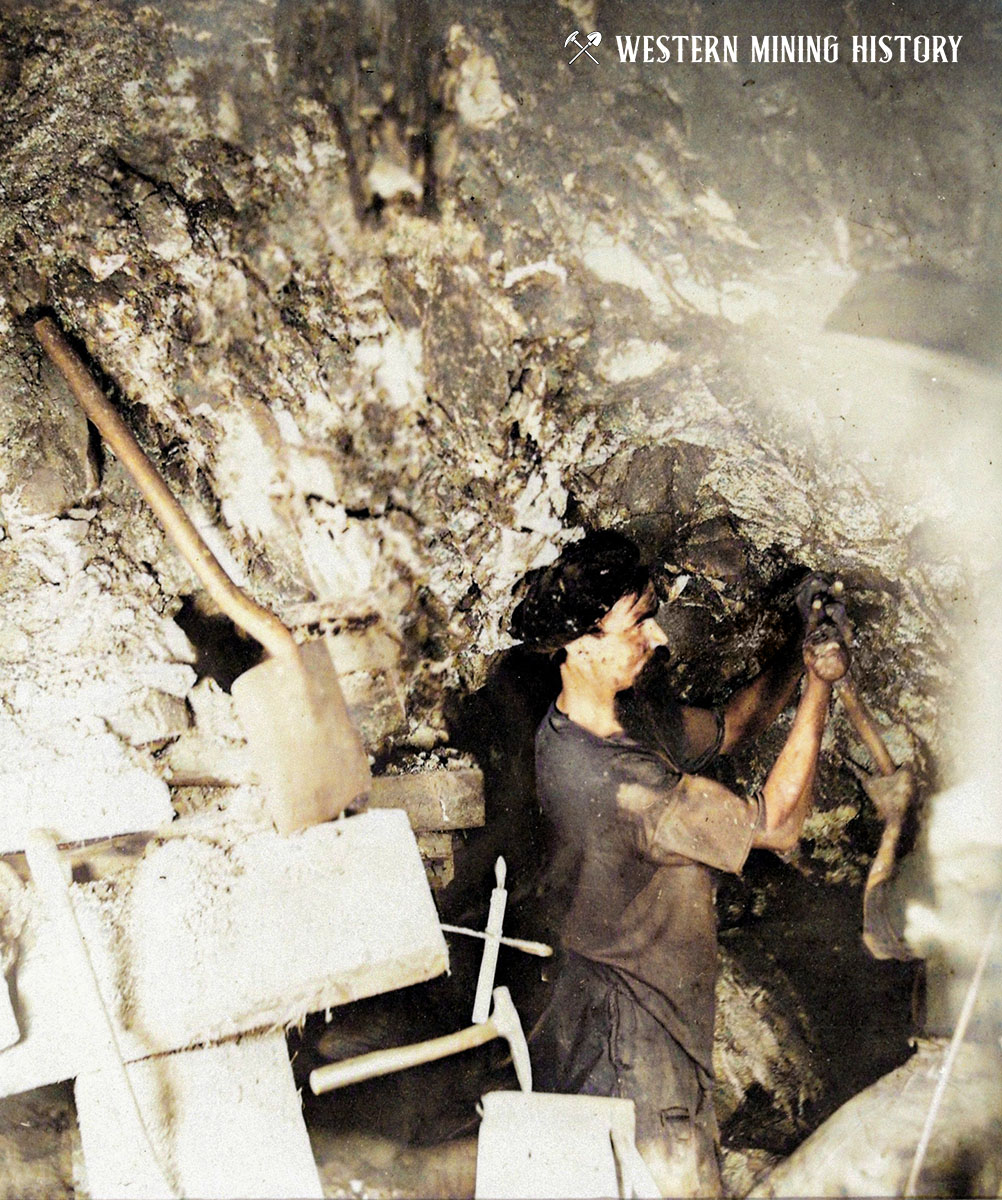
The photo above was taken by famous frontier Tomothy O’Sullivan at a Comstock mine ca. 1867, using the “glare of burning magnesium for a flash of light”. Depicted are two miners double jacking by candlelight. Double jacking is the process of drilling holes where one miner holds and turns a drill, while the other strikes it with a sledge hammer.
The Cripple Creek District
Cripple Creek, Colorado was the site of one of the West’s largest gold excitements in the early 1890s. Ultimately this district would be the second largest gold producer in the United States, and gold is still being mined here today.
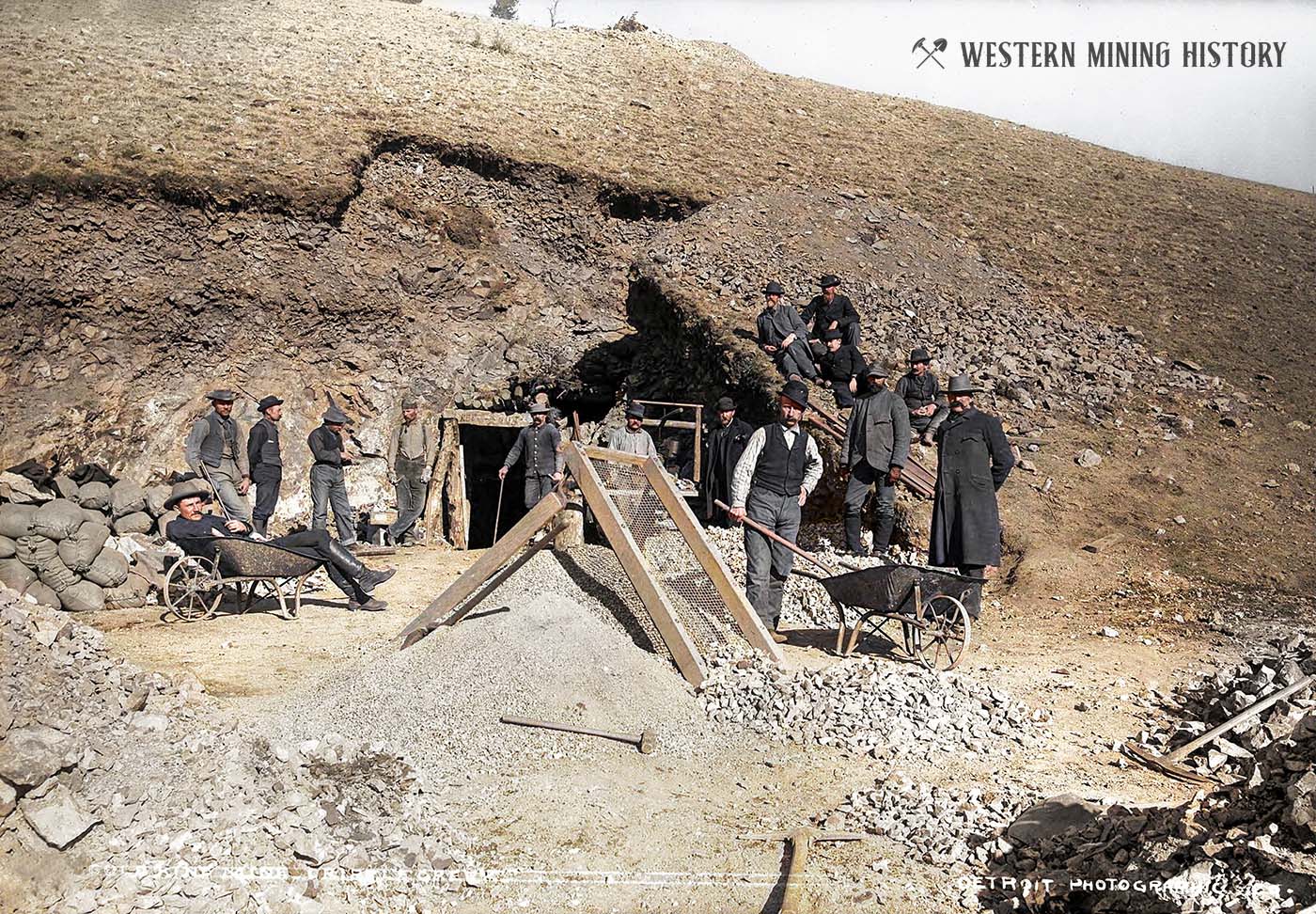
The Gold King Mine was one of the first mines discovered in the Cripple Creek district. Of the two men standing behind the wheelbarrow, the man on the right is believed to be Bob Womack, the man credited with the initial discovery of gold in the district.
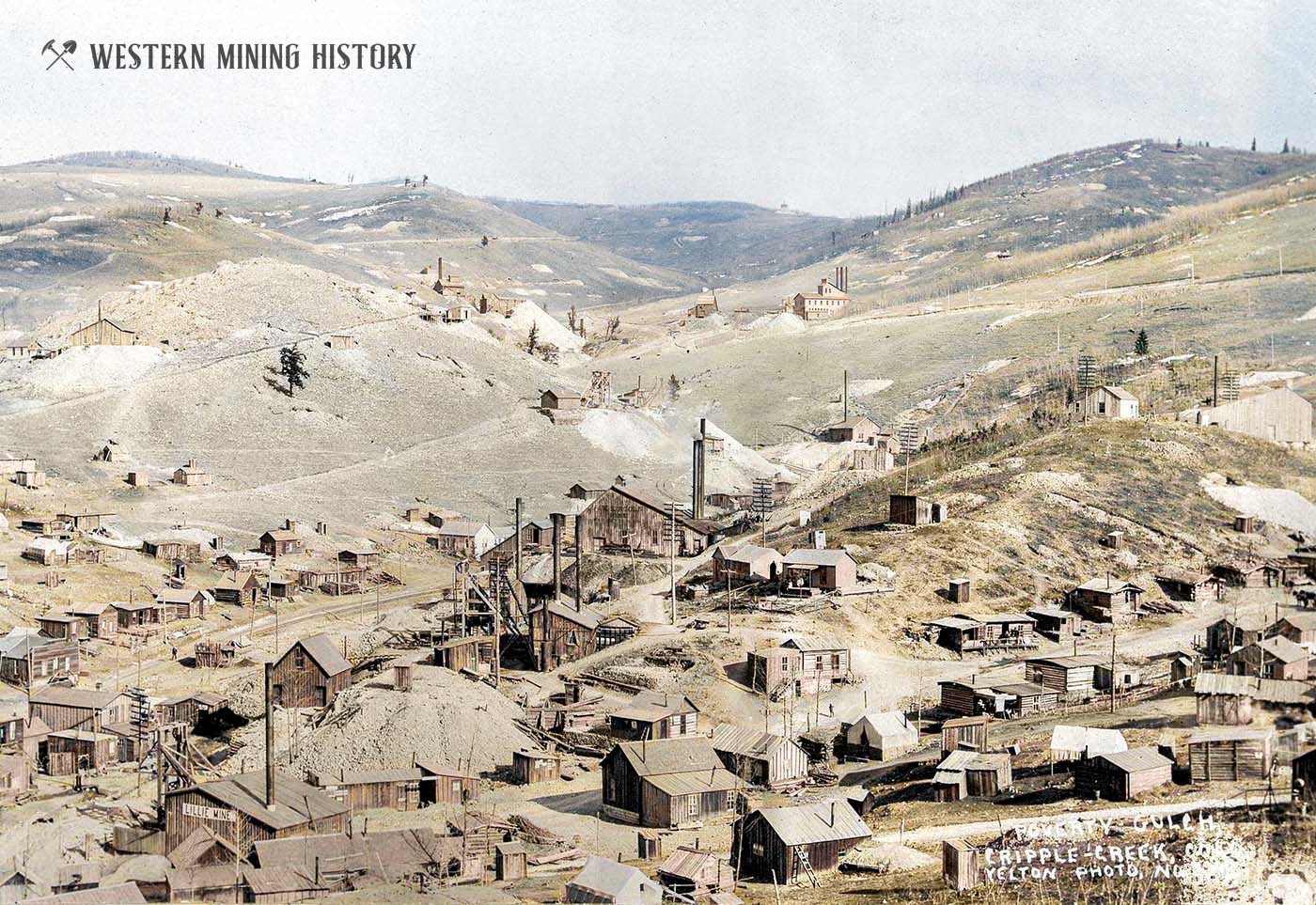
Poverty Gulch, just northwest of the city of Cripple Creek, was the location of many of the initial gold strikes that resulted in the gold rush in the area.
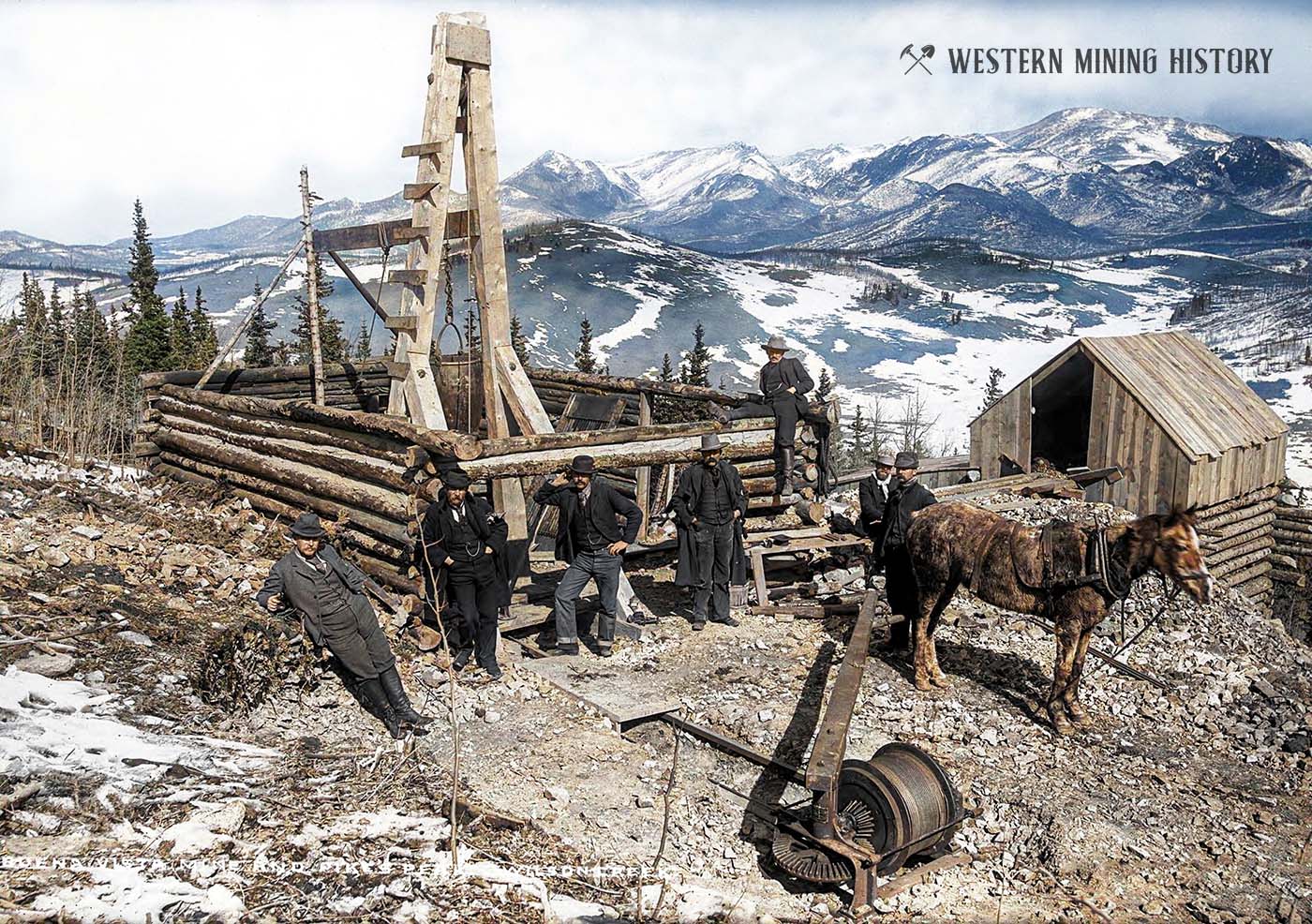
Rich gold mines were discovered throughout the district, and many communities formed near the mines. The photo above shows the Buena Vista mine near the town of Altman. Note the horse whim, crude headframe, and ore bin made of logs.
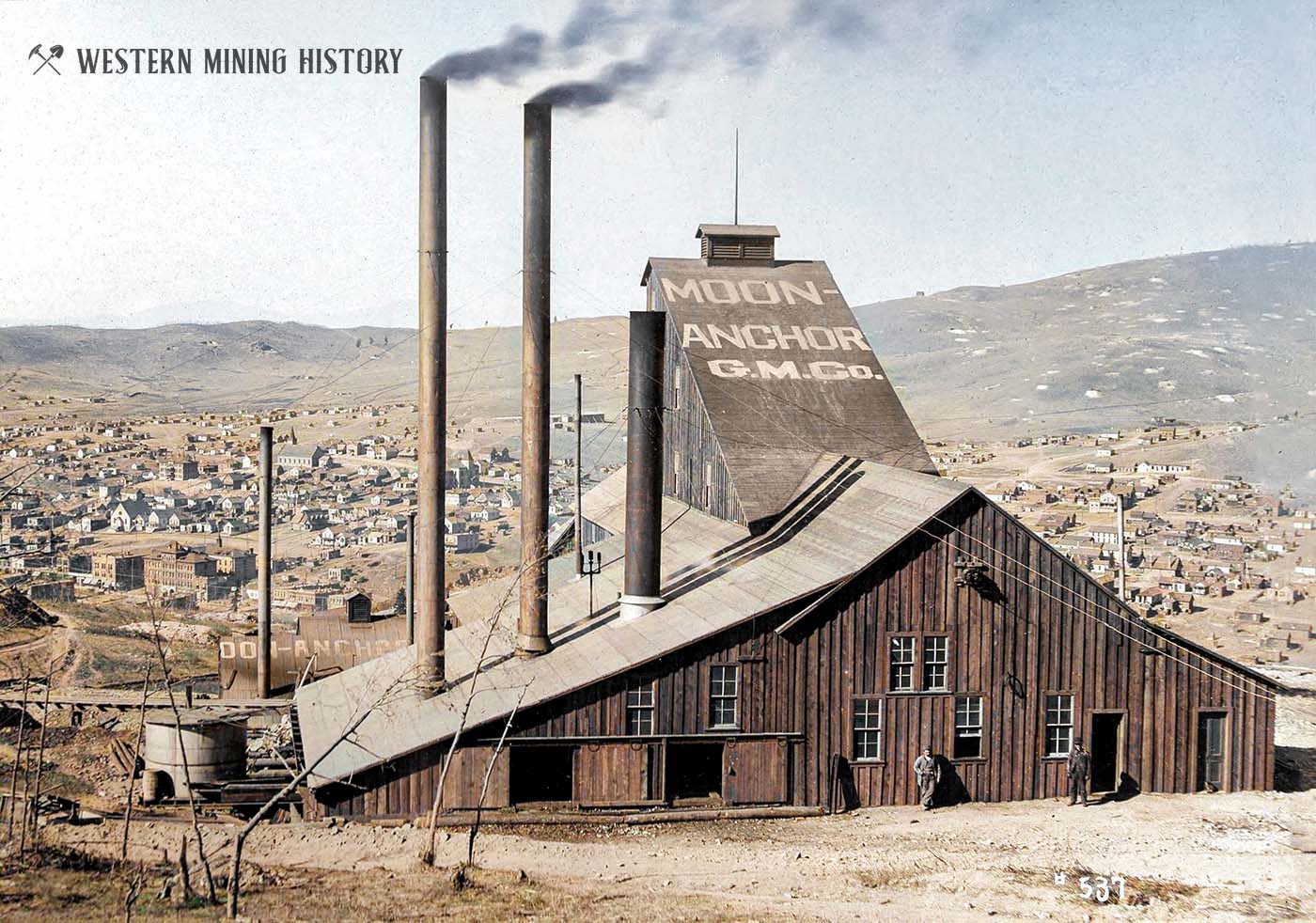
In this view the stamp mill of the Moon-Anchor Mining Company sits on a hill overlooking Cripple Creek.
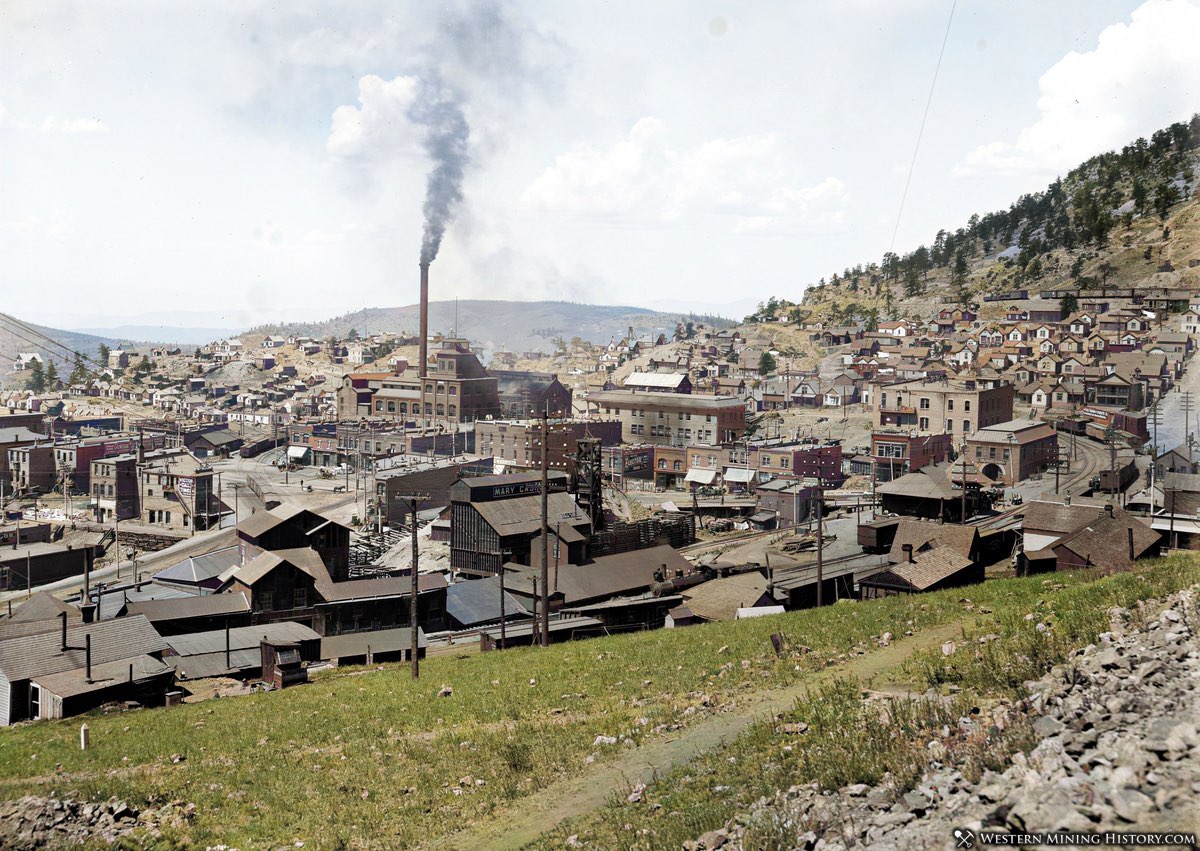
Victor, Colorado is seen here ca. 1900 with the Gold Coin mine in the center of the photo. Known as the “City of Mines”, victor was the second most important city in the Cripple Creek mining district, and where a significant number of the district’s miners called home.
Miner’s Cabins
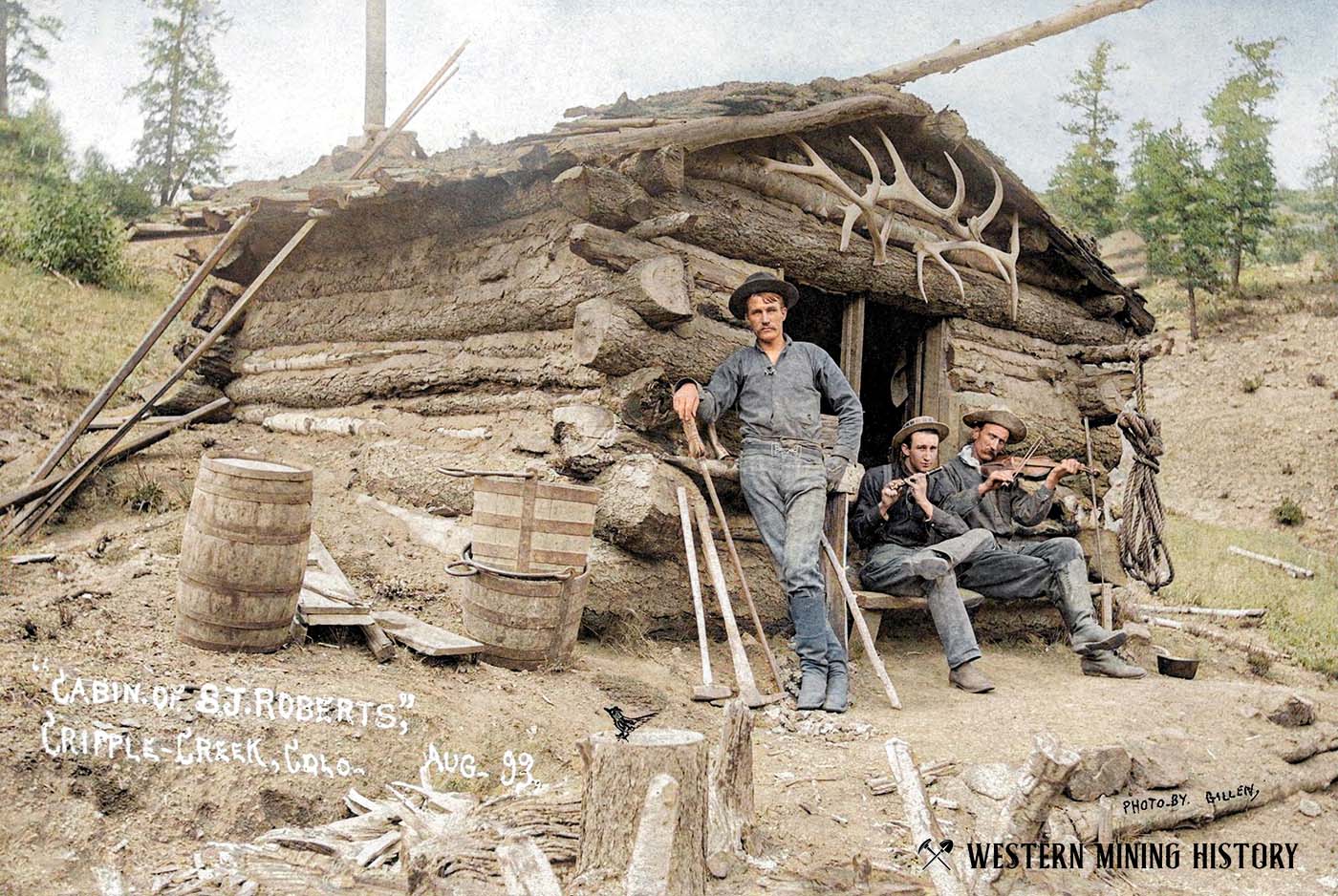
At Cripple Creek, early miners on the scene lived in crude cabins like the one in the photo above, but within a few years Cripple Creek has become a significant city and industrial center.
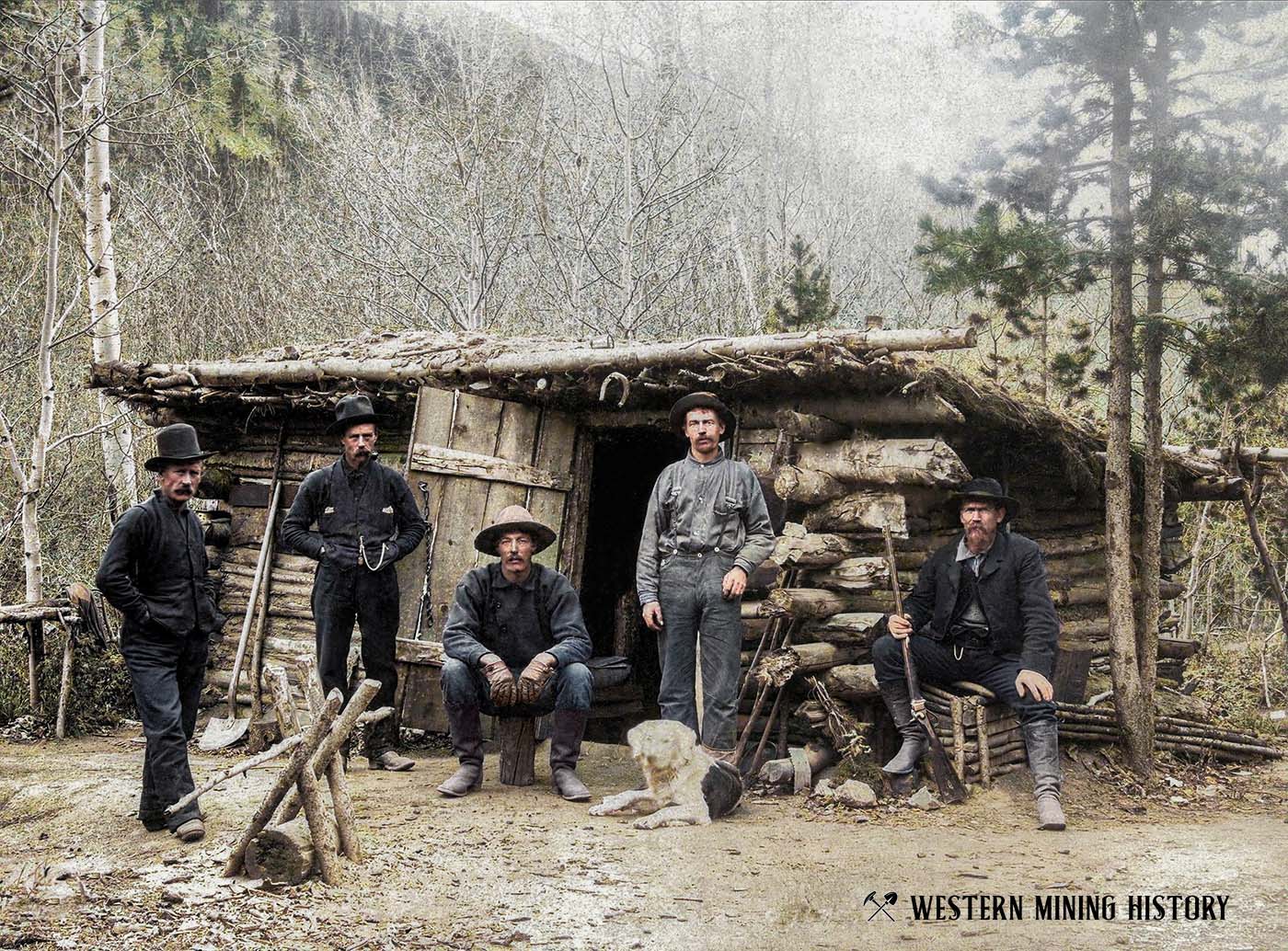
This group of prospectors mean business outside of their Colorado log cabin. In addition to being companions, dogs often had the job of guarding the cabins while the miners were working the mines.
Silver City, Idaho
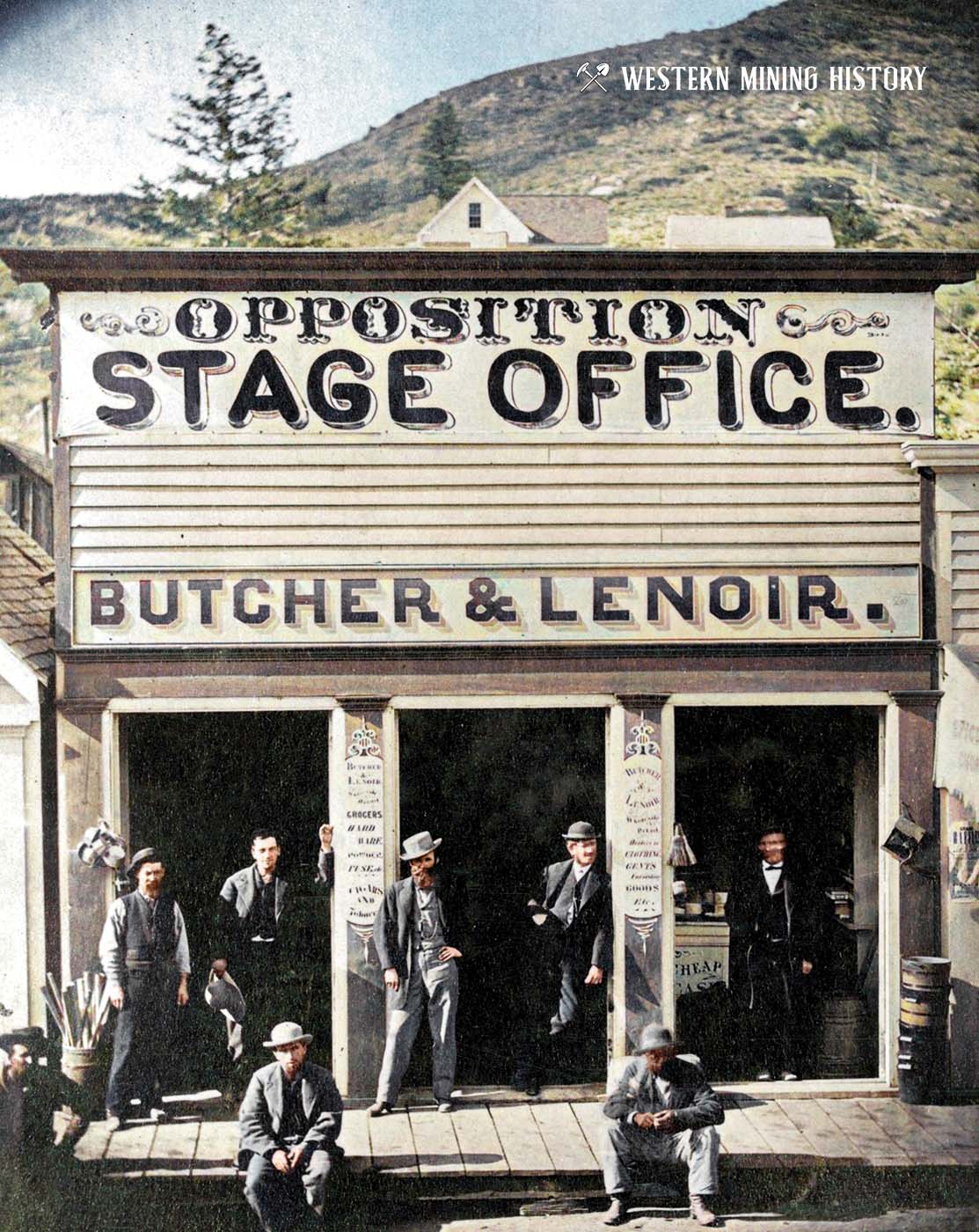
Butcher & Lenoir Opposition Stage Office – Silver City, Idaho 1868. This was the year of the “Owyhee War”, when armed gangs fought bloody battles, some underground, for control of one of the district’s richest mines.
Miners Operating a Drill in the Camp Bird Mine
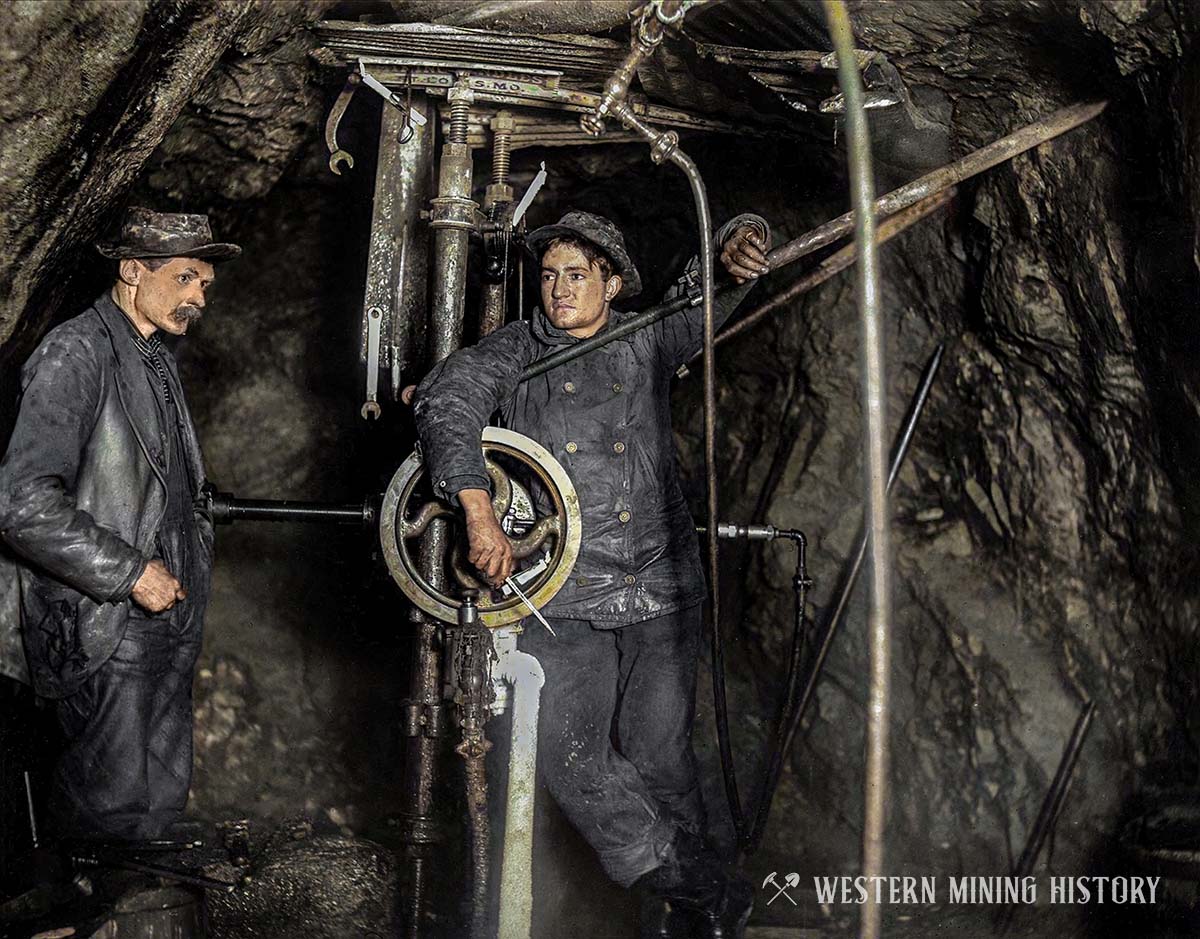
The Camp Bird mine near Ouray, Colorado was one of the state’s richest mines. In 1899 the Silverite-Plaindealer called Camp Bird “The Greatest Gold Mine in Colorado or the Whole Earth”. By the end of 1900 the mine consisted of 103 mining claims on 941 acres, and had twelve mills in operation.
Auburn, California Steam Tractor
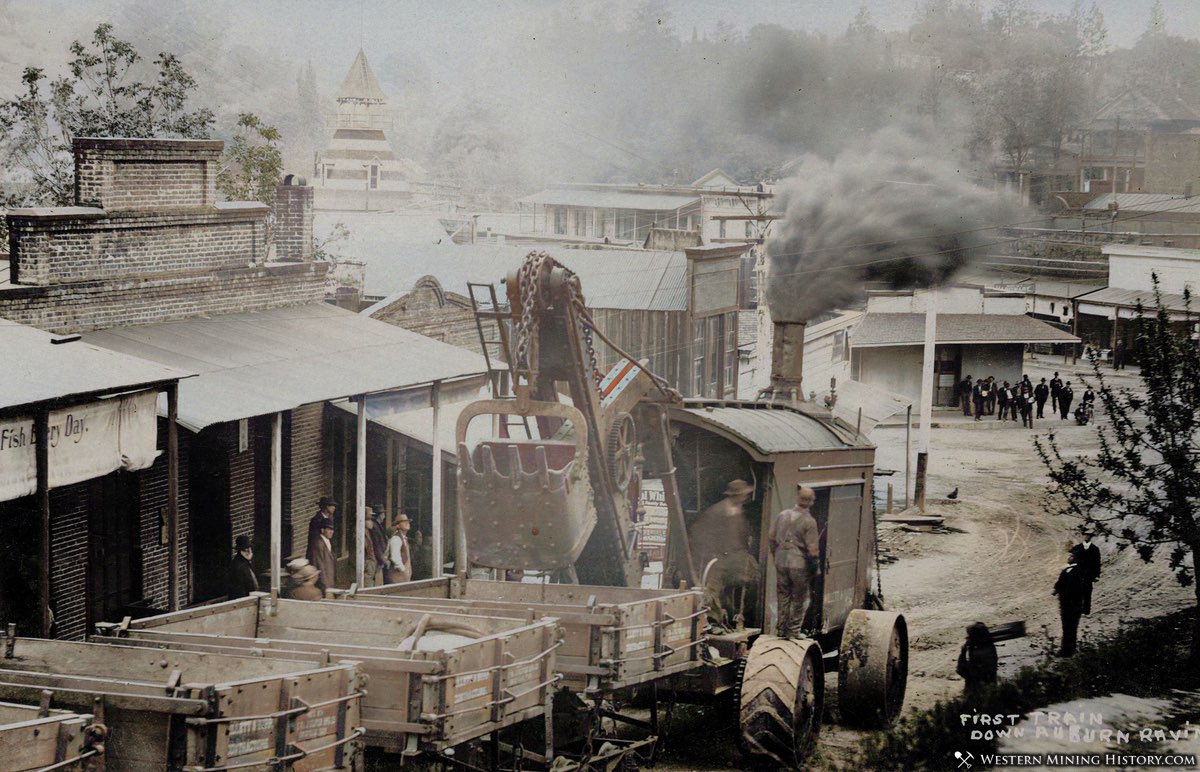
Dating back to 1849, Auburn, California is one of the West’s oldest gold rush towns. This photo depicts a steam shovel pulling wagons through Auburn’s historic downtown – likely in the first decade of the 1900s.
Stagecoach at the Beaumont Hotel – Ouray, Colorado
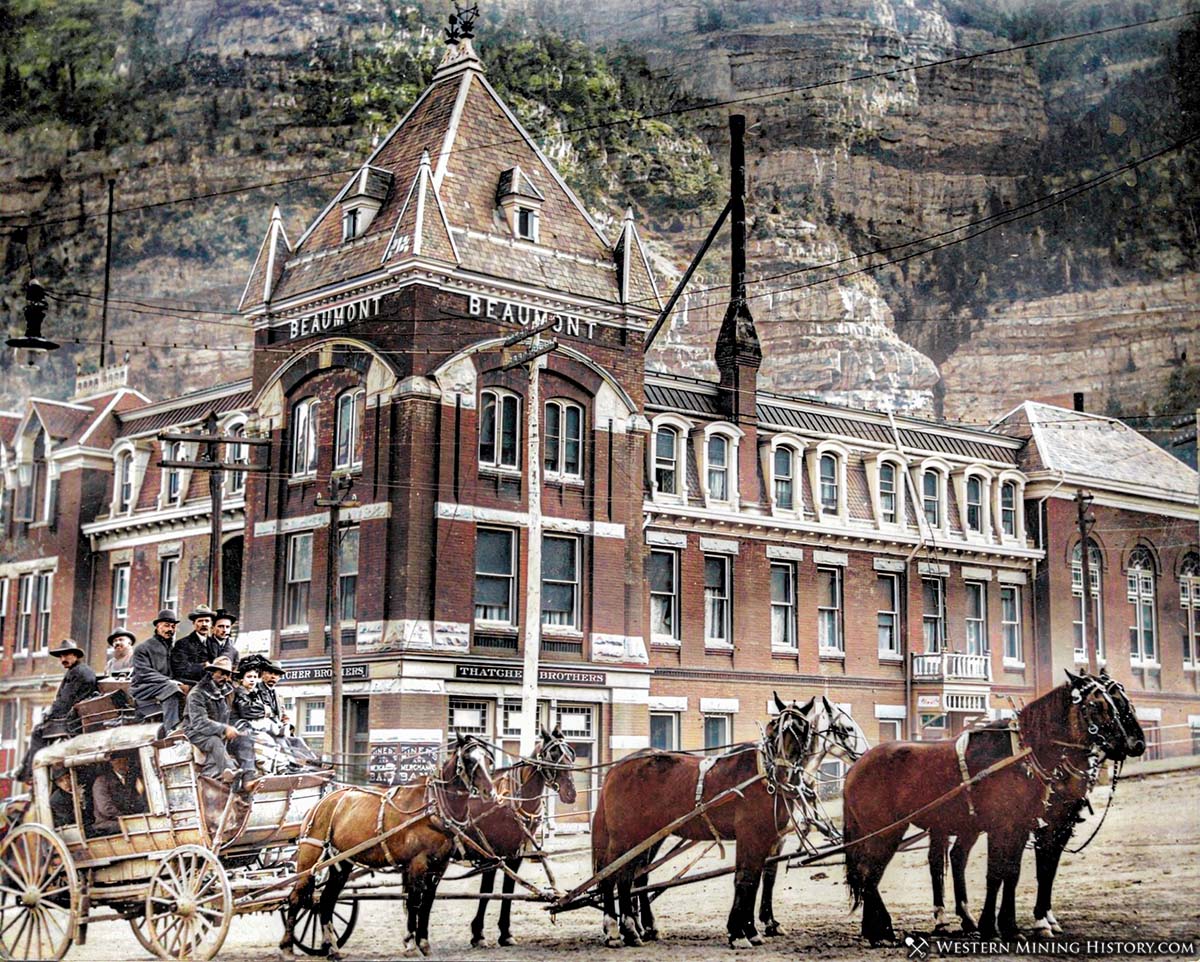
While the stagecoaches were often traversing what was a great wilderness at the time, arrival at one of Colorado’s mining boom towns was quite a contrast to the surrounding territory. The modern Beaumont Hotel in Ouray, Colorado offered travelers luxurious accommodations at the end of a long journey.
Placer Miners at Auburn Ravine
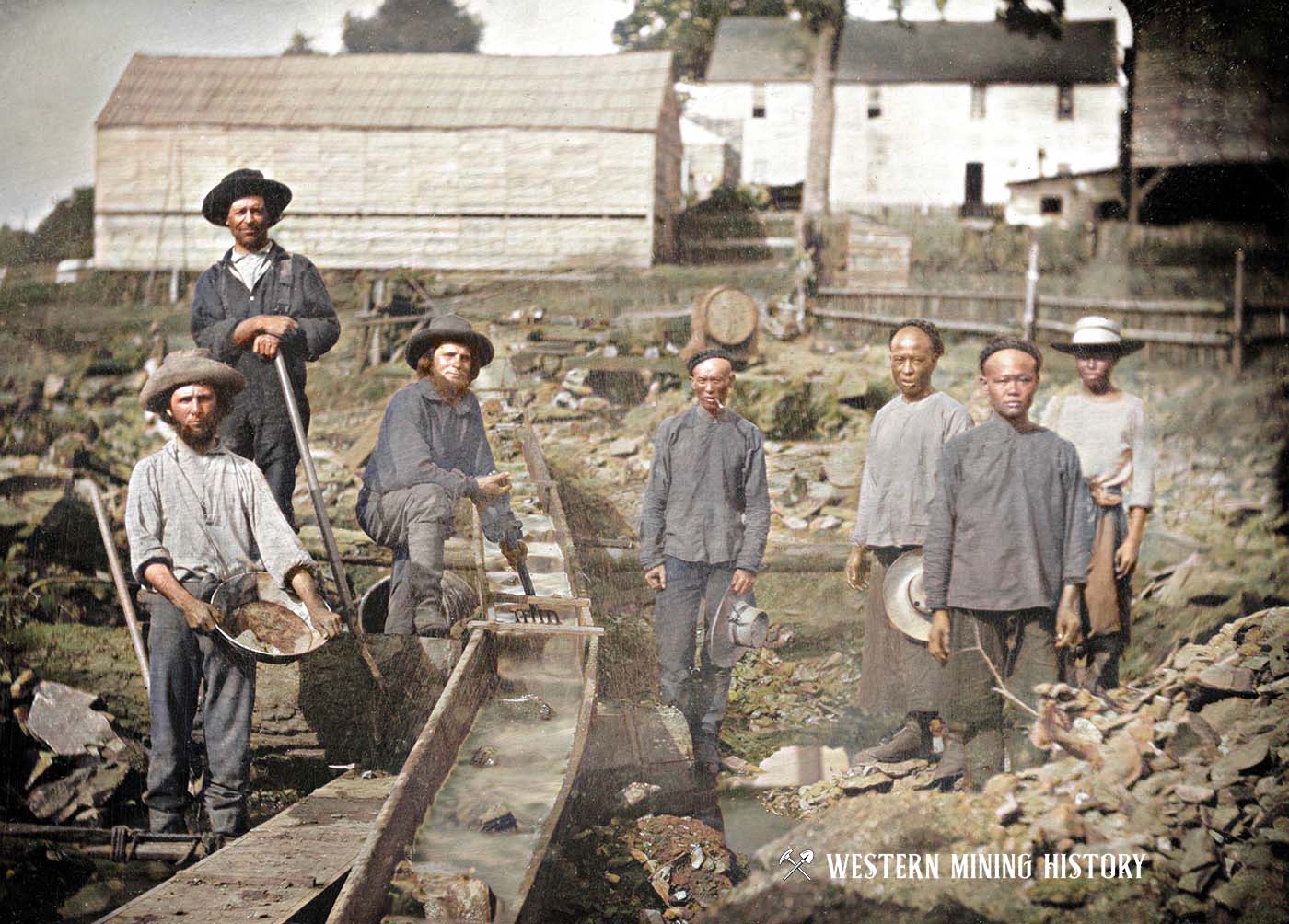
Placer miners, including four Chinese, pose at a sluice at Auburn Ravine, near the town of Auburn in Northern California. This ca. 1852 photo is one of the earliest and most notable images of gold rush miners in California.
Miners at a California Placer Operation
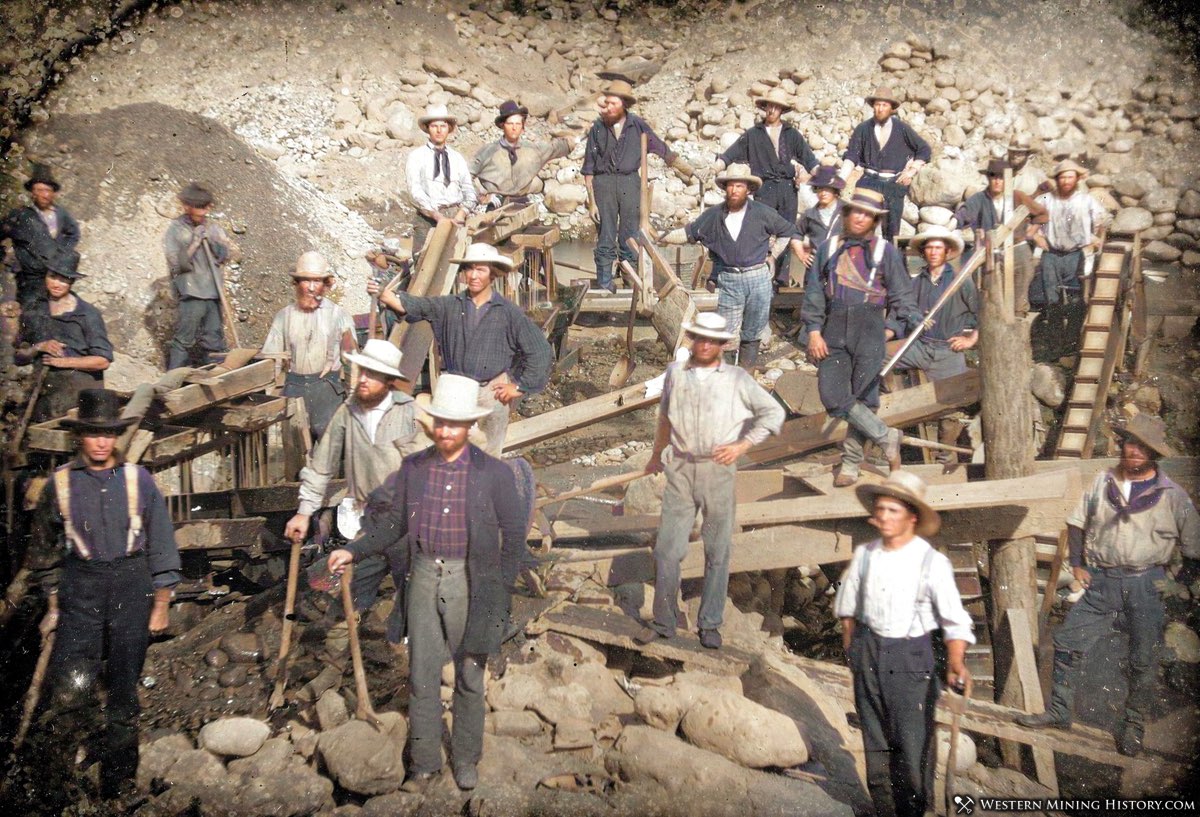
This daguerreotype photograph captures an early placer mining scene in California, with 23 miners pausing their work to pose for the photo.
Crew of the Blue Gravel Hydraulic Mine
This ca. 1890s image of the Blue Bucket hydraulic mine, located in Siskiyou County, California, depicts a tough crew of miners that are dressed for a hard day’s work, in very wet conditions.
Freighting Outfit at Rico, Colorado 1890
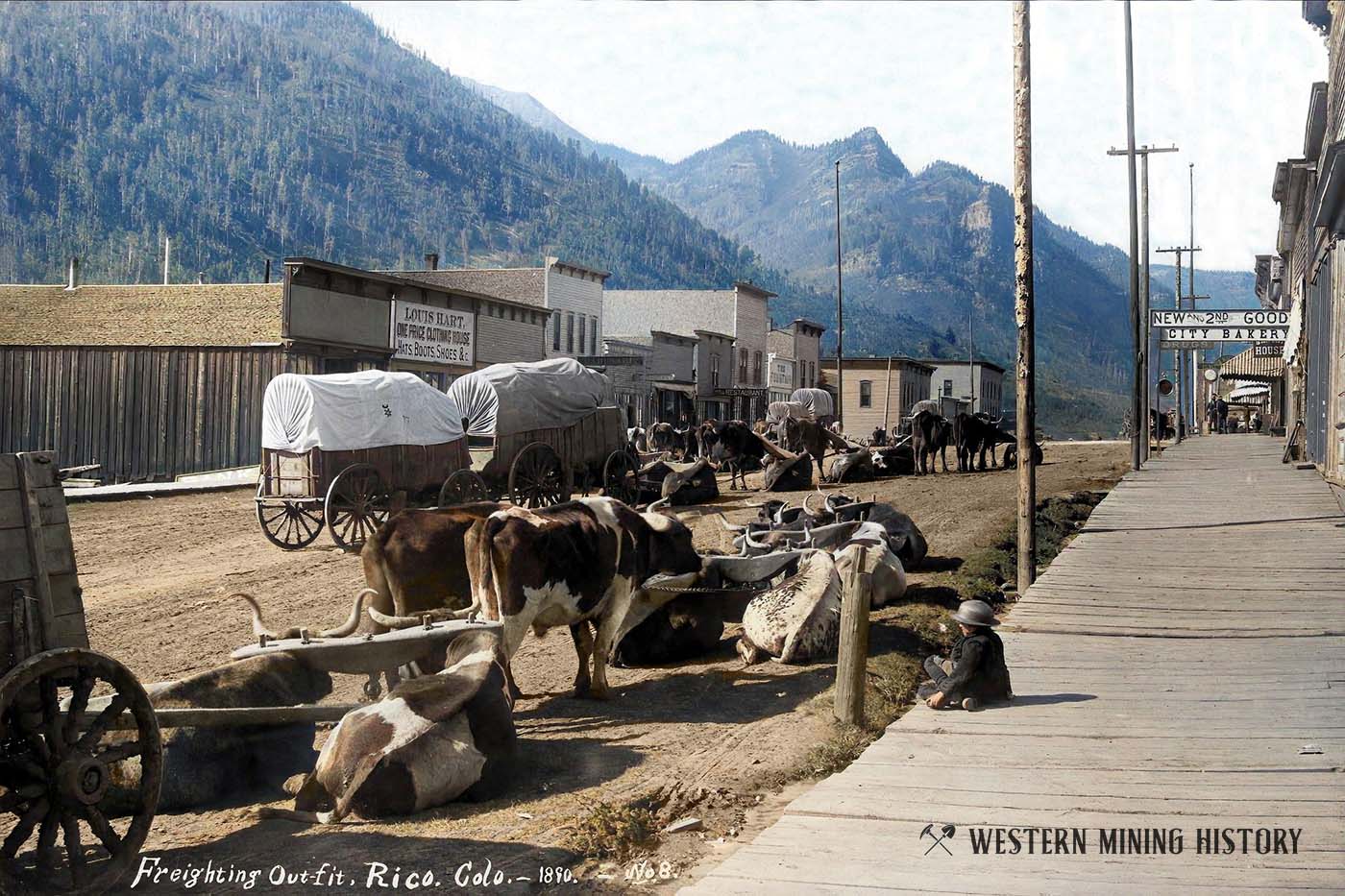
The image above, titled “Freighting Outfit, Rico Colorado – 1890” depicts teams of oxen pulling freight wagons at Rico, Colorado in 1890. Development of the mines at Rico was long-hampered by its remoteness and lack of transportation infrastructure. In 1891, just one year after this photo was taken, the railroad finally arrived at Rico, and the district experienced a new level of prosperity.
Mount Diablo Mine Ore Bin
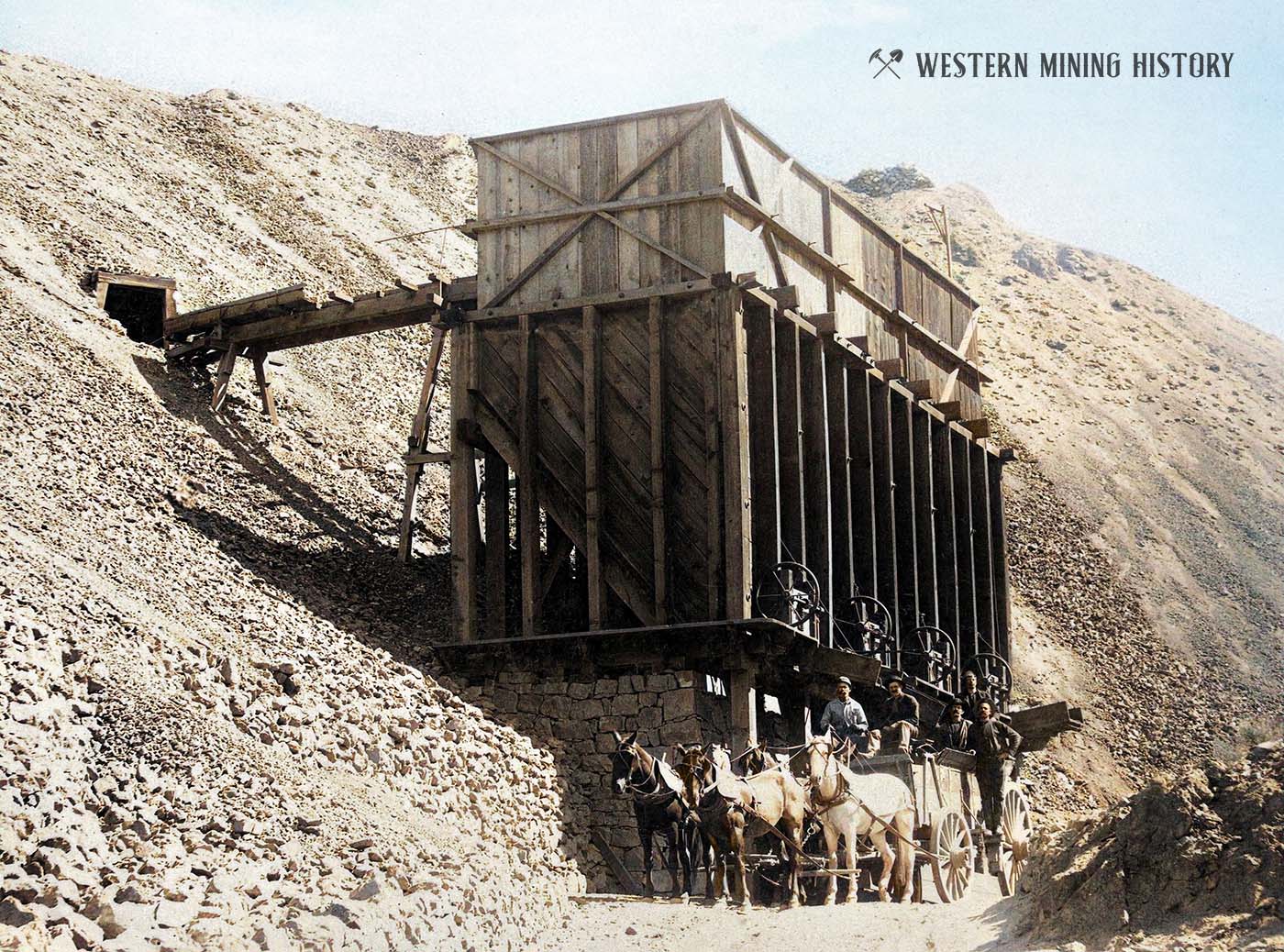
This ca. 1900 image shows a freight wagon in position to be loaded with ore from an ore bin at the Mount Diablo mine at Candelaria, Nevada.
Independence Day Parade at Central City, Colorado
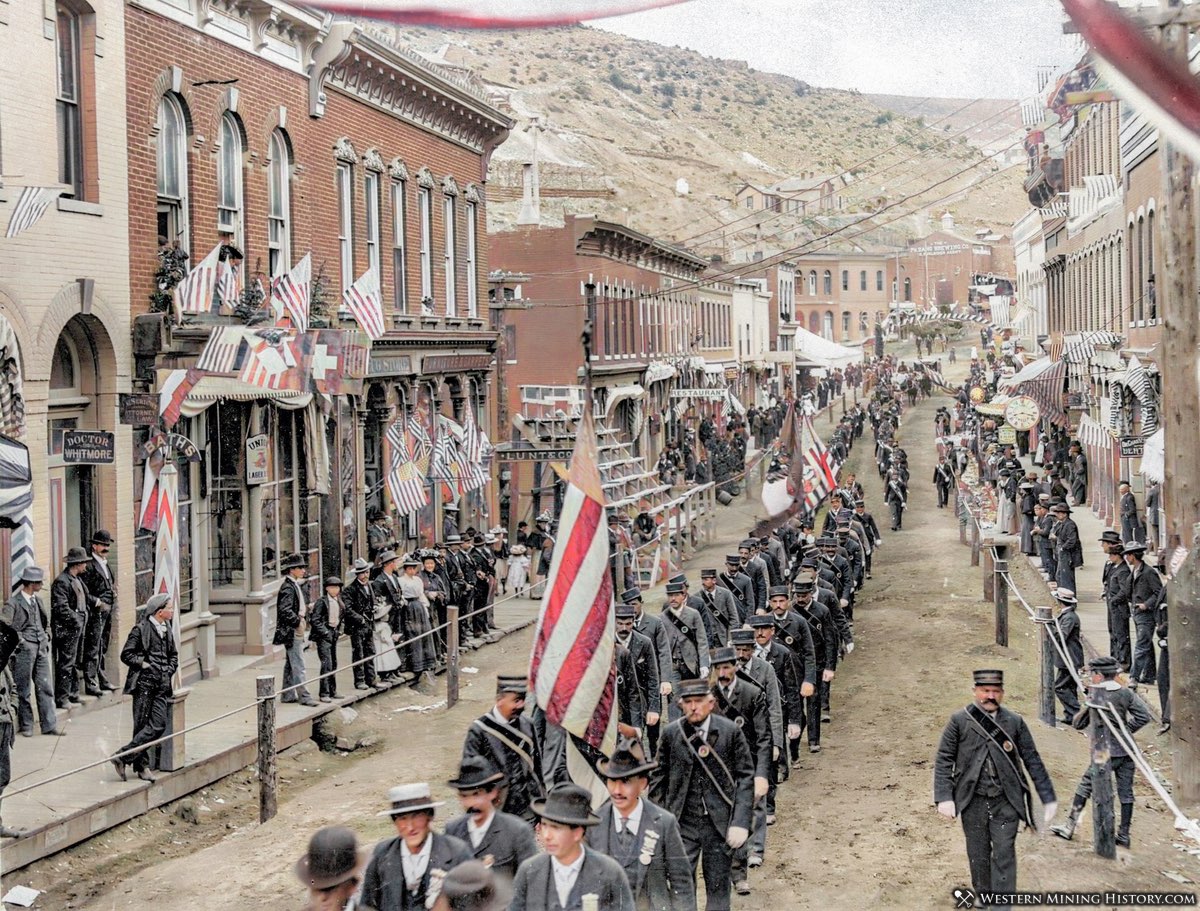
Central City, Colorado was the state’s first important mining center, and was the center of the richest mining district for two decades. Leadville and other locations became more important starting around 1879, but Central City remained an important mining city for many decades.
Miners Taking a Lunch Break at the Chance Mine
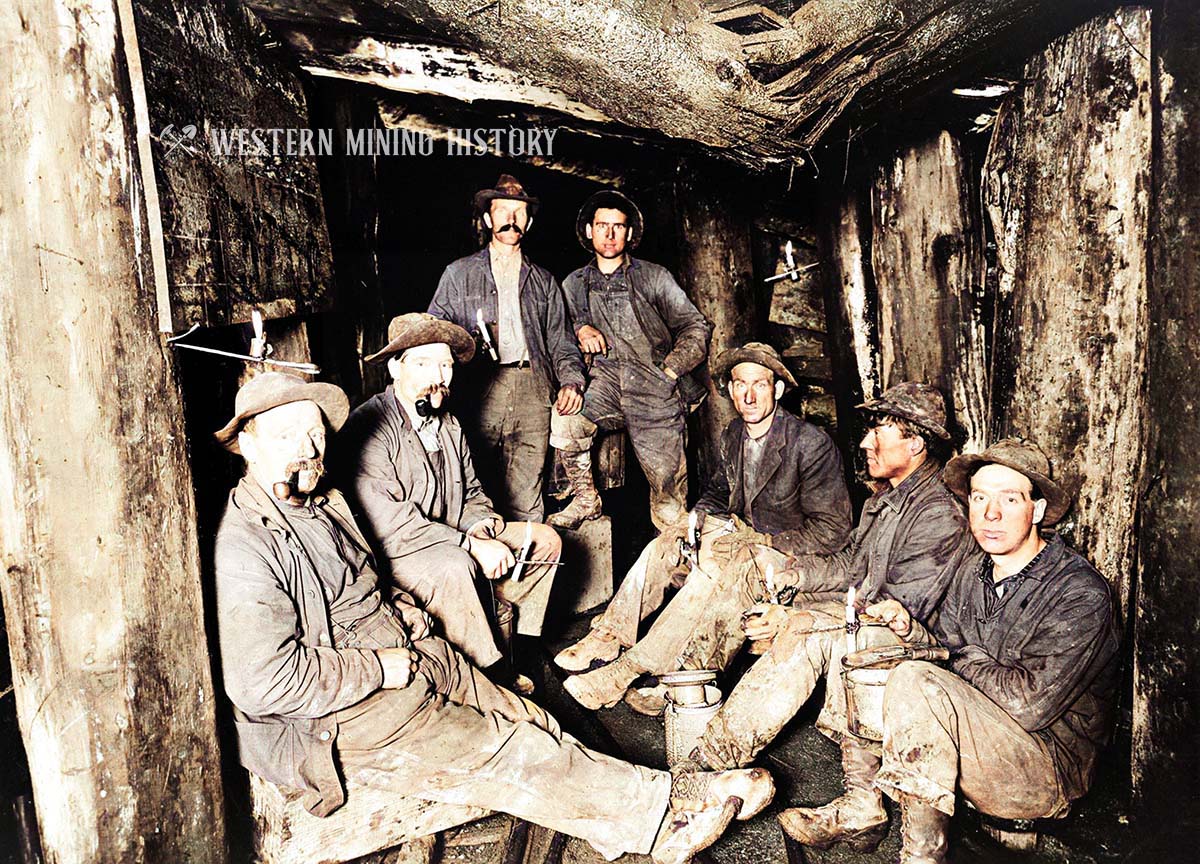
Miners at lunch break in the Chance mine. The Chance is a silver mine located in Shoshone County, Idaho, in a region known as the “Silver Valley”. The Silver Valley is the top silver producing region in the United States, and second in the world.
“Going to Work” – Kellogg, Idaho
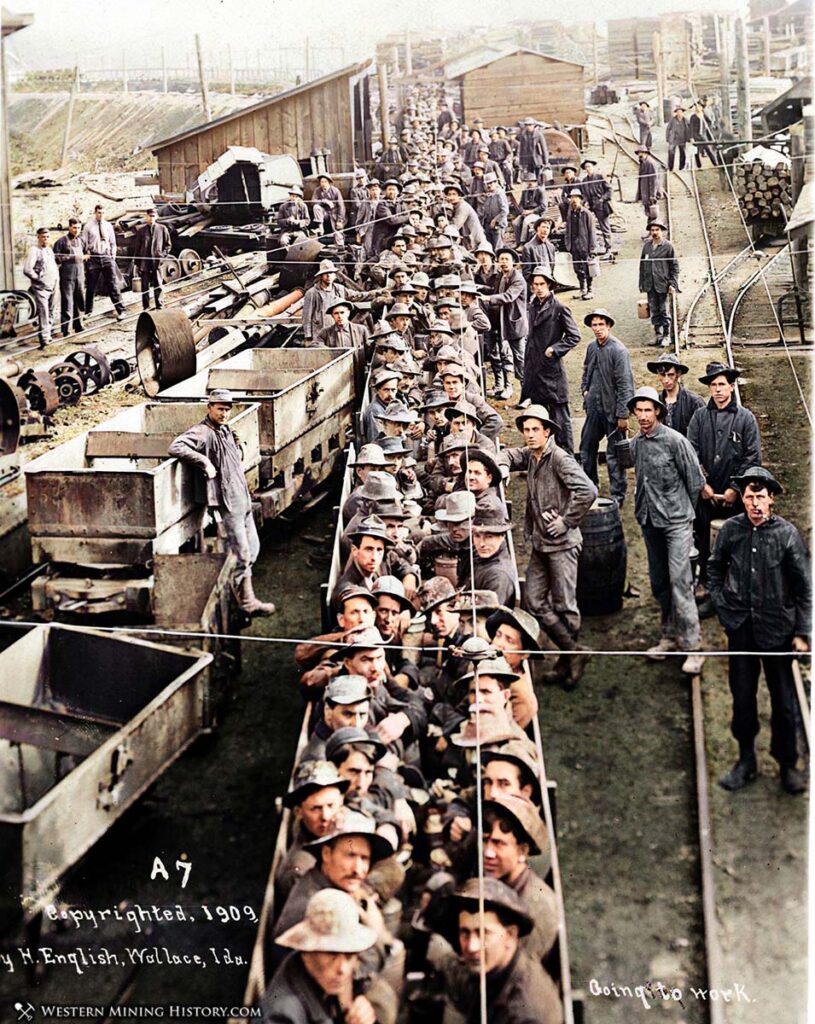
This incredible photo titled “Going to Work” depicts miners riding ore cars into a mine – probably the Bunker Hill in Kellogg, Idaho. This mine is in a region known as the “Silver Valley”, which is the top silver producing region in the United States, and second in the world.
Timbering and Miners in the Bagdad Mine
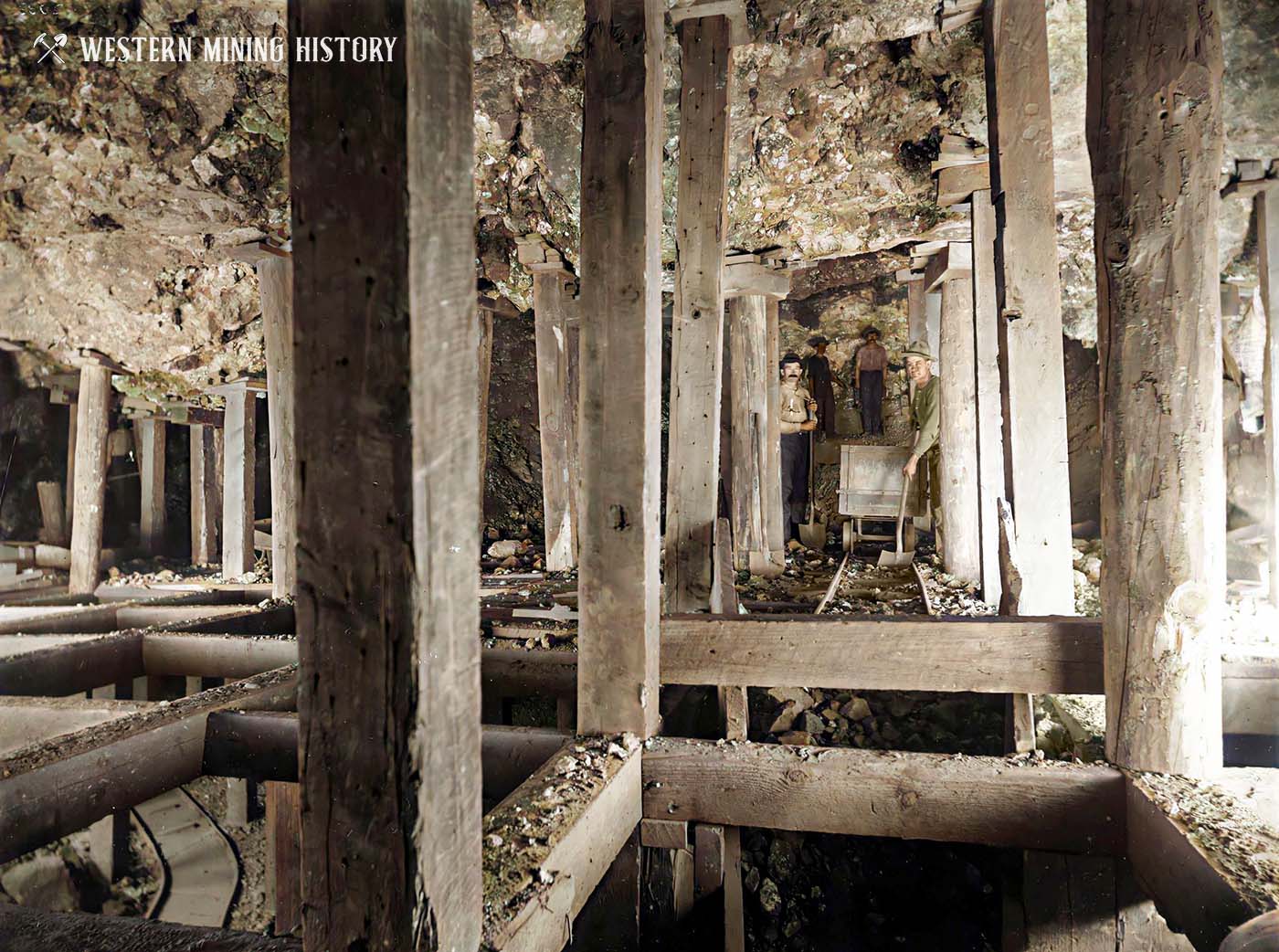
This incredible 1910 photo depicts miners and square-set timbering in the Bagdad mine near Ludlow in Southern California. The Bagdad mine (also known as the Bagdad-Chase) was discovered in 1903 and produced primarily gold and copper.
B.Ware and I.Steele Pawn Brokers
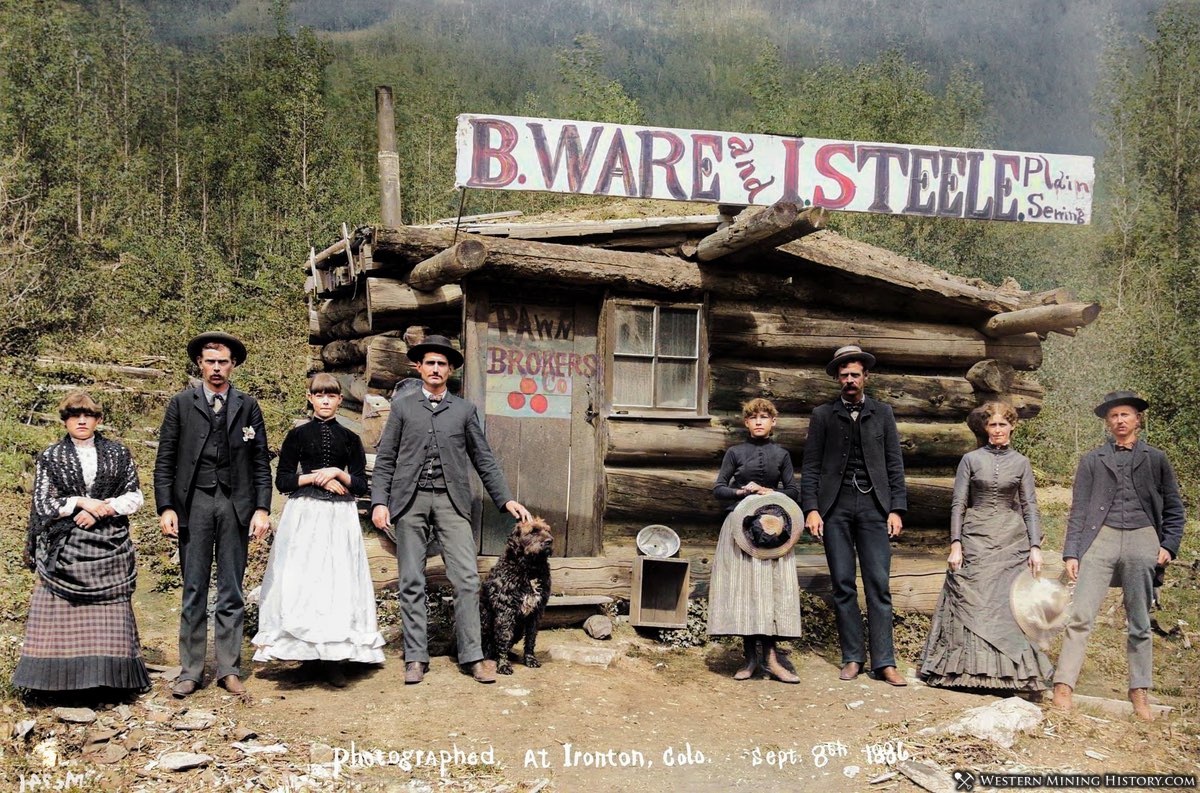
Ironton was a major transportation junction and mining camp between Red Mountain Town and Ouray in southwest Colorado. The photo illustrates that despite the difficulties of life in these frontier towns, the citizens still displayed a sense of humor.
Thompson`s Dry Diggings at Yreka Flats
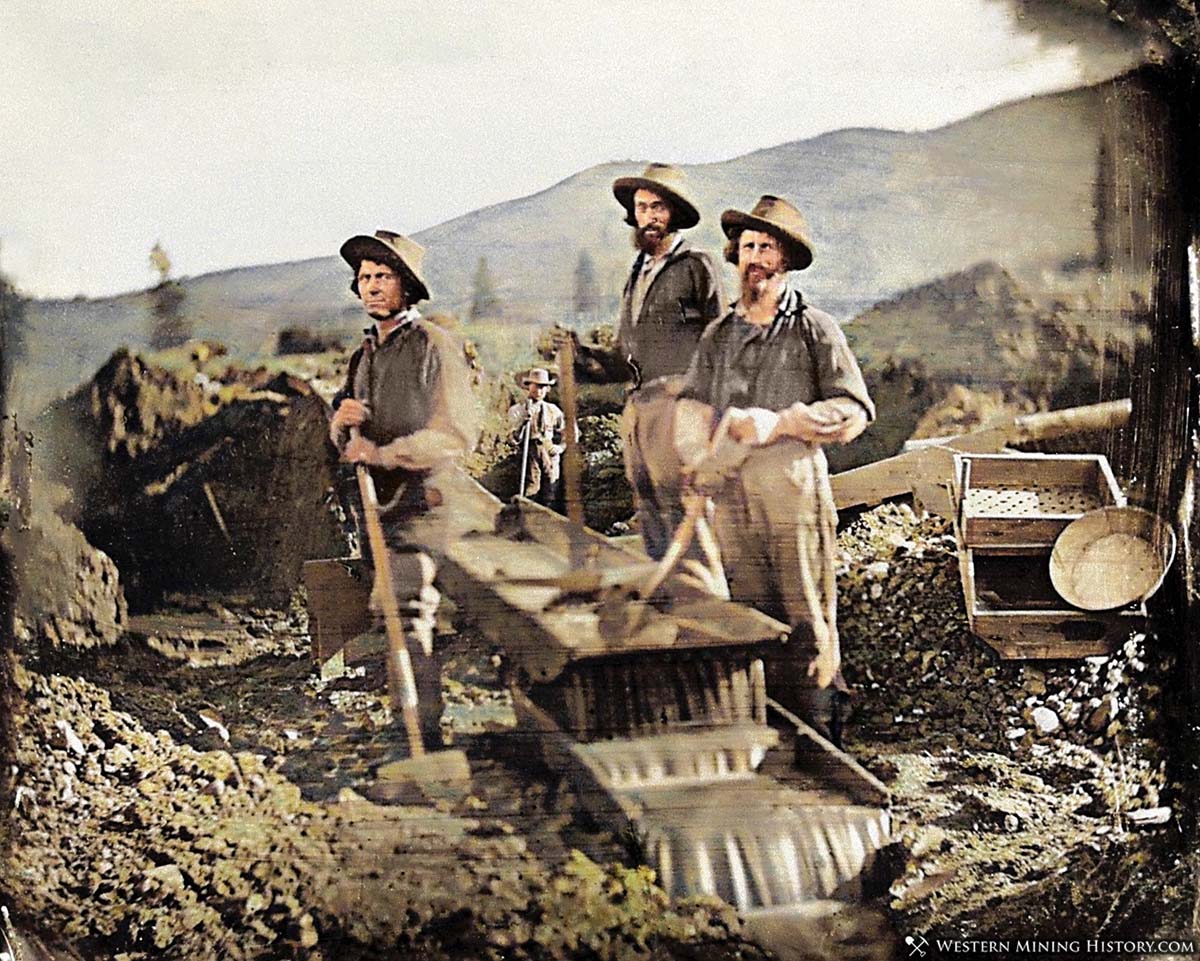
This iconic photo captures one of the earliest scenes from the goldfields of northern California. The photo depicts Abraham Thompson (on left) and partners using a long tom at Thompson`s Dry Diggings on Yreka Flats 1851. The town of Yreka was established at this location.
Incline Shaft of the Elkhorn Mine
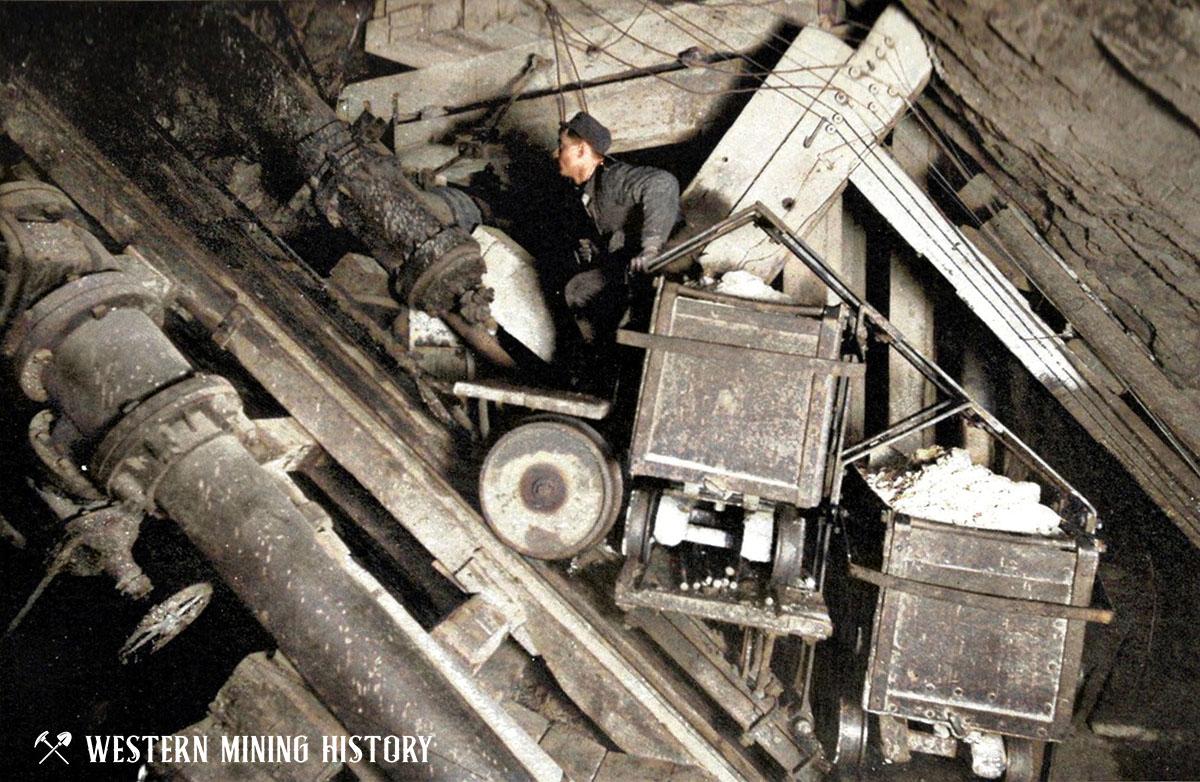
Montana’s Elkhorn Mine, located in the town of Elkhorn, was one of the West’s greatest producers of silver. This historic image shows a miner riding with ore cars up the mine’s incline shaft. The USGS publication that contained this photo included the caption “Shows methods of timbering station, arrangement of pump pipes, and method of hoisting ore on two platform skips; slate “hanging wall” is seen above the skip.”
Juneau, Alaska
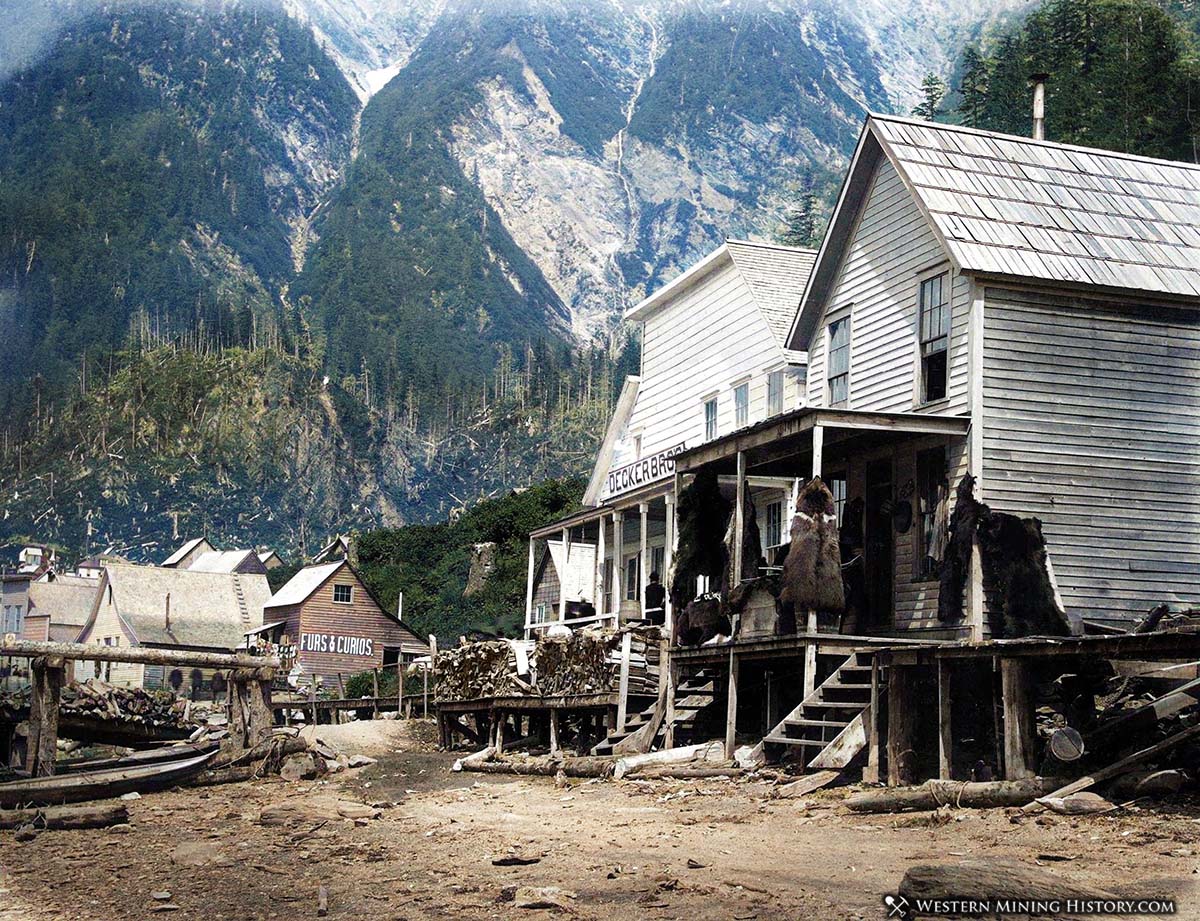
Juneau, Alaska was first settled after gold discoveries in 1880. The initial settlement was called Harrisburg, then was changed to Rockwell, and finally Juneau. The district would become Alaska’s leading producer of lode gold.
Gold Dredge Crew at Hammonton
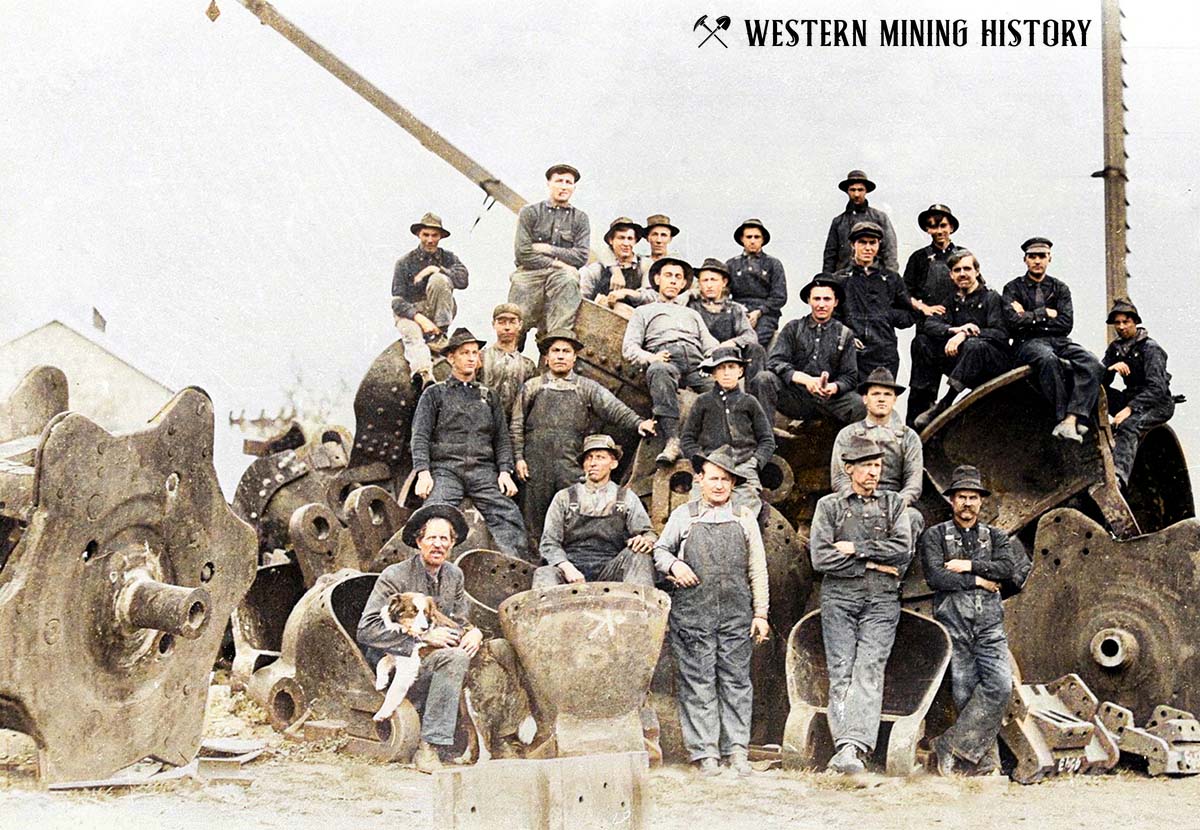
Hammonton, California was the center of the Yuba Goldfields; a dredging region that was one of the top gold producing areas in the nation. This circa 1905 photo depicts a dredge crew posing among the buckets of a massive dredge line. Note the man in the front holding a dog.
California Borax Mining
Mojave Desert borax was first made famous in the late 1800s by by the twenty mule team wagon trains that were used to transport it across the desert. The ore wagons were 16 feet long, 4 feet wide, 6 feet deep, and weighed 7,800 pounds when empty.
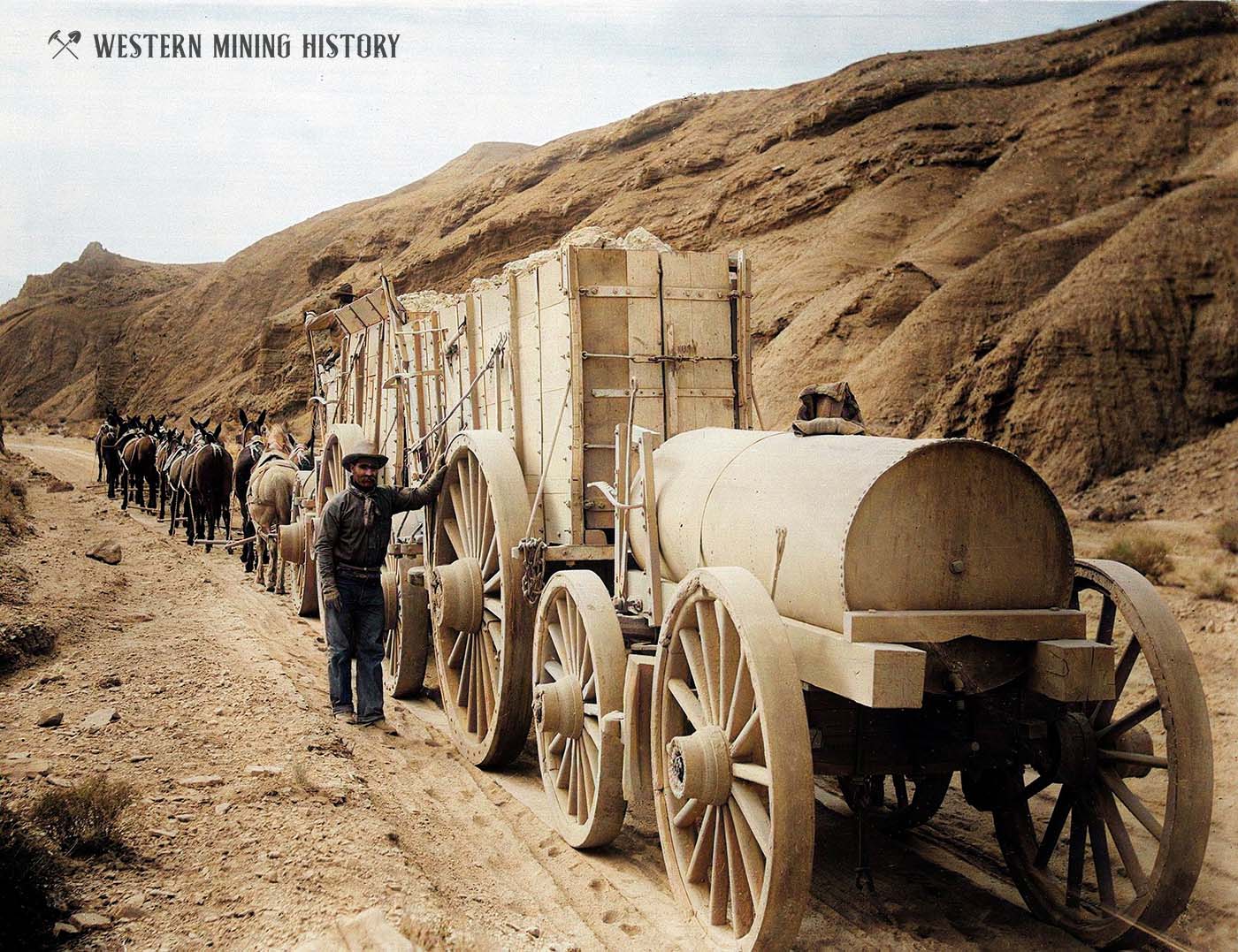
By the mid1890s, attempts were made at replacing the teams with steam powered traction engines, as seen below. These machines were not as reliable as the mule teams however, and never completely replaced them.
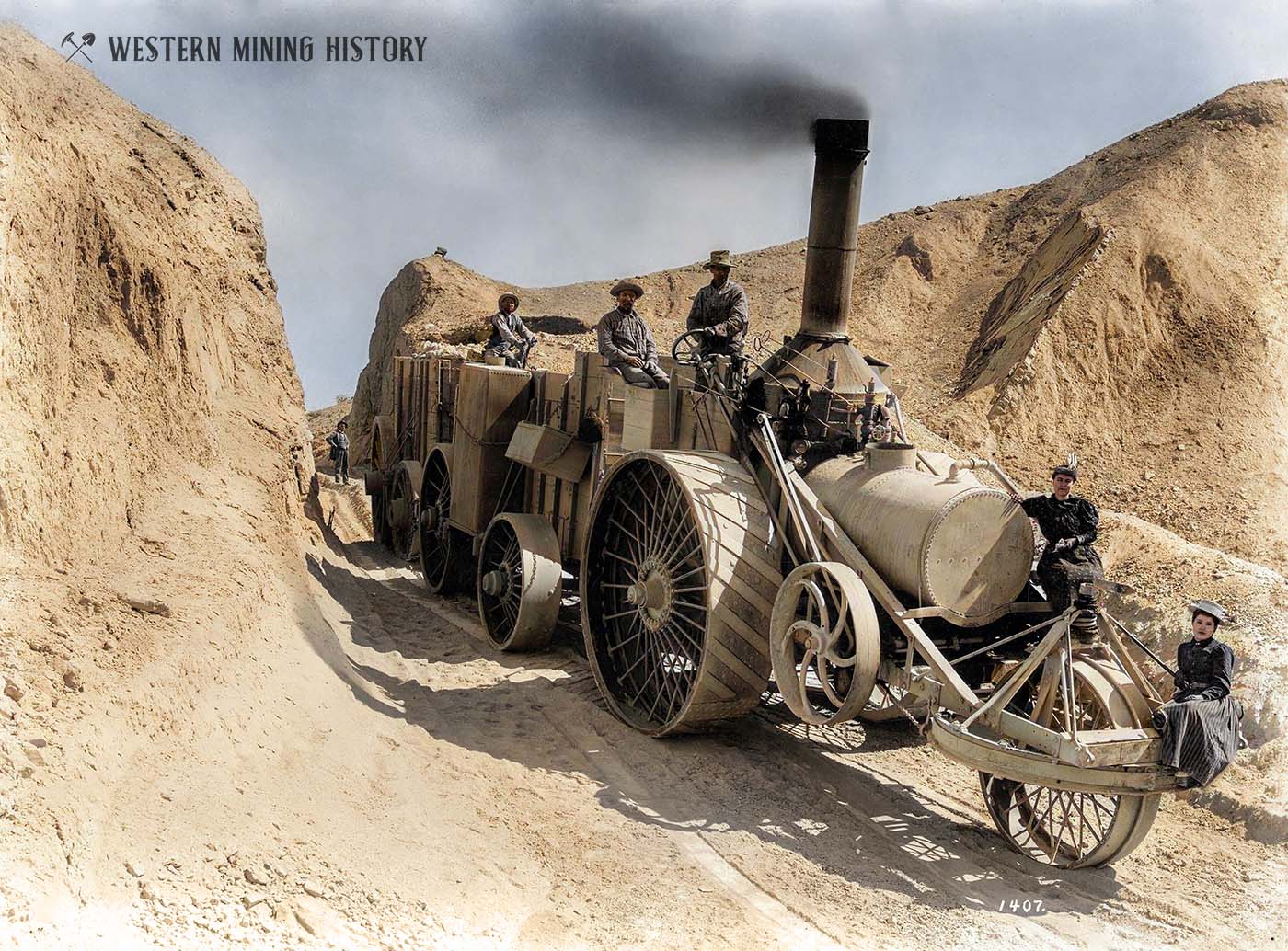
Water Wagon at Fairbanks, Alaska
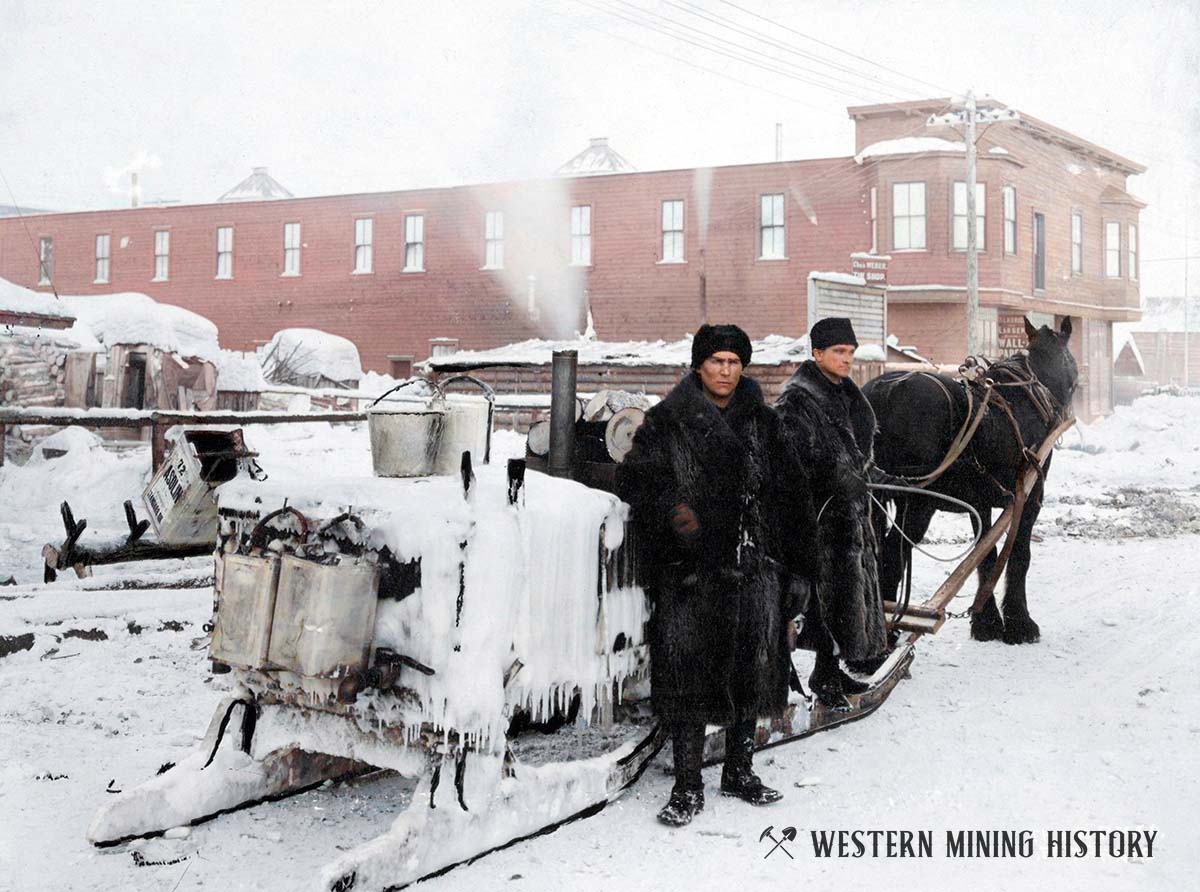
Citizens of the West’s northernmost major mining city had unique problems to overcome in their daily lives. Depicted above is a water wagon (or sleigh) that was used to melt ice for the purpose of delivering water to the residents and businesses of Fairbanks, Alaska.
More Photo Collections from Western Mining History
The following collections capture more of the West’s amazing mining history:
A Collection of Arizona Mining Photos
A Collection of Arizona Mining Photos highlights some of the best historic scenes from various Arizona districts during the peak mining years between the 1870s and the 1920s.
50 Incredible Photos of Colorado Mining Scenes
Colorado’s spectacular scenery and the richness of the state’s mines attracted many of the top photographers working at the time. These are some of the most incredible mining scenes from the state of Colorado: 50 Incredible Photos of Colorado Mining Scenes
The Comstock Lode: Nevada’s Big Bonanza
The Comstock Lode was the West’s first great silver mining district. Photos of the towns, mines, and mills are available at The Comstock Lode: Nevada’s Big Bonanza
A Collection of Nevada Mining Photos
The first mines in Nevada were discovered in the 1850s, and by the 1860s new districts were being discovered throughout the state. Nevada would first be known as the “Silver State” but would eventually become the largest gold producing state in the Nation. These are some of the best historical photos from Nevada’s notable mining districts: A Collection of Nevada Mining Photos
